Abstract Painting and Artistic Thought
VerifiedAdded on 2020/04/21
|49
|8681
|38
AI Summary
This assignment delves into the intriguing relationship between thought processes and the creation of abstract art. It examines how artists utilize both intuitive and rational thinking to construct their abstract paintings, highlighting the complexities and influences that shape this creative endeavor.
Contribute Materials
Your contribution can guide someone’s learning journey. Share your
documents today.
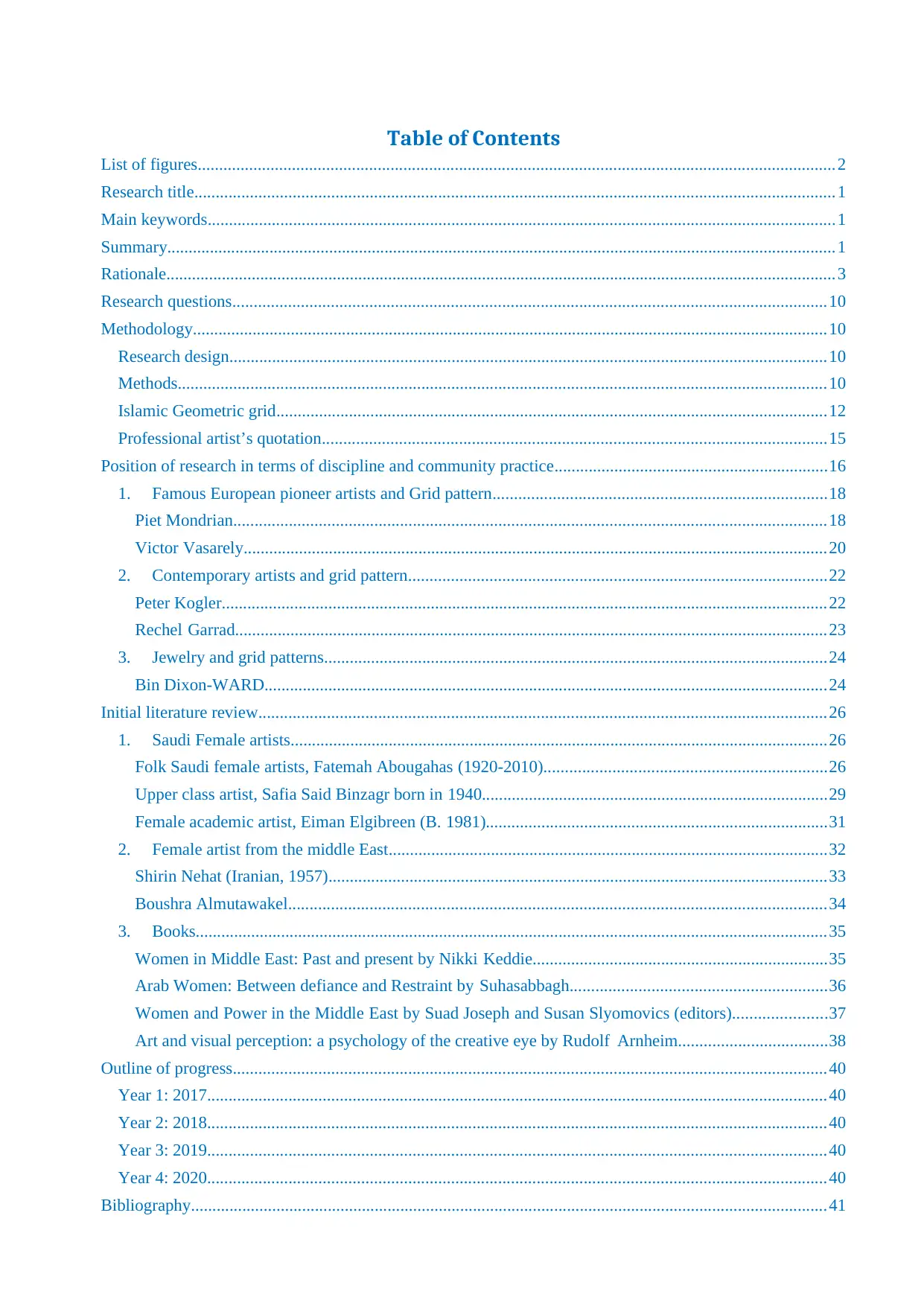
Table of Contents
List of figures.....................................................................................................................................................2
Research title......................................................................................................................................................1
Main keywords...................................................................................................................................................1
Summary.............................................................................................................................................................1
Rationale.............................................................................................................................................................3
Research questions...........................................................................................................................................10
Methodology.....................................................................................................................................................10
Research design............................................................................................................................................10
Methods........................................................................................................................................................10
Islamic Geometric grid.................................................................................................................................12
Professional artist’s quotation......................................................................................................................15
Position of research in terms of discipline and community practice................................................................16
1. Famous European pioneer artists and Grid pattern..............................................................................18
Piet Mondrian...........................................................................................................................................18
Victor Vasarely.........................................................................................................................................20
2. Contemporary artists and grid pattern..................................................................................................22
Peter Kogler..............................................................................................................................................22
Rechel Garrad...........................................................................................................................................23
3. Jewelry and grid patterns......................................................................................................................24
Bin Dixon-WARD....................................................................................................................................24
Initial literature review.....................................................................................................................................26
1. Saudi Female artists..............................................................................................................................26
Folk Saudi female artists, Fatemah Abougahas (1920-2010)..................................................................26
Upper class artist, Safia Said Binzagr born in 1940.................................................................................29
Female academic artist, Eiman Elgibreen (B. 1981)................................................................................31
2. Female artist from the middle East.......................................................................................................32
Shirin Nehat (Iranian, 1957).....................................................................................................................33
Boushra Almutawakel..............................................................................................................................34
3. Books....................................................................................................................................................35
Women in Middle East: Past and present by Nikki Keddie.....................................................................35
Arab Women: Between defiance and Restraint by Suhasabbagh............................................................36
Women and Power in the Middle East by Suad Joseph and Susan Slyomovics (editors)......................37
Art and visual perception: a psychology of the creative eye by Rudolf Arnheim...................................38
Outline of progress...........................................................................................................................................40
Year 1: 2017.................................................................................................................................................40
Year 2: 2018.................................................................................................................................................40
Year 3: 2019.................................................................................................................................................40
Year 4: 2020.................................................................................................................................................40
Bibliography.....................................................................................................................................................41
List of figures.....................................................................................................................................................2
Research title......................................................................................................................................................1
Main keywords...................................................................................................................................................1
Summary.............................................................................................................................................................1
Rationale.............................................................................................................................................................3
Research questions...........................................................................................................................................10
Methodology.....................................................................................................................................................10
Research design............................................................................................................................................10
Methods........................................................................................................................................................10
Islamic Geometric grid.................................................................................................................................12
Professional artist’s quotation......................................................................................................................15
Position of research in terms of discipline and community practice................................................................16
1. Famous European pioneer artists and Grid pattern..............................................................................18
Piet Mondrian...........................................................................................................................................18
Victor Vasarely.........................................................................................................................................20
2. Contemporary artists and grid pattern..................................................................................................22
Peter Kogler..............................................................................................................................................22
Rechel Garrad...........................................................................................................................................23
3. Jewelry and grid patterns......................................................................................................................24
Bin Dixon-WARD....................................................................................................................................24
Initial literature review.....................................................................................................................................26
1. Saudi Female artists..............................................................................................................................26
Folk Saudi female artists, Fatemah Abougahas (1920-2010)..................................................................26
Upper class artist, Safia Said Binzagr born in 1940.................................................................................29
Female academic artist, Eiman Elgibreen (B. 1981)................................................................................31
2. Female artist from the middle East.......................................................................................................32
Shirin Nehat (Iranian, 1957).....................................................................................................................33
Boushra Almutawakel..............................................................................................................................34
3. Books....................................................................................................................................................35
Women in Middle East: Past and present by Nikki Keddie.....................................................................35
Arab Women: Between defiance and Restraint by Suhasabbagh............................................................36
Women and Power in the Middle East by Suad Joseph and Susan Slyomovics (editors)......................37
Art and visual perception: a psychology of the creative eye by Rudolf Arnheim...................................38
Outline of progress...........................................................................................................................................40
Year 1: 2017.................................................................................................................................................40
Year 2: 2018.................................................................................................................................................40
Year 3: 2019.................................................................................................................................................40
Year 4: 2020.................................................................................................................................................40
Bibliography.....................................................................................................................................................41
Secure Best Marks with AI Grader
Need help grading? Try our AI Grader for instant feedback on your assignments.
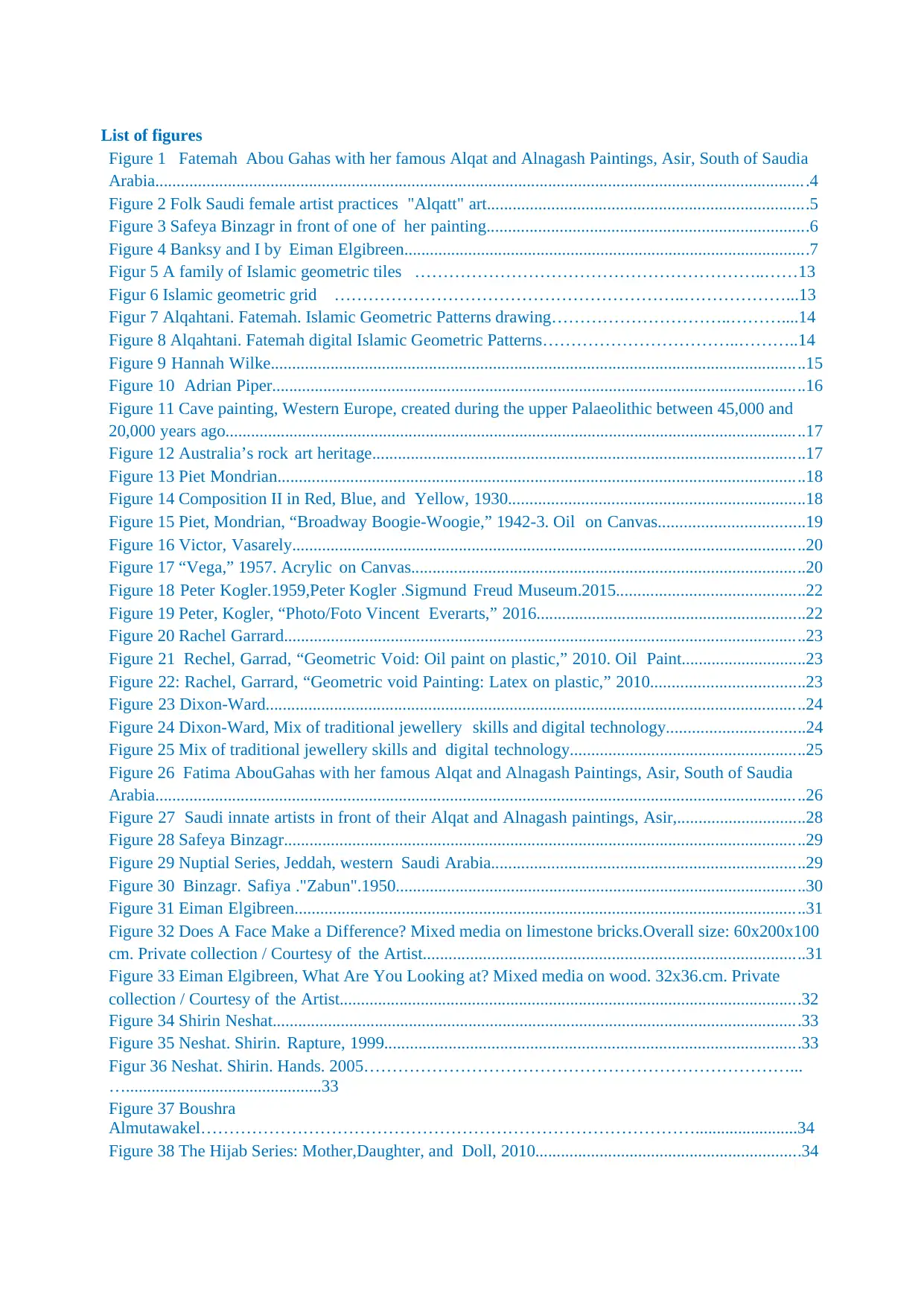
List of figures
Figure 1 Fatemah Abou Gahas with her famous Alqat and Alnagash Paintings, Asir, South of Saudia
Arabia.........................................................................................................................................................4
Figure 2 Folk Saudi female artist practices "Alqatt" art...........................................................................5
Figure 3 Safeya Binzagr in front of one of her painting...........................................................................6
Figure 4 Banksy and I by Eiman Elgibreen...............................................................................................7
Figur 5 A family of Islamic geometric tiles ……………………………………………………..……13
Figur 6 Islamic geometric grid ……………………………………………………..………………...13
Figur 7 Alqahtani. Fatemah. Islamic Geometric Patterns drawing…………………………..………....14
Figure 8 Alqahtani. Fatemah digital Islamic Geometric Patterns……………………………..………..14
Figure 9 Hannah Wilke.............................................................................................................................15
Figure 10 Adrian Piper.............................................................................................................................16
Figure 11 Cave painting, Western Europe, created during the upper Palaeolithic between 45,000 and
20,000 years ago........................................................................................................................................17
Figure 12 Australia’s rock art heritage.....................................................................................................17
Figure 13 Piet Mondrian...........................................................................................................................18
Figure 14 Composition II in Red, Blue, and Yellow, 1930.....................................................................18
Figure 15 Piet, Mondrian, “Broadway Boogie-Woogie,” 1942-3. Oil on Canvas..................................19
Figure 16 Victor, Vasarely........................................................................................................................20
Figure 17 “Vega,” 1957. Acrylic on Canvas............................................................................................20
Figure 18 Peter Kogler.1959,Peter Kogler .Sigmund Freud Museum.2015............................................22
Figure 19 Peter, Kogler, “Photo/Foto Vincent Everarts,” 2016...............................................................22
Figure 20 Rachel Garrard..........................................................................................................................23
Figure 21 Rechel, Garrad, “Geometric Void: Oil paint on plastic,” 2010. Oil Paint.............................23
Figure 22: Rachel, Garrard, “Geometric void Painting: Latex on plastic,” 2010....................................23
Figure 23 Dixon-Ward..............................................................................................................................24
Figure 24 Dixon-Ward, Mix of traditional jewellery skills and digital technology................................24
Figure 25 Mix of traditional jewellery skills and digital technology.......................................................25
Figure 26 Fatima AbouGahas with her famous Alqat and Alnagash Paintings, Asir, South of Saudia
Arabia........................................................................................................................................................26
Figure 27 Saudi innate artists in front of their Alqat and Alnagash paintings, Asir,..............................28
Figure 28 Safeya Binzagr..........................................................................................................................29
Figure 29 Nuptial Series, Jeddah, western Saudi Arabia.........................................................................29
Figure 30 Binzagr. Safiya ."Zabun".1950................................................................................................30
Figure 31 Eiman Elgibreen.......................................................................................................................31
Figure 32 Does A Face Make a Difference? Mixed media on limestone bricks.Overall size: 60x200x100
cm. Private collection / Courtesy of the Artist.........................................................................................31
Figure 33 Eiman Elgibreen, What Are You Looking at? Mixed media on wood. 32x36.cm. Private
collection / Courtesy of the Artist............................................................................................................32
Figure 34 Shirin Neshat............................................................................................................................33
Figure 35 Neshat. Shirin. Rapture, 1999.................................................................................................33
Figur 36 Neshat. Shirin. Hands. 2005…………………………………………………………………...
…..............................................33
Figure 37 Boushra
Almutawakel……………………………………………………………………………........................34
Figure 38 The Hijab Series: Mother,Daughter, and Doll, 2010..............................................................34
Figure 1 Fatemah Abou Gahas with her famous Alqat and Alnagash Paintings, Asir, South of Saudia
Arabia.........................................................................................................................................................4
Figure 2 Folk Saudi female artist practices "Alqatt" art...........................................................................5
Figure 3 Safeya Binzagr in front of one of her painting...........................................................................6
Figure 4 Banksy and I by Eiman Elgibreen...............................................................................................7
Figur 5 A family of Islamic geometric tiles ……………………………………………………..……13
Figur 6 Islamic geometric grid ……………………………………………………..………………...13
Figur 7 Alqahtani. Fatemah. Islamic Geometric Patterns drawing…………………………..………....14
Figure 8 Alqahtani. Fatemah digital Islamic Geometric Patterns……………………………..………..14
Figure 9 Hannah Wilke.............................................................................................................................15
Figure 10 Adrian Piper.............................................................................................................................16
Figure 11 Cave painting, Western Europe, created during the upper Palaeolithic between 45,000 and
20,000 years ago........................................................................................................................................17
Figure 12 Australia’s rock art heritage.....................................................................................................17
Figure 13 Piet Mondrian...........................................................................................................................18
Figure 14 Composition II in Red, Blue, and Yellow, 1930.....................................................................18
Figure 15 Piet, Mondrian, “Broadway Boogie-Woogie,” 1942-3. Oil on Canvas..................................19
Figure 16 Victor, Vasarely........................................................................................................................20
Figure 17 “Vega,” 1957. Acrylic on Canvas............................................................................................20
Figure 18 Peter Kogler.1959,Peter Kogler .Sigmund Freud Museum.2015............................................22
Figure 19 Peter, Kogler, “Photo/Foto Vincent Everarts,” 2016...............................................................22
Figure 20 Rachel Garrard..........................................................................................................................23
Figure 21 Rechel, Garrad, “Geometric Void: Oil paint on plastic,” 2010. Oil Paint.............................23
Figure 22: Rachel, Garrard, “Geometric void Painting: Latex on plastic,” 2010....................................23
Figure 23 Dixon-Ward..............................................................................................................................24
Figure 24 Dixon-Ward, Mix of traditional jewellery skills and digital technology................................24
Figure 25 Mix of traditional jewellery skills and digital technology.......................................................25
Figure 26 Fatima AbouGahas with her famous Alqat and Alnagash Paintings, Asir, South of Saudia
Arabia........................................................................................................................................................26
Figure 27 Saudi innate artists in front of their Alqat and Alnagash paintings, Asir,..............................28
Figure 28 Safeya Binzagr..........................................................................................................................29
Figure 29 Nuptial Series, Jeddah, western Saudi Arabia.........................................................................29
Figure 30 Binzagr. Safiya ."Zabun".1950................................................................................................30
Figure 31 Eiman Elgibreen.......................................................................................................................31
Figure 32 Does A Face Make a Difference? Mixed media on limestone bricks.Overall size: 60x200x100
cm. Private collection / Courtesy of the Artist.........................................................................................31
Figure 33 Eiman Elgibreen, What Are You Looking at? Mixed media on wood. 32x36.cm. Private
collection / Courtesy of the Artist............................................................................................................32
Figure 34 Shirin Neshat............................................................................................................................33
Figure 35 Neshat. Shirin. Rapture, 1999.................................................................................................33
Figur 36 Neshat. Shirin. Hands. 2005…………………………………………………………………...
…..............................................33
Figure 37 Boushra
Almutawakel……………………………………………………………………………........................34
Figure 38 The Hijab Series: Mother,Daughter, and Doll, 2010..............................................................34
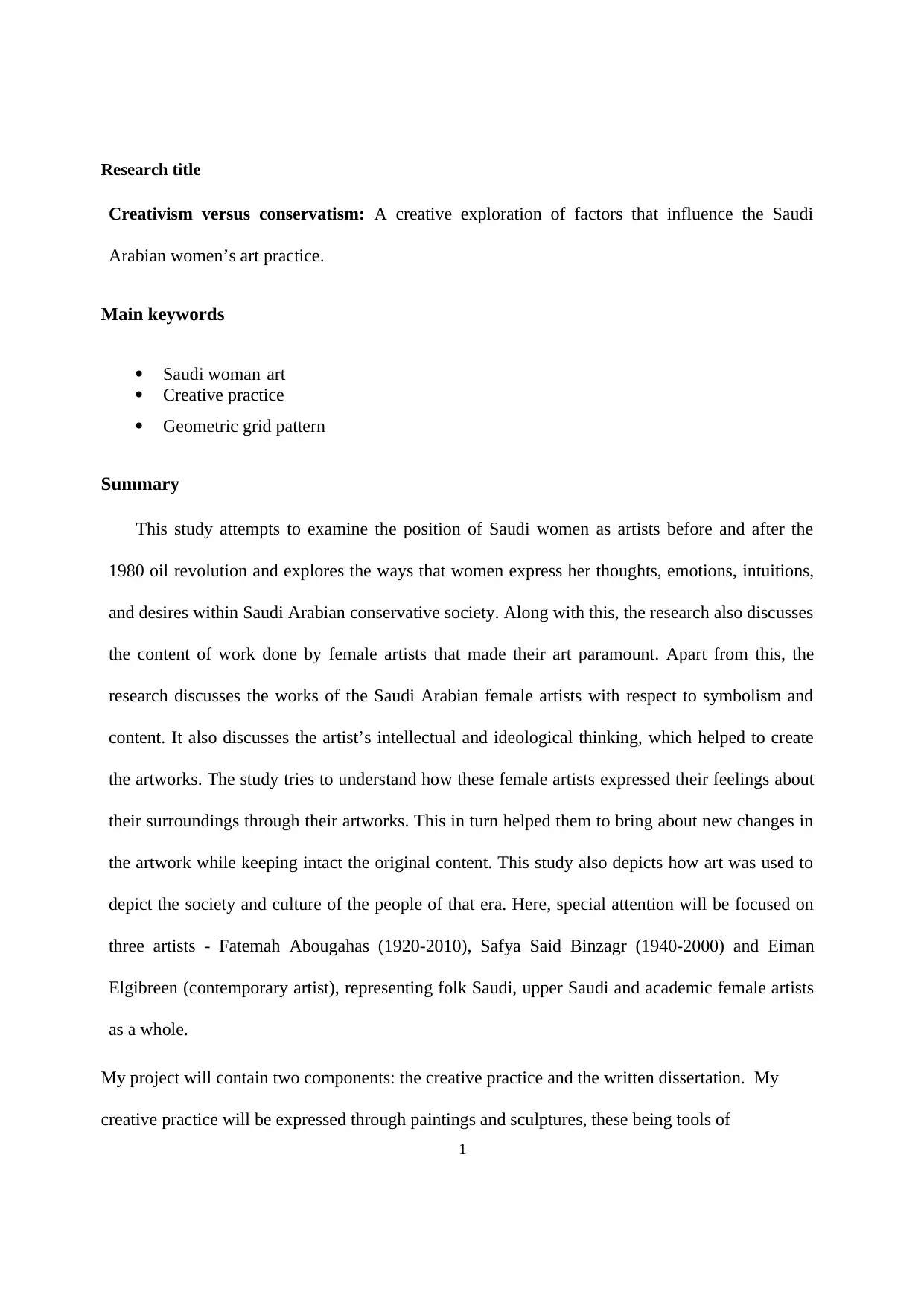
Research title
Creativism versus conservatism: A creative exploration of factors that influence the Saudi
Arabian women’s art practice.
Main keywords
Saudi woman art
Creative practice
Geometric grid pattern
Summary
This study attempts to examine the position of Saudi women as artists before and after the
1980 oil revolution and explores the ways that women express her thoughts, emotions, intuitions,
and desires within Saudi Arabian conservative society. Along with this, the research also discusses
the content of work done by female artists that made their art paramount. Apart from this, the
research discusses the works of the Saudi Arabian female artists with respect to symbolism and
content. It also discusses the artist’s intellectual and ideological thinking, which helped to create
the artworks. The study tries to understand how these female artists expressed their feelings about
their surroundings through their artworks. This in turn helped them to bring about new changes in
the artwork while keeping intact the original content. This study also depicts how art was used to
depict the society and culture of the people of that era. Here, special attention will be focused on
three artists - Fatemah Abougahas (1920-2010), Safya Said Binzagr (1940-2000) and Eiman
Elgibreen (contemporary artist), representing folk Saudi, upper Saudi and academic female artists
as a whole.
My project will contain two components: the creative practice and the written dissertation. My
creative practice will be expressed through paintings and sculptures, these being tools of
1
Creativism versus conservatism: A creative exploration of factors that influence the Saudi
Arabian women’s art practice.
Main keywords
Saudi woman art
Creative practice
Geometric grid pattern
Summary
This study attempts to examine the position of Saudi women as artists before and after the
1980 oil revolution and explores the ways that women express her thoughts, emotions, intuitions,
and desires within Saudi Arabian conservative society. Along with this, the research also discusses
the content of work done by female artists that made their art paramount. Apart from this, the
research discusses the works of the Saudi Arabian female artists with respect to symbolism and
content. It also discusses the artist’s intellectual and ideological thinking, which helped to create
the artworks. The study tries to understand how these female artists expressed their feelings about
their surroundings through their artworks. This in turn helped them to bring about new changes in
the artwork while keeping intact the original content. This study also depicts how art was used to
depict the society and culture of the people of that era. Here, special attention will be focused on
three artists - Fatemah Abougahas (1920-2010), Safya Said Binzagr (1940-2000) and Eiman
Elgibreen (contemporary artist), representing folk Saudi, upper Saudi and academic female artists
as a whole.
My project will contain two components: the creative practice and the written dissertation. My
creative practice will be expressed through paintings and sculptures, these being tools of
1

investigation and the outcomes of inquiry into the work and characteristics of Saudi female art. Both
context and commentary model will be used to emphasize the relationships between artworks and
written dissertations. In the context model the exegesis performs the role of contextualizing text. The
commentary model focuses on the creative process and the creative works1. The paintings, digital
designs and sculptures will be the main components in focusing this dissertation, which will
involve the integration of concurrent theoretical investigations and studio developments. The
artifacts will be used as a manifestation of the experience of women artists in my native country of
Saudi Arabia.
The methodology of this study is based on the principles of action research and will take a
cyclic approach involving four steps of planning (visualization), acting (practices), observing
(impact), as well as reflecting (results) based on the developments of the studio practices. The
context model will be incorporated in my critical analysis of artworks by Saudi women2. The
context model will ensure that the information is well organized, and expressed in a simple and
structured manner to better understand the content as an interpretive method of inquiry into the
understanding of the nature and spirit of Saudi woman art3.
1 Milech, B.H. &Schilo, A. (2004). ‘Exit Jesis’: relating the exegesis and the creative/production components of
a research thesis. TEXT, special issue No 3.Retrieved July 2, 2008, from
http://www.textjournal.com.au/speciss/issue3/milechschilo.htm.
2 Milech, B.H. &Schilo, A. (2004). ‘Exit Jesis’: relating the exegesis and the creative/production components of
a research thesis. TEXT, special issue No 3.Retrieved July 2, 2008, from
http://www.textjournal.com.au/speciss/issue3/milechschilo.htm.
According to (Milech and Schilo 2004) the commentary model is “explanatory annotation” and focuses on the
creative process and the creative works. Its a reflexive, personal and subjective account by the researcher, who
speaks as an insider who draws on what they uniquely know and have experienced in relation to their creative
works and processes.
3 Chen, Qiang, Zheng Song, Jian Dong, Zhongyang Huang, Yang Hua, and Shuicheng Yan. "Contextualizing
object detection and classification." IEEE transactions on pattern analysis and machine intelligence 37, no. 1
(2015): 13-27.
2
context and commentary model will be used to emphasize the relationships between artworks and
written dissertations. In the context model the exegesis performs the role of contextualizing text. The
commentary model focuses on the creative process and the creative works1. The paintings, digital
designs and sculptures will be the main components in focusing this dissertation, which will
involve the integration of concurrent theoretical investigations and studio developments. The
artifacts will be used as a manifestation of the experience of women artists in my native country of
Saudi Arabia.
The methodology of this study is based on the principles of action research and will take a
cyclic approach involving four steps of planning (visualization), acting (practices), observing
(impact), as well as reflecting (results) based on the developments of the studio practices. The
context model will be incorporated in my critical analysis of artworks by Saudi women2. The
context model will ensure that the information is well organized, and expressed in a simple and
structured manner to better understand the content as an interpretive method of inquiry into the
understanding of the nature and spirit of Saudi woman art3.
1 Milech, B.H. &Schilo, A. (2004). ‘Exit Jesis’: relating the exegesis and the creative/production components of
a research thesis. TEXT, special issue No 3.Retrieved July 2, 2008, from
http://www.textjournal.com.au/speciss/issue3/milechschilo.htm.
2 Milech, B.H. &Schilo, A. (2004). ‘Exit Jesis’: relating the exegesis and the creative/production components of
a research thesis. TEXT, special issue No 3.Retrieved July 2, 2008, from
http://www.textjournal.com.au/speciss/issue3/milechschilo.htm.
According to (Milech and Schilo 2004) the commentary model is “explanatory annotation” and focuses on the
creative process and the creative works. Its a reflexive, personal and subjective account by the researcher, who
speaks as an insider who draws on what they uniquely know and have experienced in relation to their creative
works and processes.
3 Chen, Qiang, Zheng Song, Jian Dong, Zhongyang Huang, Yang Hua, and Shuicheng Yan. "Contextualizing
object detection and classification." IEEE transactions on pattern analysis and machine intelligence 37, no. 1
(2015): 13-27.
2
Secure Best Marks with AI Grader
Need help grading? Try our AI Grader for instant feedback on your assignments.
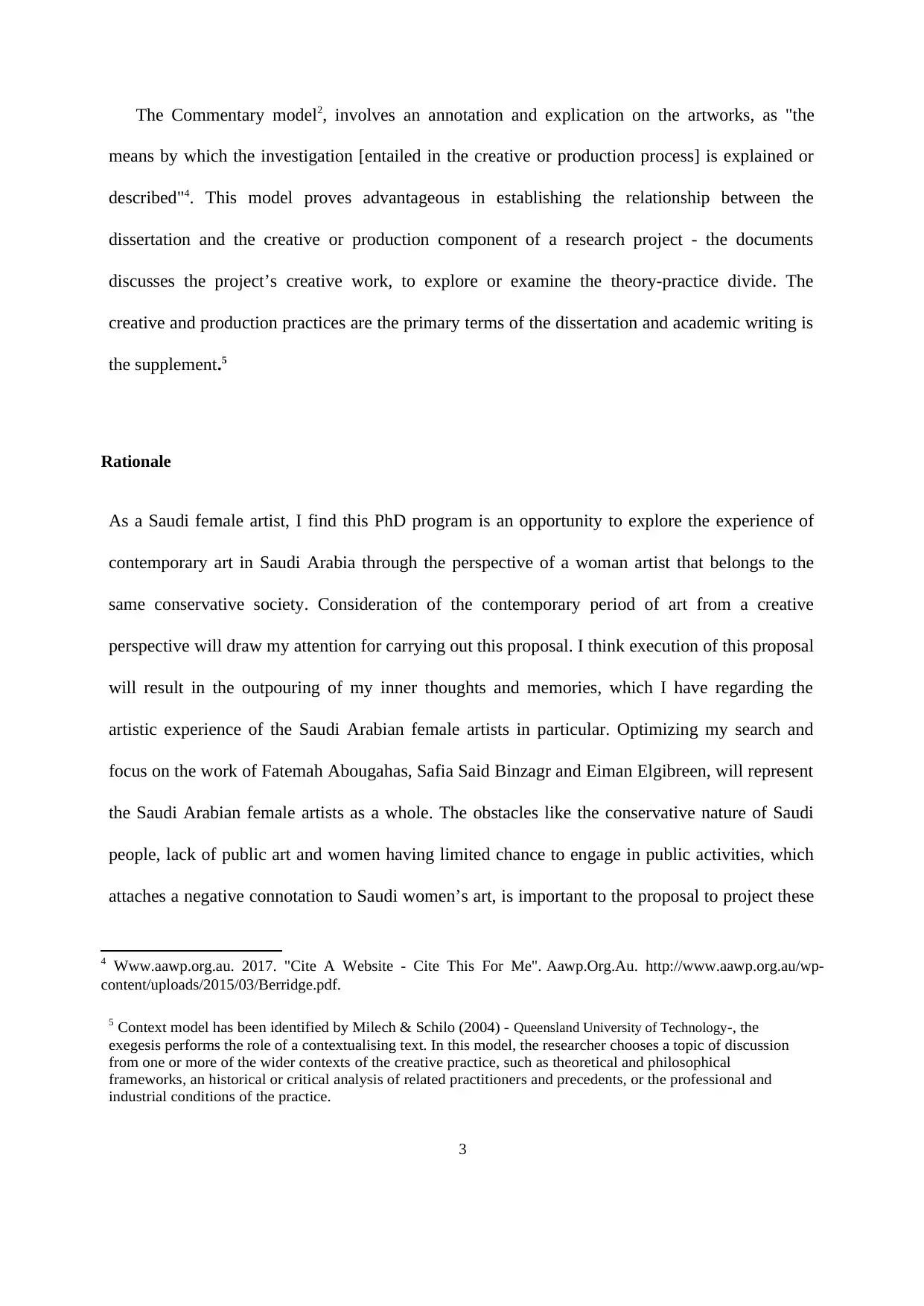
The Commentary model2, involves an annotation and explication on the artworks, as "the
means by which the investigation [entailed in the creative or production process] is explained or
described"4. This model proves advantageous in establishing the relationship between the
dissertation and the creative or production component of a research project - the documents
discusses the project’s creative work, to explore or examine the theory-practice divide. The
creative and production practices are the primary terms of the dissertation and academic writing is
the supplement.5
Rationale
As a Saudi female artist, I find this PhD program is an opportunity to explore the experience of
contemporary art in Saudi Arabia through the perspective of a woman artist that belongs to the
same conservative society. Consideration of the contemporary period of art from a creative
perspective will draw my attention for carrying out this proposal. I think execution of this proposal
will result in the outpouring of my inner thoughts and memories, which I have regarding the
artistic experience of the Saudi Arabian female artists in particular. Optimizing my search and
focus on the work of Fatemah Abougahas, Safia Said Binzagr and Eiman Elgibreen, will represent
the Saudi Arabian female artists as a whole. The obstacles like the conservative nature of Saudi
people, lack of public art and women having limited chance to engage in public activities, which
attaches a negative connotation to Saudi women’s art, is important to the proposal to project these
4 Www.aawp.org.au. 2017. "Cite A Website - Cite This For Me". Aawp.Org.Au. http://www.aawp.org.au/wp-
content/uploads/2015/03/Berridge.pdf.
5 Context model has been identified by Milech & Schilo (2004) - Queensland University of Technology -, the
exegesis performs the role of a contextualising text. In this model, the researcher chooses a topic of discussion
from one or more of the wider contexts of the creative practice, such as theoretical and philosophical
frameworks, an historical or critical analysis of related practitioners and precedents, or the professional and
industrial conditions of the practice.
3
means by which the investigation [entailed in the creative or production process] is explained or
described"4. This model proves advantageous in establishing the relationship between the
dissertation and the creative or production component of a research project - the documents
discusses the project’s creative work, to explore or examine the theory-practice divide. The
creative and production practices are the primary terms of the dissertation and academic writing is
the supplement.5
Rationale
As a Saudi female artist, I find this PhD program is an opportunity to explore the experience of
contemporary art in Saudi Arabia through the perspective of a woman artist that belongs to the
same conservative society. Consideration of the contemporary period of art from a creative
perspective will draw my attention for carrying out this proposal. I think execution of this proposal
will result in the outpouring of my inner thoughts and memories, which I have regarding the
artistic experience of the Saudi Arabian female artists in particular. Optimizing my search and
focus on the work of Fatemah Abougahas, Safia Said Binzagr and Eiman Elgibreen, will represent
the Saudi Arabian female artists as a whole. The obstacles like the conservative nature of Saudi
people, lack of public art and women having limited chance to engage in public activities, which
attaches a negative connotation to Saudi women’s art, is important to the proposal to project these
4 Www.aawp.org.au. 2017. "Cite A Website - Cite This For Me". Aawp.Org.Au. http://www.aawp.org.au/wp-
content/uploads/2015/03/Berridge.pdf.
5 Context model has been identified by Milech & Schilo (2004) - Queensland University of Technology -, the
exegesis performs the role of a contextualising text. In this model, the researcher chooses a topic of discussion
from one or more of the wider contexts of the creative practice, such as theoretical and philosophical
frameworks, an historical or critical analysis of related practitioners and precedents, or the professional and
industrial conditions of the practice.
3
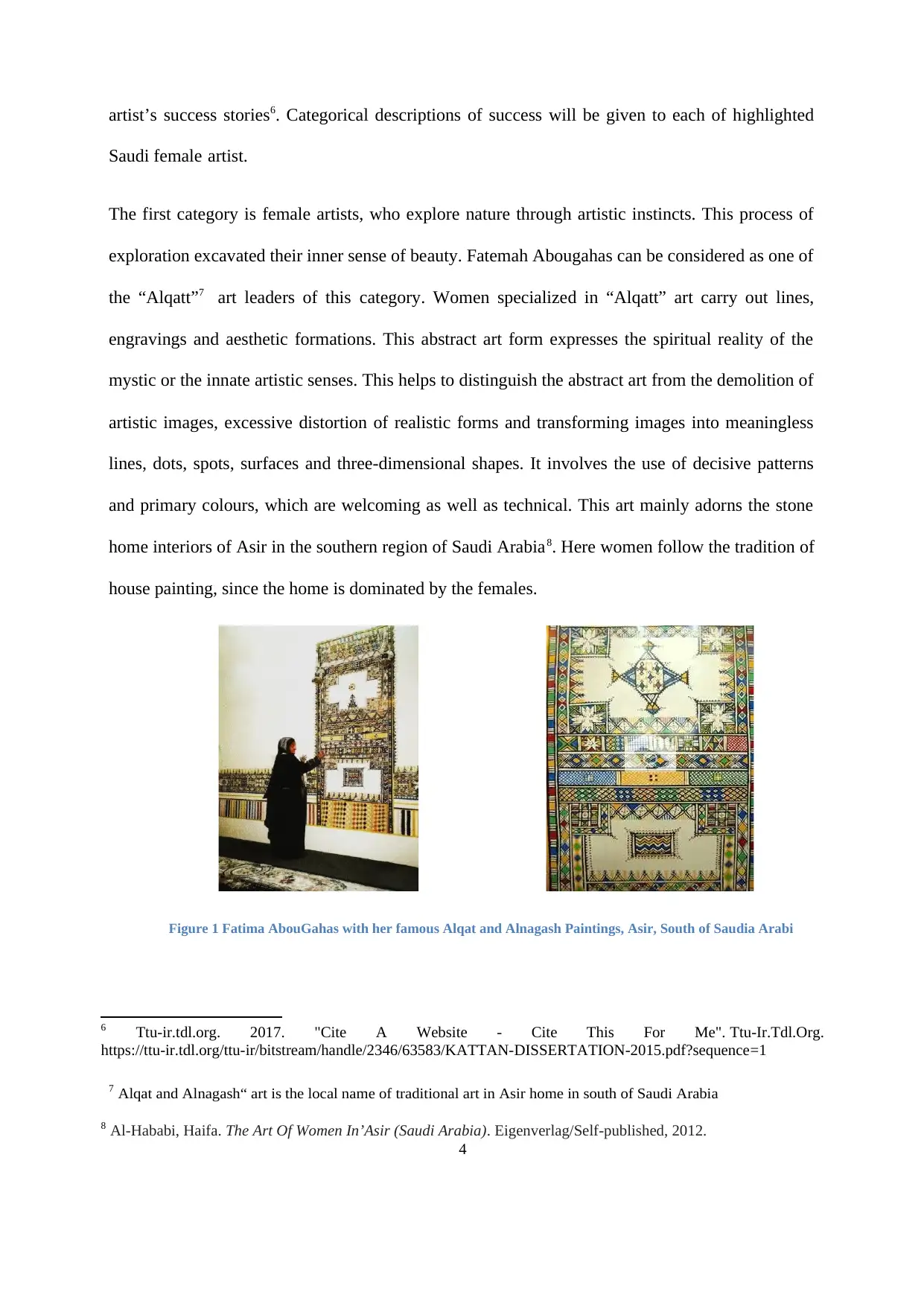
artist’s success stories6. Categorical descriptions of success will be given to each of highlighted
Saudi female artist.
The first category is female artists, who explore nature through artistic instincts. This process of
exploration excavated their inner sense of beauty. Fatemah Abougahas can be considered as one of
the “Alqatt”7 art leaders of this category. Women specialized in “Alqatt” art carry out lines,
engravings and aesthetic formations. This abstract art form expresses the spiritual reality of the
mystic or the innate artistic senses. This helps to distinguish the abstract art from the demolition of
artistic images, excessive distortion of realistic forms and transforming images into meaningless
lines, dots, spots, surfaces and three-dimensional shapes. It involves the use of decisive patterns
and primary colours, which are welcoming as well as technical. This art mainly adorns the stone
home interiors of Asir in the southern region of Saudi Arabia8. Here women follow the tradition of
house painting, since the home is dominated by the females.
6 Ttu-ir.tdl.org. 2017. "Cite A Website - Cite This For Me". Ttu-Ir.Tdl.Org.
https://ttu-ir.tdl.org/ttu-ir/bitstream/handle/2346/63583/KATTAN-DISSERTATION-2015.pdf?sequence=1
7 Alqat and Alnagash“ art is the local name of traditional art in Asir home in south of Saudi Arabia
8 Al-Hababi, Haifa. The Art Of Women In’Asir (Saudi Arabia). Eigenverlag/Self-published, 2012.
4
Figure 1 Fatima AbouGahas with her famous Alqat and Alnagash Paintings, Asir, South of Saudia Arabi
Saudi female artist.
The first category is female artists, who explore nature through artistic instincts. This process of
exploration excavated their inner sense of beauty. Fatemah Abougahas can be considered as one of
the “Alqatt”7 art leaders of this category. Women specialized in “Alqatt” art carry out lines,
engravings and aesthetic formations. This abstract art form expresses the spiritual reality of the
mystic or the innate artistic senses. This helps to distinguish the abstract art from the demolition of
artistic images, excessive distortion of realistic forms and transforming images into meaningless
lines, dots, spots, surfaces and three-dimensional shapes. It involves the use of decisive patterns
and primary colours, which are welcoming as well as technical. This art mainly adorns the stone
home interiors of Asir in the southern region of Saudi Arabia8. Here women follow the tradition of
house painting, since the home is dominated by the females.
6 Ttu-ir.tdl.org. 2017. "Cite A Website - Cite This For Me". Ttu-Ir.Tdl.Org.
https://ttu-ir.tdl.org/ttu-ir/bitstream/handle/2346/63583/KATTAN-DISSERTATION-2015.pdf?sequence=1
7 Alqat and Alnagash“ art is the local name of traditional art in Asir home in south of Saudi Arabia
8 Al-Hababi, Haifa. The Art Of Women In’Asir (Saudi Arabia). Eigenverlag/Self-published, 2012.
4
Figure 1 Fatima AbouGahas with her famous Alqat and Alnagash Paintings, Asir, South of Saudia Arabi
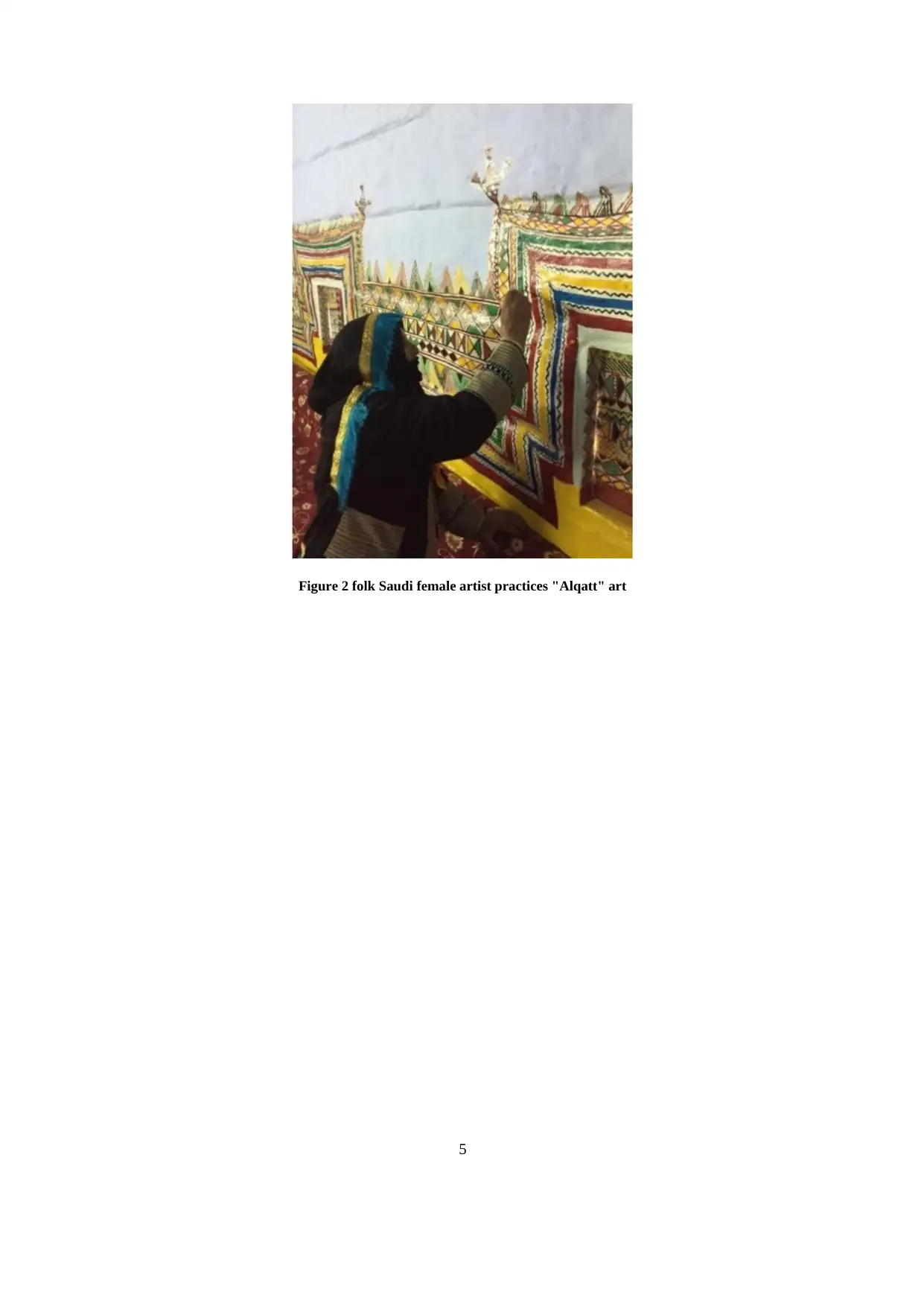
Figure 2 folk Saudi female artist practices "Alqatt" art
5
5
Paraphrase This Document
Need a fresh take? Get an instant paraphrase of this document with our AI Paraphraser

The Saudi oil revolution9 of 1938 enhanced the social and economic support for female artists
through art works10. The oil discovery was an added advantage for them in terms as if they were
portraying their inner thoughts, emotions and feelings through the means of paintbrush. One of the
mentionable names here is Safia Said Binzagr11. Binzagr was born in an established merchant
family located in Jeddah in the year 1940. She learnt art from Egypt and earned a degree from St
Martin’s School of Art in 1965.
She was influenced by artists like Giotto Fra Angelico and Cezanne but later on developed her own
independent style, which were adapted from her heritage. Binzagr uses oil paints to pastels,
watercolors, etchings and drawings. Her work depicts the daily lives of the people of Saudi Arabia.
9 Saudi Arabian oil was first discovered by the Americans in commercial quantities at Dammam oil well No. 7 in
1938 in what is now modern Dhahran city.
10 Ulrichsen, Kristian Coates. "The Gulf and the Global Economy." In The Gulf States in International Political
Economy, pp. 15-35. Palgrave Macmillan UK, 2016.
11Arthistory.knoji.com. 2017. "Safia Binzagr: Pioneer Of The Artistic Movement In Saudi
Arabia". Arthistory.Knoji.Com. https://arthistory.knoji.com/safia-binzagr-pioneer-of-the-artistic-movement-in-
saudi-arabia/
6
Figure 3 Safeya Binzagr in front of one of her painting
through art works10. The oil discovery was an added advantage for them in terms as if they were
portraying their inner thoughts, emotions and feelings through the means of paintbrush. One of the
mentionable names here is Safia Said Binzagr11. Binzagr was born in an established merchant
family located in Jeddah in the year 1940. She learnt art from Egypt and earned a degree from St
Martin’s School of Art in 1965.
She was influenced by artists like Giotto Fra Angelico and Cezanne but later on developed her own
independent style, which were adapted from her heritage. Binzagr uses oil paints to pastels,
watercolors, etchings and drawings. Her work depicts the daily lives of the people of Saudi Arabia.
9 Saudi Arabian oil was first discovered by the Americans in commercial quantities at Dammam oil well No. 7 in
1938 in what is now modern Dhahran city.
10 Ulrichsen, Kristian Coates. "The Gulf and the Global Economy." In The Gulf States in International Political
Economy, pp. 15-35. Palgrave Macmillan UK, 2016.
11Arthistory.knoji.com. 2017. "Safia Binzagr: Pioneer Of The Artistic Movement In Saudi
Arabia". Arthistory.Knoji.Com. https://arthistory.knoji.com/safia-binzagr-pioneer-of-the-artistic-movement-in-
saudi-arabia/
6
Figure 3 Safeya Binzagr in front of one of her painting
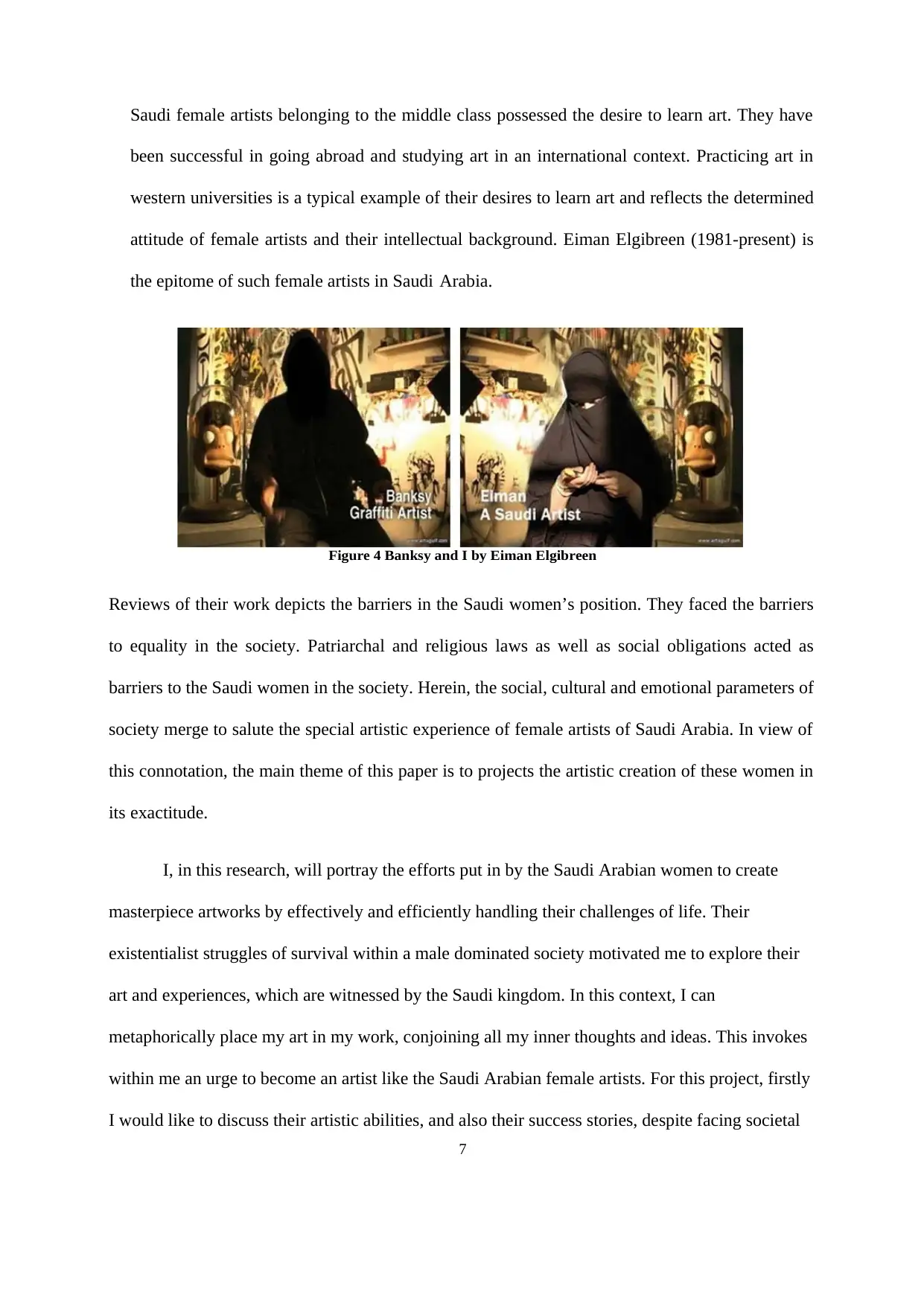
Saudi female artists belonging to the middle class possessed the desire to learn art. They have
been successful in going abroad and studying art in an international context. Practicing art in
western universities is a typical example of their desires to learn art and reflects the determined
attitude of female artists and their intellectual background. Eiman Elgibreen (1981-present) is
the epitome of such female artists in Saudi Arabia.
Figure 4 Banksy and I by Eiman Elgibreen
Reviews of their work depicts the barriers in the Saudi women’s position. They faced the barriers
to equality in the society. Patriarchal and religious laws as well as social obligations acted as
barriers to the Saudi women in the society. Herein, the social, cultural and emotional parameters of
society merge to salute the special artistic experience of female artists of Saudi Arabia. In view of
this connotation, the main theme of this paper is to projects the artistic creation of these women in
its exactitude.
I, in this research, will portray the efforts put in by the Saudi Arabian women to create
masterpiece artworks by effectively and efficiently handling their challenges of life. Their
existentialist struggles of survival within a male dominated society motivated me to explore their
art and experiences, which are witnessed by the Saudi kingdom. In this context, I can
metaphorically place my art in my work, conjoining all my inner thoughts and ideas. This invokes
within me an urge to become an artist like the Saudi Arabian female artists. For this project, firstly
I would like to discuss their artistic abilities, and also their success stories, despite facing societal
7
been successful in going abroad and studying art in an international context. Practicing art in
western universities is a typical example of their desires to learn art and reflects the determined
attitude of female artists and their intellectual background. Eiman Elgibreen (1981-present) is
the epitome of such female artists in Saudi Arabia.
Figure 4 Banksy and I by Eiman Elgibreen
Reviews of their work depicts the barriers in the Saudi women’s position. They faced the barriers
to equality in the society. Patriarchal and religious laws as well as social obligations acted as
barriers to the Saudi women in the society. Herein, the social, cultural and emotional parameters of
society merge to salute the special artistic experience of female artists of Saudi Arabia. In view of
this connotation, the main theme of this paper is to projects the artistic creation of these women in
its exactitude.
I, in this research, will portray the efforts put in by the Saudi Arabian women to create
masterpiece artworks by effectively and efficiently handling their challenges of life. Their
existentialist struggles of survival within a male dominated society motivated me to explore their
art and experiences, which are witnessed by the Saudi kingdom. In this context, I can
metaphorically place my art in my work, conjoining all my inner thoughts and ideas. This invokes
within me an urge to become an artist like the Saudi Arabian female artists. For this project, firstly
I would like to discuss their artistic abilities, and also their success stories, despite facing societal
7

and religious challenges in the Saudi Arabian community.
8
8
Secure Best Marks with AI Grader
Need help grading? Try our AI Grader for instant feedback on your assignments.
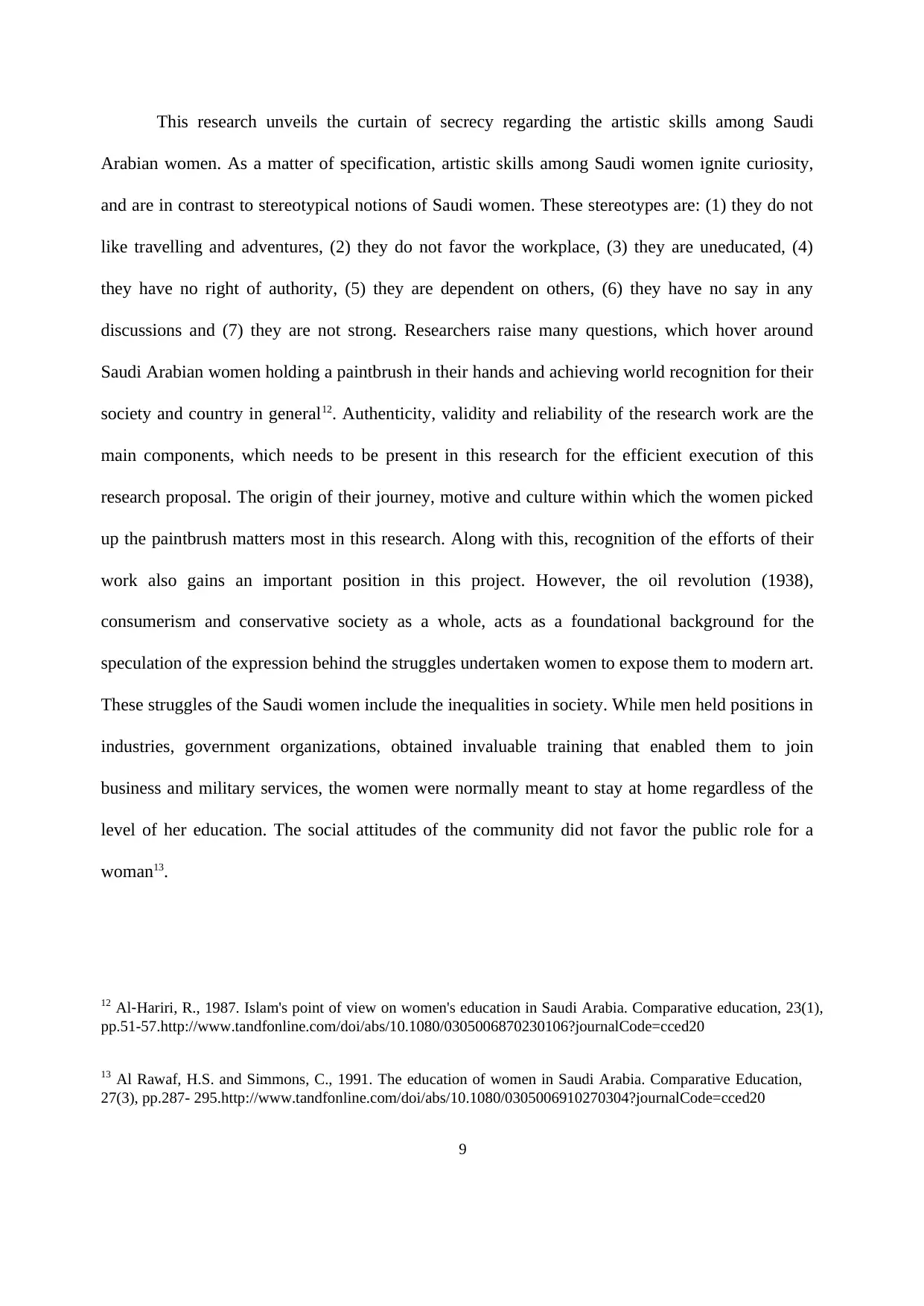
This research unveils the curtain of secrecy regarding the artistic skills among Saudi
Arabian women. As a matter of specification, artistic skills among Saudi women ignite curiosity,
and are in contrast to stereotypical notions of Saudi women. These stereotypes are: (1) they do not
like travelling and adventures, (2) they do not favor the workplace, (3) they are uneducated, (4)
they have no right of authority, (5) they are dependent on others, (6) they have no say in any
discussions and (7) they are not strong. Researchers raise many questions, which hover around
Saudi Arabian women holding a paintbrush in their hands and achieving world recognition for their
society and country in general12. Authenticity, validity and reliability of the research work are the
main components, which needs to be present in this research for the efficient execution of this
research proposal. The origin of their journey, motive and culture within which the women picked
up the paintbrush matters most in this research. Along with this, recognition of the efforts of their
work also gains an important position in this project. However, the oil revolution (1938),
consumerism and conservative society as a whole, acts as a foundational background for the
speculation of the expression behind the struggles undertaken women to expose them to modern art.
These struggles of the Saudi women include the inequalities in society. While men held positions in
industries, government organizations, obtained invaluable training that enabled them to join
business and military services, the women were normally meant to stay at home regardless of the
level of her education. The social attitudes of the community did not favor the public role for a
woman13.
12 Al‐Hariri, R., 1987. Islam's point of view on women's education in Saudi Arabia. Comparative education, 23(1),
pp.51-57.http://www.tandfonline.com/doi/abs/10.1080/0305006870230106?journalCode=cced20
13 Al Rawaf, H.S. and Simmons, C., 1991. The education of women in Saudi Arabia. Comparative Education,
27(3), pp.287- 295.http://www.tandfonline.com/doi/abs/10.1080/0305006910270304?journalCode=cced20
9
Arabian women. As a matter of specification, artistic skills among Saudi women ignite curiosity,
and are in contrast to stereotypical notions of Saudi women. These stereotypes are: (1) they do not
like travelling and adventures, (2) they do not favor the workplace, (3) they are uneducated, (4)
they have no right of authority, (5) they are dependent on others, (6) they have no say in any
discussions and (7) they are not strong. Researchers raise many questions, which hover around
Saudi Arabian women holding a paintbrush in their hands and achieving world recognition for their
society and country in general12. Authenticity, validity and reliability of the research work are the
main components, which needs to be present in this research for the efficient execution of this
research proposal. The origin of their journey, motive and culture within which the women picked
up the paintbrush matters most in this research. Along with this, recognition of the efforts of their
work also gains an important position in this project. However, the oil revolution (1938),
consumerism and conservative society as a whole, acts as a foundational background for the
speculation of the expression behind the struggles undertaken women to expose them to modern art.
These struggles of the Saudi women include the inequalities in society. While men held positions in
industries, government organizations, obtained invaluable training that enabled them to join
business and military services, the women were normally meant to stay at home regardless of the
level of her education. The social attitudes of the community did not favor the public role for a
woman13.
12 Al‐Hariri, R., 1987. Islam's point of view on women's education in Saudi Arabia. Comparative education, 23(1),
pp.51-57.http://www.tandfonline.com/doi/abs/10.1080/0305006870230106?journalCode=cced20
13 Al Rawaf, H.S. and Simmons, C., 1991. The education of women in Saudi Arabia. Comparative Education,
27(3), pp.287- 295.http://www.tandfonline.com/doi/abs/10.1080/0305006910270304?journalCode=cced20
9
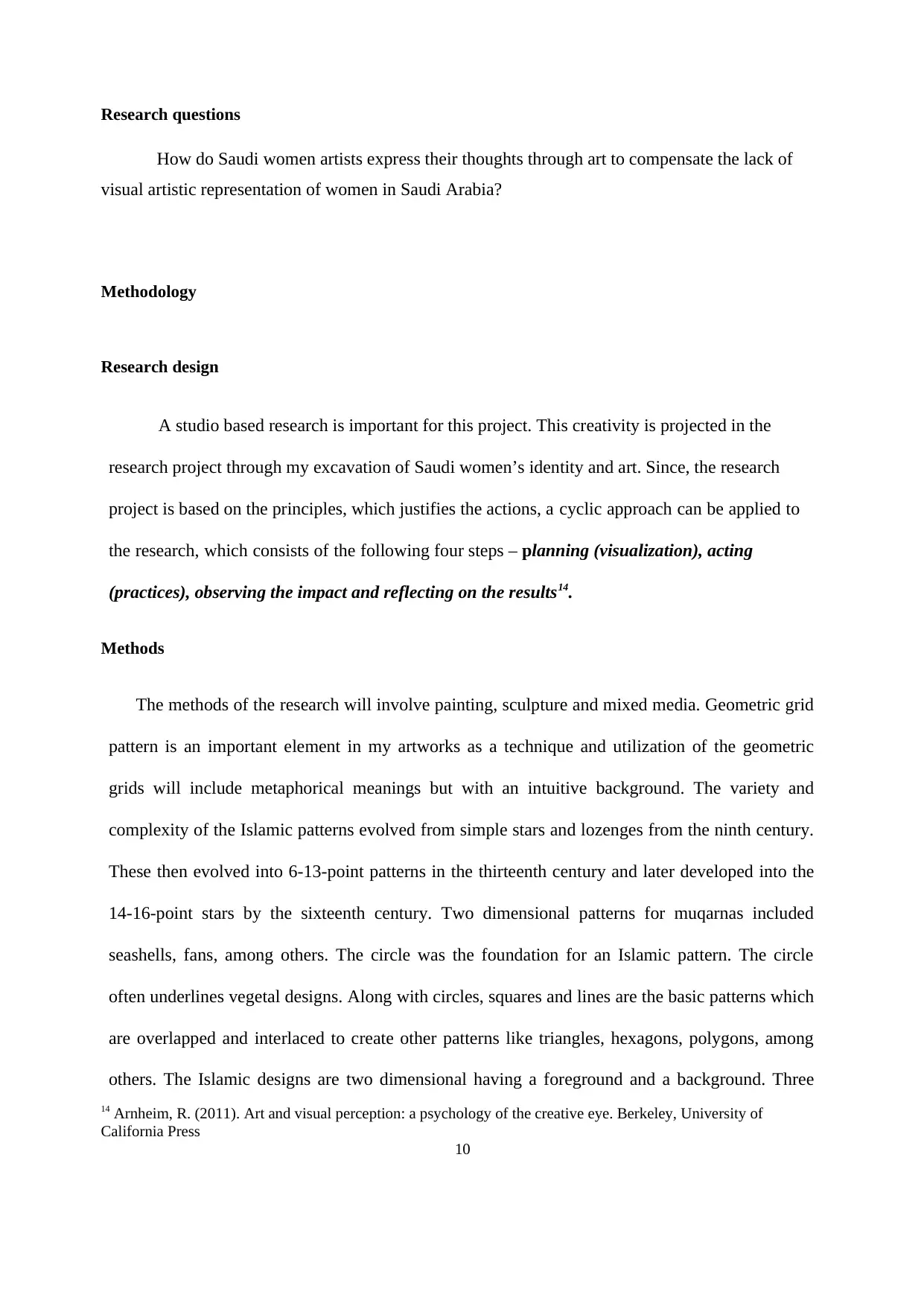
Research questions
How do Saudi women artists express their thoughts through art to compensate the lack of
visual artistic representation of women in Saudi Arabia?
Methodology
Research design
A studio based research is important for this project. This creativity is projected in the
research project through my excavation of Saudi women’s identity and art. Since, the research
project is based on the principles, which justifies the actions, a cyclic approach can be applied to
the research, which consists of the following four steps – planning (visualization), acting
(practices), observing the impact and reflecting on the results14.
Methods
The methods of the research will involve painting, sculpture and mixed media. Geometric grid
pattern is an important element in my artworks as a technique and utilization of the geometric
grids will include metaphorical meanings but with an intuitive background. The variety and
complexity of the Islamic patterns evolved from simple stars and lozenges from the ninth century.
These then evolved into 6-13-point patterns in the thirteenth century and later developed into the
14-16-point stars by the sixteenth century. Two dimensional patterns for muqarnas included
seashells, fans, among others. The circle was the foundation for an Islamic pattern. The circle
often underlines vegetal designs. Along with circles, squares and lines are the basic patterns which
are overlapped and interlaced to create other patterns like triangles, hexagons, polygons, among
others. The Islamic designs are two dimensional having a foreground and a background. Three
14 Arnheim, R. (2011). Art and visual perception: a psychology of the creative eye. Berkeley, University of
California Press
10
How do Saudi women artists express their thoughts through art to compensate the lack of
visual artistic representation of women in Saudi Arabia?
Methodology
Research design
A studio based research is important for this project. This creativity is projected in the
research project through my excavation of Saudi women’s identity and art. Since, the research
project is based on the principles, which justifies the actions, a cyclic approach can be applied to
the research, which consists of the following four steps – planning (visualization), acting
(practices), observing the impact and reflecting on the results14.
Methods
The methods of the research will involve painting, sculpture and mixed media. Geometric grid
pattern is an important element in my artworks as a technique and utilization of the geometric
grids will include metaphorical meanings but with an intuitive background. The variety and
complexity of the Islamic patterns evolved from simple stars and lozenges from the ninth century.
These then evolved into 6-13-point patterns in the thirteenth century and later developed into the
14-16-point stars by the sixteenth century. Two dimensional patterns for muqarnas included
seashells, fans, among others. The circle was the foundation for an Islamic pattern. The circle
often underlines vegetal designs. Along with circles, squares and lines are the basic patterns which
are overlapped and interlaced to create other patterns like triangles, hexagons, polygons, among
others. The Islamic designs are two dimensional having a foreground and a background. Three
14 Arnheim, R. (2011). Art and visual perception: a psychology of the creative eye. Berkeley, University of
California Press
10

dimensional space was used in patterns and figures to represent multiple viewpoints. A common
feature on mosques is the three dimensional forms called muqarnas, also called stalactites.
The motive of this section is to assess the effectiveness of the materials and equipments, which
were crucial in the evolutions of Saudi Arabian women artists. Herein lays the appropriateness of
linking the research questions with the subject matter of the research. On the other hand, acquiring
the main component of all my artworks w i l l b e the grid pattern a n d i t w i l l b e carried within
a visual structure15. Such a process, according to Fischer, who introduced it, will be helpful in
attaining the long-term goal and objective of this research, which is to determine the evolution of
Saudi women artists. Thus, the main element of my resulting artifacts will be “Islamic geometric
grid” and the various patterns associated with it. My mission is how I can represent the patterns in
new ways in contemporary art that can enhance or change the stereotyping and dissolve mental
images about women's art in Saudi Arabia.
My interest will be in converting the 2D grid to 3D grid contemporary sculpture by using
materials that are plastic and flexible, thereby offering more chance to testify the power of
imagination and how this creative practice can be an effective way to answer my research
questions. It will be achieved, or rather it will be made possible thanks to the exploration of the
relationship between the primary mechanical structuring in Islamic art not only as a prop or a basic
scheme, but as an integral element in the total image16.
15 Allamezade, Sahar. "MEN WRITING WOMEN:“THE WOMAN QUESTION” AND MALE DISCOURSE OF
IRANIAN MODERNITY." Ph.D. diss., 2016.ProQuest(10159142).
16 Baroni, Samiah Elizabeth. "Color me green: Saudi Arabian identity and the manifestations of power." Ph.D.
diss., Florida Atlantic University, 2007.
11
feature on mosques is the three dimensional forms called muqarnas, also called stalactites.
The motive of this section is to assess the effectiveness of the materials and equipments, which
were crucial in the evolutions of Saudi Arabian women artists. Herein lays the appropriateness of
linking the research questions with the subject matter of the research. On the other hand, acquiring
the main component of all my artworks w i l l b e the grid pattern a n d i t w i l l b e carried within
a visual structure15. Such a process, according to Fischer, who introduced it, will be helpful in
attaining the long-term goal and objective of this research, which is to determine the evolution of
Saudi women artists. Thus, the main element of my resulting artifacts will be “Islamic geometric
grid” and the various patterns associated with it. My mission is how I can represent the patterns in
new ways in contemporary art that can enhance or change the stereotyping and dissolve mental
images about women's art in Saudi Arabia.
My interest will be in converting the 2D grid to 3D grid contemporary sculpture by using
materials that are plastic and flexible, thereby offering more chance to testify the power of
imagination and how this creative practice can be an effective way to answer my research
questions. It will be achieved, or rather it will be made possible thanks to the exploration of the
relationship between the primary mechanical structuring in Islamic art not only as a prop or a basic
scheme, but as an integral element in the total image16.
15 Allamezade, Sahar. "MEN WRITING WOMEN:“THE WOMAN QUESTION” AND MALE DISCOURSE OF
IRANIAN MODERNITY." Ph.D. diss., 2016.ProQuest(10159142).
16 Baroni, Samiah Elizabeth. "Color me green: Saudi Arabian identity and the manifestations of power." Ph.D.
diss., Florida Atlantic University, 2007.
11
Paraphrase This Document
Need a fresh take? Get an instant paraphrase of this document with our AI Paraphraser
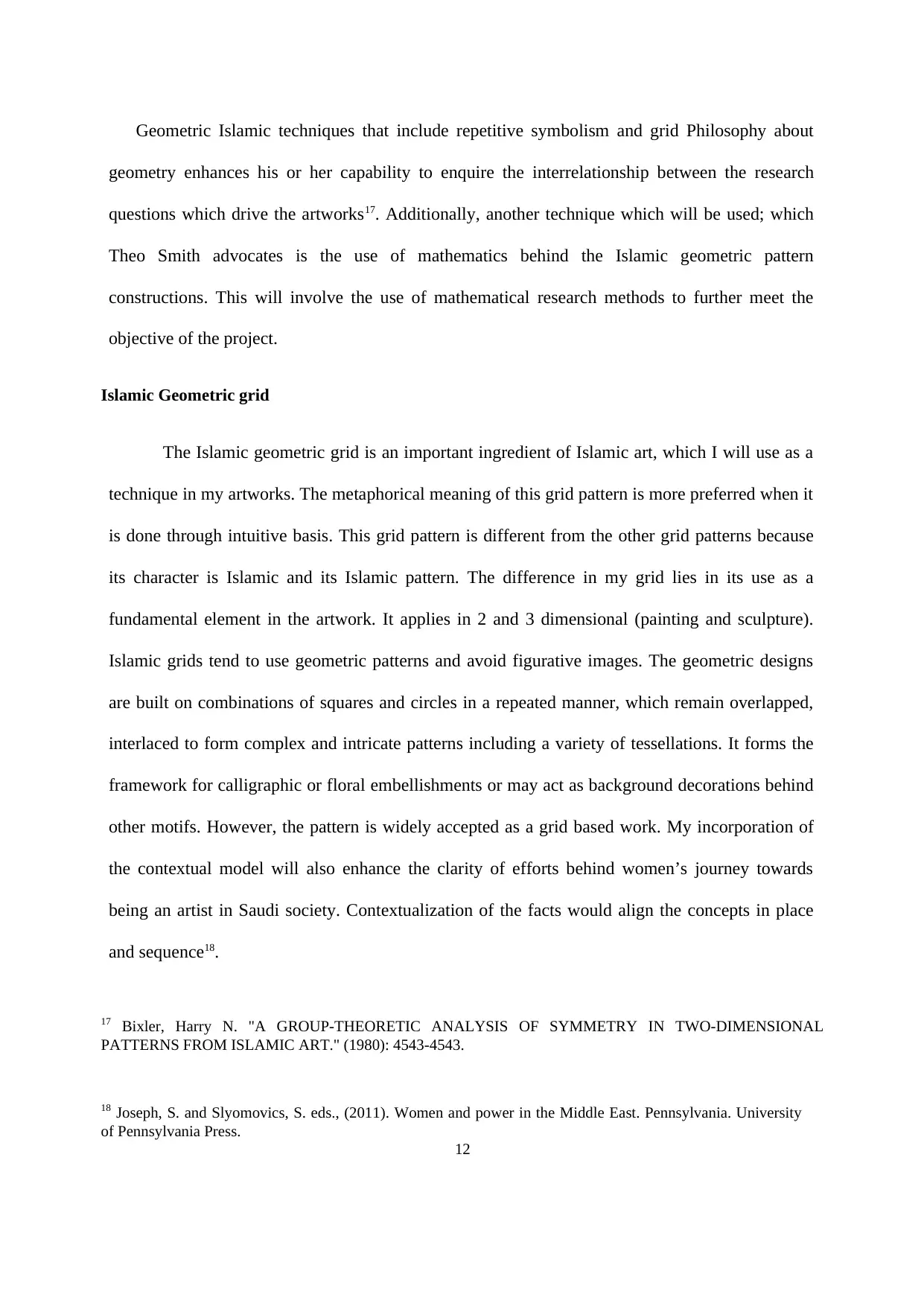
Geometric Islamic techniques that include repetitive symbolism and grid Philosophy about
geometry enhances his or her capability to enquire the interrelationship between the research
questions which drive the artworks17. Additionally, another technique which will be used; which
Theo Smith advocates is the use of mathematics behind the Islamic geometric pattern
constructions. This will involve the use of mathematical research methods to further meet the
objective of the project.
Islamic Geometric grid
The Islamic geometric grid is an important ingredient of Islamic art, which I will use as a
technique in my artworks. The metaphorical meaning of this grid pattern is more preferred when it
is done through intuitive basis. This grid pattern is different from the other grid patterns because
its character is Islamic and its Islamic pattern. The difference in my grid lies in its use as a
fundamental element in the artwork. It applies in 2 and 3 dimensional (painting and sculpture).
Islamic grids tend to use geometric patterns and avoid figurative images. The geometric designs
are built on combinations of squares and circles in a repeated manner, which remain overlapped,
interlaced to form complex and intricate patterns including a variety of tessellations. It forms the
framework for calligraphic or floral embellishments or may act as background decorations behind
other motifs. However, the pattern is widely accepted as a grid based work. My incorporation of
the contextual model will also enhance the clarity of efforts behind women’s journey towards
being an artist in Saudi society. Contextualization of the facts would align the concepts in place
and sequence18.
17 Bixler, Harry N. "A GROUP-THEORETIC ANALYSIS OF SYMMETRY IN TWO-DIMENSIONAL
PATTERNS FROM ISLAMIC ART." (1980): 4543-4543.
18 Joseph, S. and Slyomovics, S. eds., (2011). Women and power in the Middle East. Pennsylvania. University
of Pennsylvania Press.
12
geometry enhances his or her capability to enquire the interrelationship between the research
questions which drive the artworks17. Additionally, another technique which will be used; which
Theo Smith advocates is the use of mathematics behind the Islamic geometric pattern
constructions. This will involve the use of mathematical research methods to further meet the
objective of the project.
Islamic Geometric grid
The Islamic geometric grid is an important ingredient of Islamic art, which I will use as a
technique in my artworks. The metaphorical meaning of this grid pattern is more preferred when it
is done through intuitive basis. This grid pattern is different from the other grid patterns because
its character is Islamic and its Islamic pattern. The difference in my grid lies in its use as a
fundamental element in the artwork. It applies in 2 and 3 dimensional (painting and sculpture).
Islamic grids tend to use geometric patterns and avoid figurative images. The geometric designs
are built on combinations of squares and circles in a repeated manner, which remain overlapped,
interlaced to form complex and intricate patterns including a variety of tessellations. It forms the
framework for calligraphic or floral embellishments or may act as background decorations behind
other motifs. However, the pattern is widely accepted as a grid based work. My incorporation of
the contextual model will also enhance the clarity of efforts behind women’s journey towards
being an artist in Saudi society. Contextualization of the facts would align the concepts in place
and sequence18.
17 Bixler, Harry N. "A GROUP-THEORETIC ANALYSIS OF SYMMETRY IN TWO-DIMENSIONAL
PATTERNS FROM ISLAMIC ART." (1980): 4543-4543.
18 Joseph, S. and Slyomovics, S. eds., (2011). Women and power in the Middle East. Pennsylvania. University
of Pennsylvania Press.
12
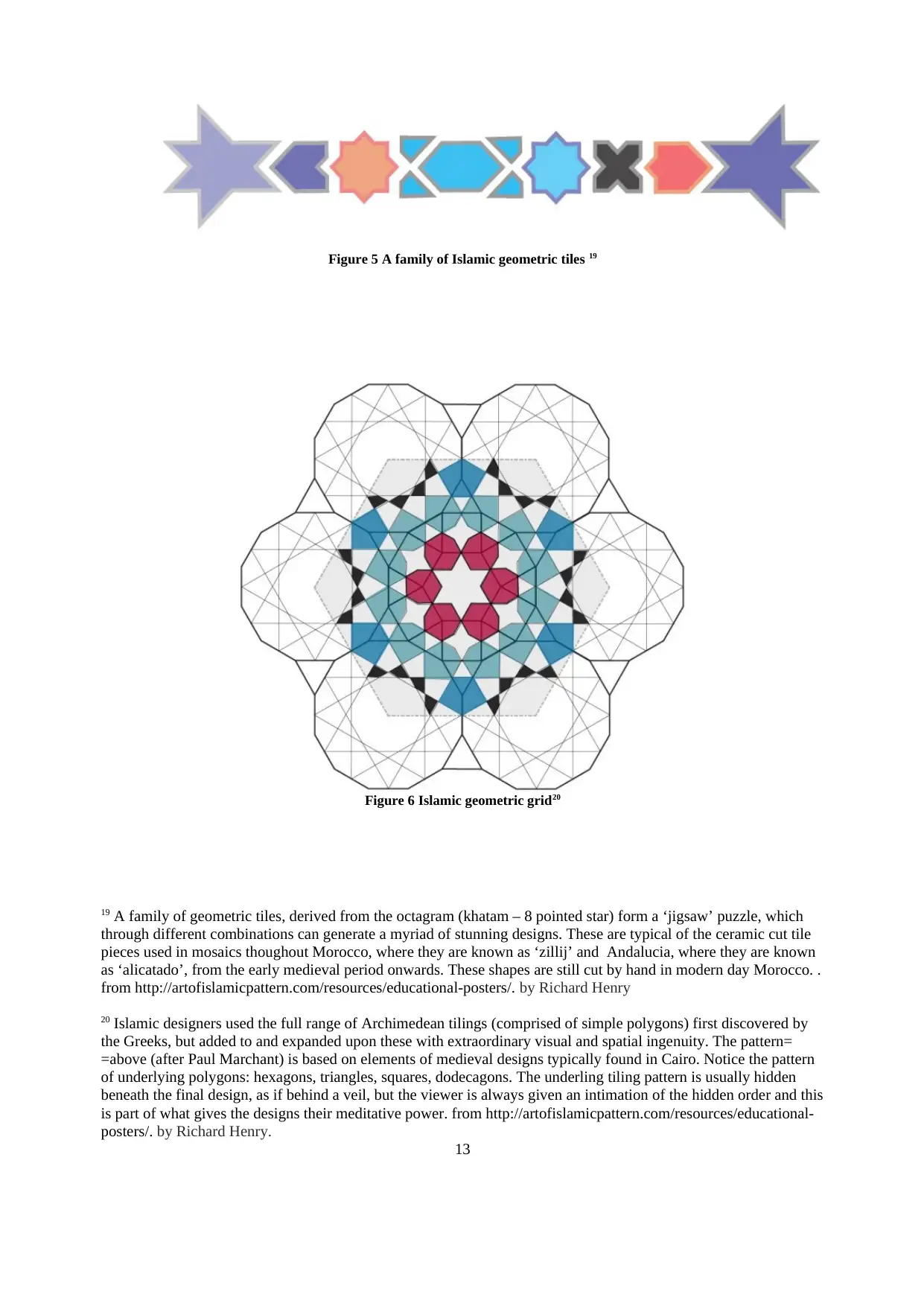
Figure 5 A family of Islamic geometric tiles 19
Figure 6 Islamic geometric grid20
19 A family of geometric tiles, derived from the octagram (khatam – 8 pointed star) form a ‘jigsaw’ puzzle, which
through different combinations can generate a myriad of stunning designs. These are typical of the ceramic cut tile
pieces used in mosaics thoughout Morocco, where they are known as ‘zillij’ and Andalucia, where they are known
as ‘alicatado’, from the early medieval period onwards. These shapes are still cut by hand in modern day Morocco. .
from http://artofislamicpattern.com/resources/educational-posters/. by Richard Henry
20 Islamic designers used the full range of Archimedean tilings (comprised of simple polygons) first discovered by
the Greeks, but added to and expanded upon these with extraordinary visual and spatial ingenuity. The pattern=
=above (after Paul Marchant) is based on elements of medieval designs typically found in Cairo. Notice the pattern
of underlying polygons: hexagons, triangles, squares, dodecagons. The underling tiling pattern is usually hidden
beneath the final design, as if behind a veil, but the viewer is always given an intimation of the hidden order and this
is part of what gives the designs their meditative power. from http://artofislamicpattern.com/resources/educational-
posters/. by Richard Henry.
13
Figure 6 Islamic geometric grid20
19 A family of geometric tiles, derived from the octagram (khatam – 8 pointed star) form a ‘jigsaw’ puzzle, which
through different combinations can generate a myriad of stunning designs. These are typical of the ceramic cut tile
pieces used in mosaics thoughout Morocco, where they are known as ‘zillij’ and Andalucia, where they are known
as ‘alicatado’, from the early medieval period onwards. These shapes are still cut by hand in modern day Morocco. .
from http://artofislamicpattern.com/resources/educational-posters/. by Richard Henry
20 Islamic designers used the full range of Archimedean tilings (comprised of simple polygons) first discovered by
the Greeks, but added to and expanded upon these with extraordinary visual and spatial ingenuity. The pattern=
=above (after Paul Marchant) is based on elements of medieval designs typically found in Cairo. Notice the pattern
of underlying polygons: hexagons, triangles, squares, dodecagons. The underling tiling pattern is usually hidden
beneath the final design, as if behind a veil, but the viewer is always given an intimation of the hidden order and this
is part of what gives the designs their meditative power. from http://artofislamicpattern.com/resources/educational-
posters/. by Richard Henry.
13
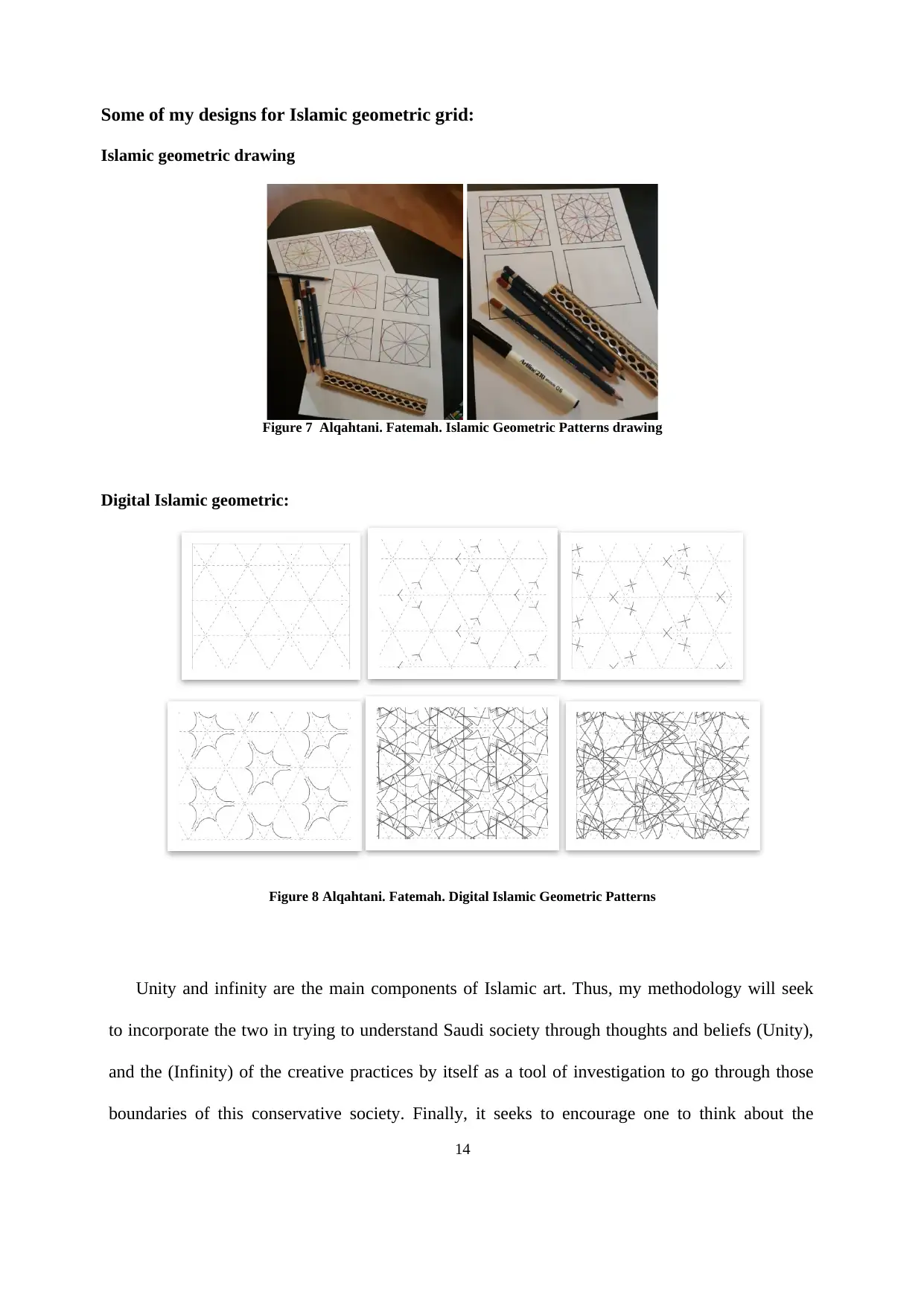
Some of my designs for Islamic geometric grid:
Islamic geometric drawing
Figure 7 Alqahtani. Fatemah. Islamic Geometric Patterns drawing
Digital Islamic geometric:
Figure 8 Alqahtani. Fatemah. Digital Islamic Geometric Patterns
Unity and infinity are the main components of Islamic art. Thus, my methodology will seek
to incorporate the two in trying to understand Saudi society through thoughts and beliefs (Unity),
and the (Infinity) of the creative practices by itself as a tool of investigation to go through those
boundaries of this conservative society. Finally, it seeks to encourage one to think about the
14
Islamic geometric drawing
Figure 7 Alqahtani. Fatemah. Islamic Geometric Patterns drawing
Digital Islamic geometric:
Figure 8 Alqahtani. Fatemah. Digital Islamic Geometric Patterns
Unity and infinity are the main components of Islamic art. Thus, my methodology will seek
to incorporate the two in trying to understand Saudi society through thoughts and beliefs (Unity),
and the (Infinity) of the creative practices by itself as a tool of investigation to go through those
boundaries of this conservative society. Finally, it seeks to encourage one to think about the
14
Secure Best Marks with AI Grader
Need help grading? Try our AI Grader for instant feedback on your assignments.
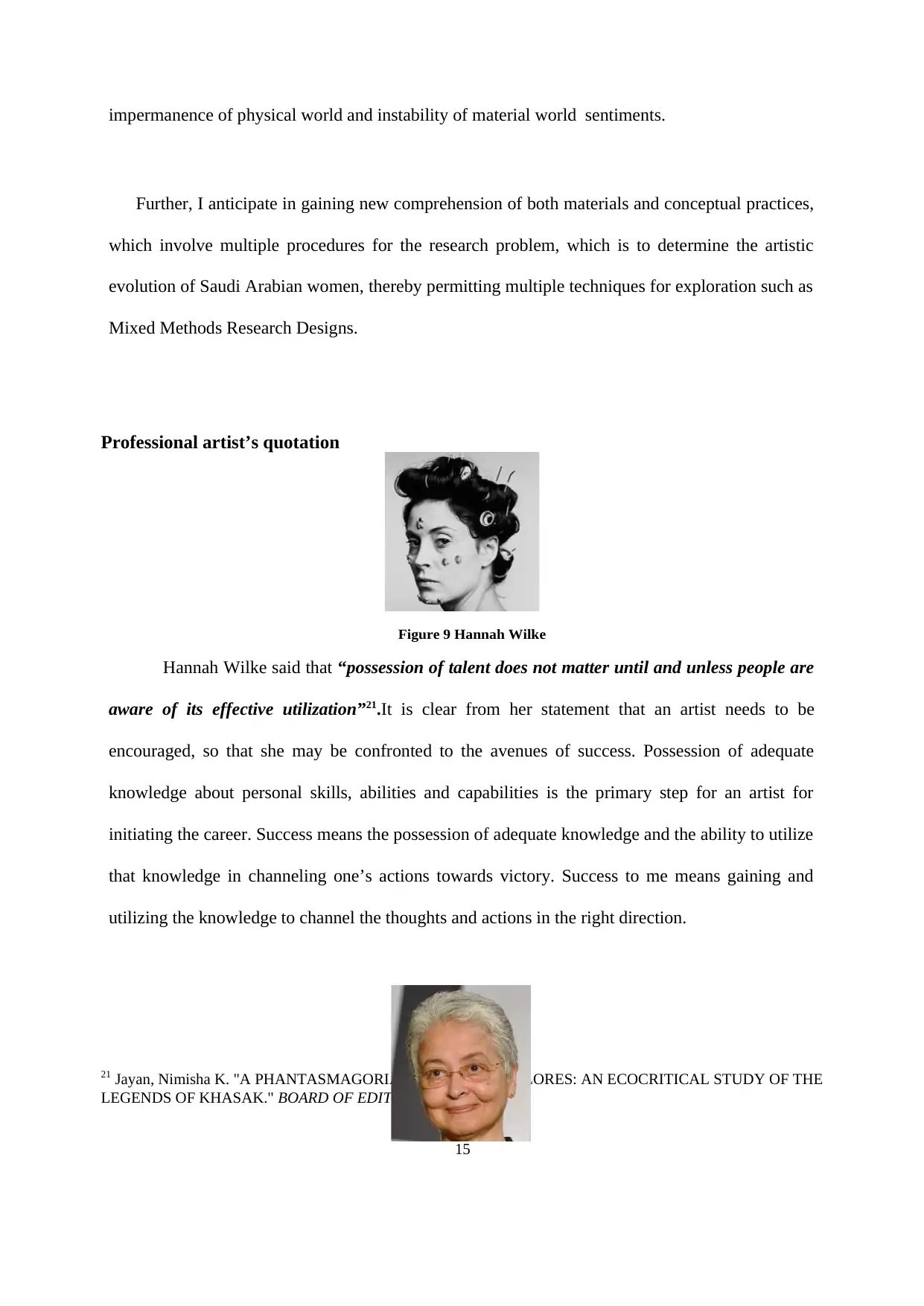
impermanence of physical world and instability of material world sentiments.
Further, I anticipate in gaining new comprehension of both materials and conceptual practices,
which involve multiple procedures for the research problem, which is to determine the artistic
evolution of Saudi Arabian women, thereby permitting multiple techniques for exploration such as
Mixed Methods Research Designs.
Professional artist’s quotation
Figure 9 Hannah Wilke
Hannah Wilke said that “possession of talent does not matter until and unless people are
aware of its effective utilization”21.It is clear from her statement that an artist needs to be
encouraged, so that she may be confronted to the avenues of success. Possession of adequate
knowledge about personal skills, abilities and capabilities is the primary step for an artist for
initiating the career. Success means the possession of adequate knowledge and the ability to utilize
that knowledge in channeling one’s actions towards victory. Success to me means gaining and
utilizing the knowledge to channel the thoughts and actions in the right direction.
21 Jayan, Nimisha K. "A PHANTASMAGORIA OF MYTHS AND LORES: AN ECOCRITICAL STUDY OF THE
LEGENDS OF KHASAK." BOARD OF EDITORS (2015): 63.
15
Further, I anticipate in gaining new comprehension of both materials and conceptual practices,
which involve multiple procedures for the research problem, which is to determine the artistic
evolution of Saudi Arabian women, thereby permitting multiple techniques for exploration such as
Mixed Methods Research Designs.
Professional artist’s quotation
Figure 9 Hannah Wilke
Hannah Wilke said that “possession of talent does not matter until and unless people are
aware of its effective utilization”21.It is clear from her statement that an artist needs to be
encouraged, so that she may be confronted to the avenues of success. Possession of adequate
knowledge about personal skills, abilities and capabilities is the primary step for an artist for
initiating the career. Success means the possession of adequate knowledge and the ability to utilize
that knowledge in channeling one’s actions towards victory. Success to me means gaining and
utilizing the knowledge to channel the thoughts and actions in the right direction.
21 Jayan, Nimisha K. "A PHANTASMAGORIA OF MYTHS AND LORES: AN ECOCRITICAL STUDY OF THE
LEGENDS OF KHASAK." BOARD OF EDITORS (2015): 63.
15
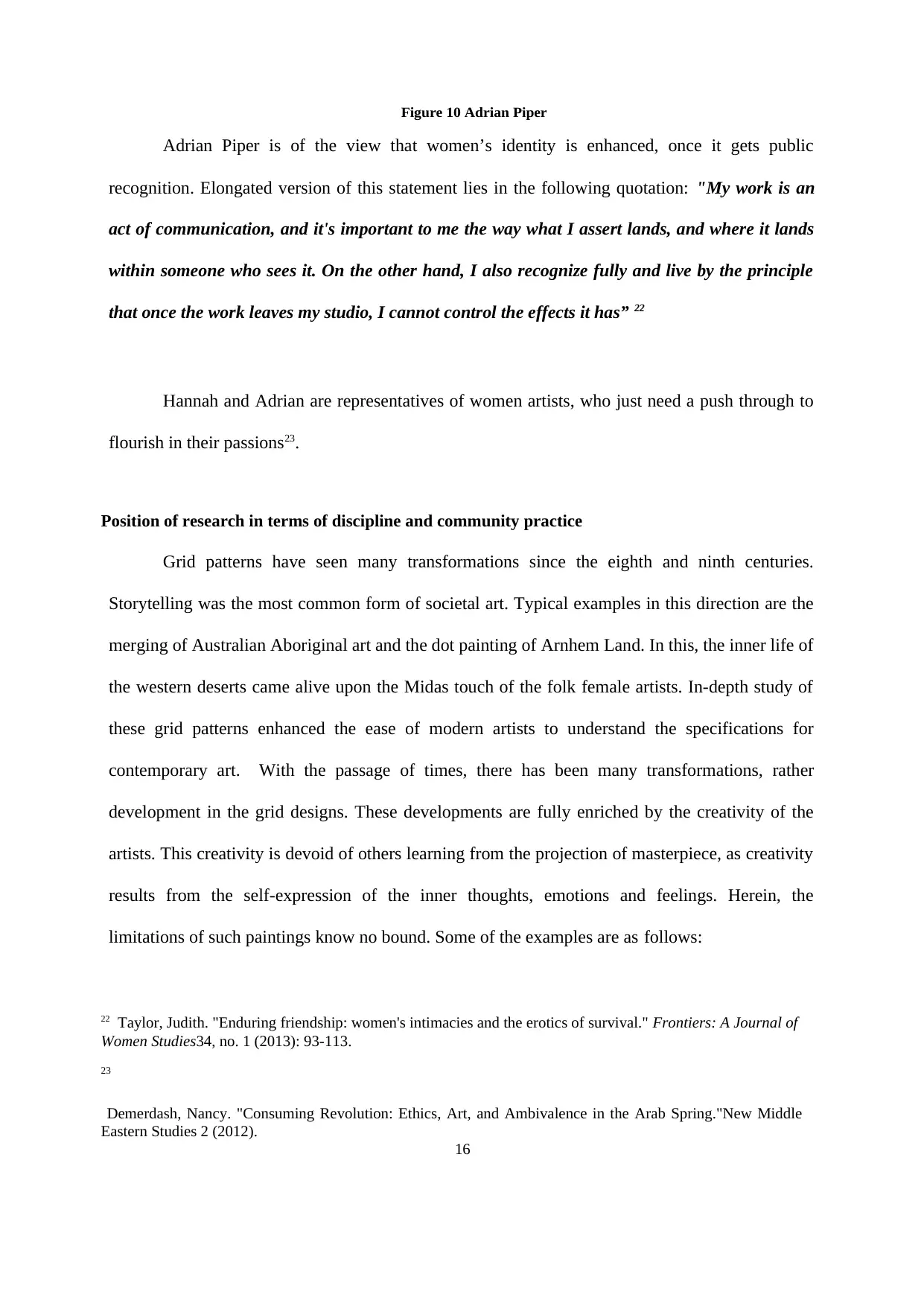
Figure 10 Adrian Piper
Adrian Piper is of the view that women’s identity is enhanced, once it gets public
recognition. Elongated version of this statement lies in the following quotation: "My work is an
act of communication, and it's important to me the way what I assert lands, and where it lands
within someone who sees it. On the other hand, I also recognize fully and live by the principle
that once the work leaves my studio, I cannot control the effects it has” 22
Hannah and Adrian are representatives of women artists, who just need a push through to
flourish in their passions23.
Position of research in terms of discipline and community practice
Grid patterns have seen many transformations since the eighth and ninth centuries.
Storytelling was the most common form of societal art. Typical examples in this direction are the
merging of Australian Aboriginal art and the dot painting of Arnhem Land. In this, the inner life of
the western deserts came alive upon the Midas touch of the folk female artists. In-depth study of
these grid patterns enhanced the ease of modern artists to understand the specifications for
contemporary art. With the passage of times, there has been many transformations, rather
development in the grid designs. These developments are fully enriched by the creativity of the
artists. This creativity is devoid of others learning from the projection of masterpiece, as creativity
results from the self-expression of the inner thoughts, emotions and feelings. Herein, the
limitations of such paintings know no bound. Some of the examples are as follows:
22 Taylor, Judith. "Enduring friendship: women's intimacies and the erotics of survival." Frontiers: A Journal of
Women Studies34, no. 1 (2013): 93-113.
23
Demerdash, Nancy. "Consuming Revolution: Ethics, Art, and Ambivalence in the Arab Spring."New Middle
Eastern Studies 2 (2012).
16
Adrian Piper is of the view that women’s identity is enhanced, once it gets public
recognition. Elongated version of this statement lies in the following quotation: "My work is an
act of communication, and it's important to me the way what I assert lands, and where it lands
within someone who sees it. On the other hand, I also recognize fully and live by the principle
that once the work leaves my studio, I cannot control the effects it has” 22
Hannah and Adrian are representatives of women artists, who just need a push through to
flourish in their passions23.
Position of research in terms of discipline and community practice
Grid patterns have seen many transformations since the eighth and ninth centuries.
Storytelling was the most common form of societal art. Typical examples in this direction are the
merging of Australian Aboriginal art and the dot painting of Arnhem Land. In this, the inner life of
the western deserts came alive upon the Midas touch of the folk female artists. In-depth study of
these grid patterns enhanced the ease of modern artists to understand the specifications for
contemporary art. With the passage of times, there has been many transformations, rather
development in the grid designs. These developments are fully enriched by the creativity of the
artists. This creativity is devoid of others learning from the projection of masterpiece, as creativity
results from the self-expression of the inner thoughts, emotions and feelings. Herein, the
limitations of such paintings know no bound. Some of the examples are as follows:
22 Taylor, Judith. "Enduring friendship: women's intimacies and the erotics of survival." Frontiers: A Journal of
Women Studies34, no. 1 (2013): 93-113.
23
Demerdash, Nancy. "Consuming Revolution: Ethics, Art, and Ambivalence in the Arab Spring."New Middle
Eastern Studies 2 (2012).
16
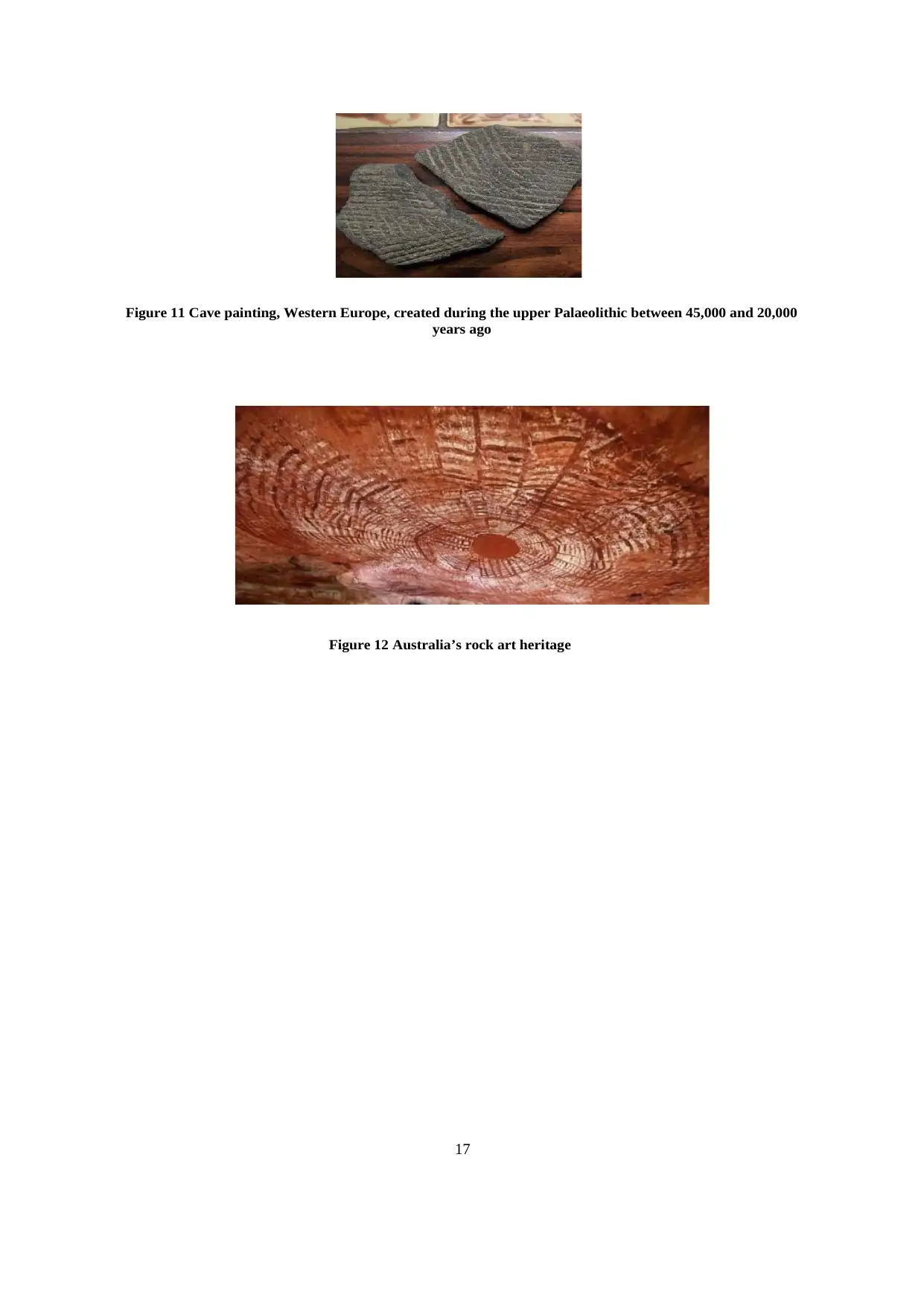
Figure 11 Cave painting, Western Europe, created during the upper Palaeolithic between 45,000 and 20,000
years ago
Figure 12 Australia’s rock art heritage
17
years ago
Figure 12 Australia’s rock art heritage
17
Paraphrase This Document
Need a fresh take? Get an instant paraphrase of this document with our AI Paraphraser
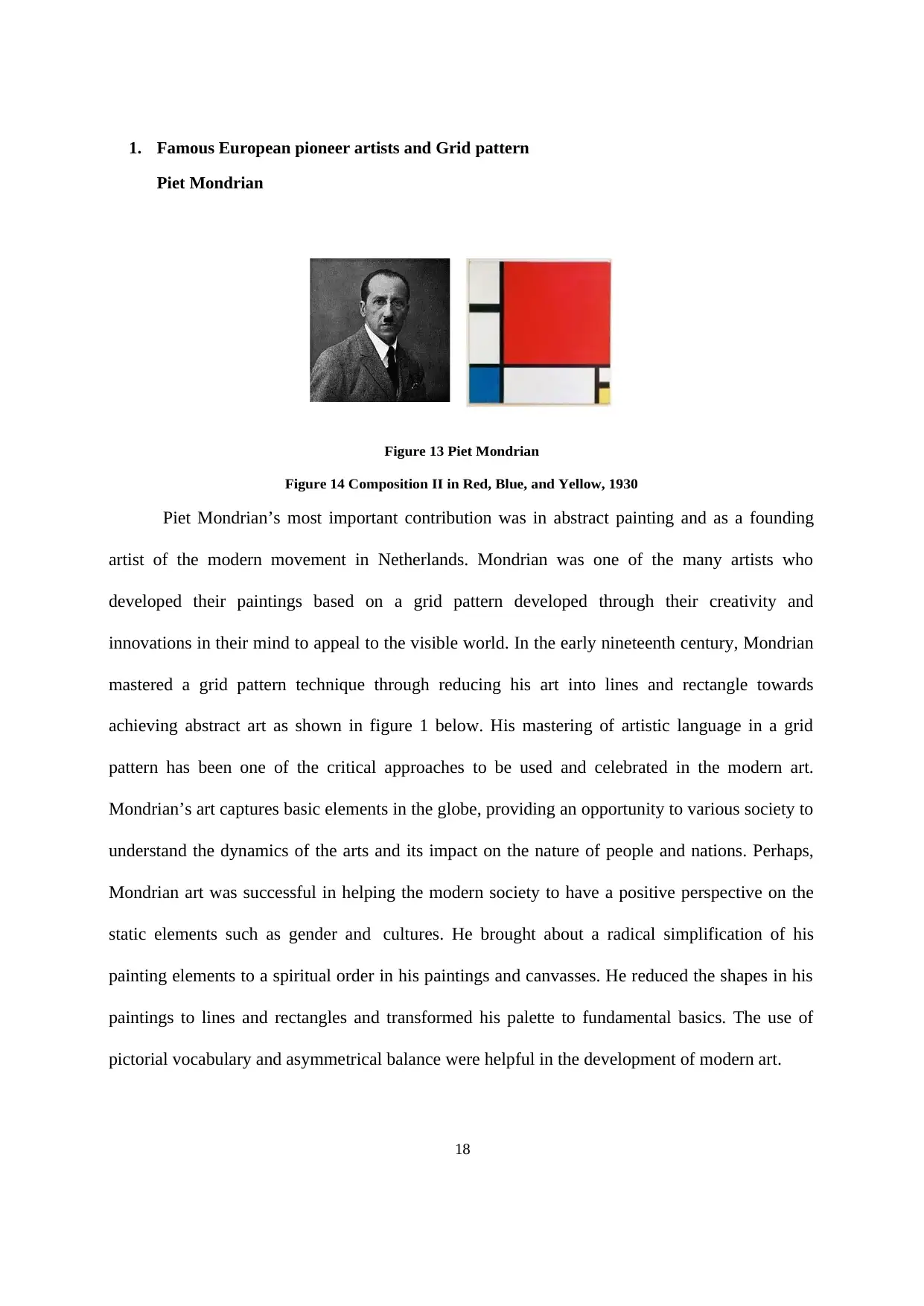
1. Famous European pioneer artists and Grid pattern
Piet Mondrian
Figure 13 Piet Mondrian
Figure 14 Composition II in Red, Blue, and Yellow, 1930
Piet Mondrian’s most important contribution was in abstract painting and as a founding
artist of the modern movement in Netherlands. Mondrian was one of the many artists who
developed their paintings based on a grid pattern developed through their creativity and
innovations in their mind to appeal to the visible world. In the early nineteenth century, Mondrian
mastered a grid pattern technique through reducing his art into lines and rectangle towards
achieving abstract art as shown in figure 1 below. His mastering of artistic language in a grid
pattern has been one of the critical approaches to be used and celebrated in the modern art.
Mondrian’s art captures basic elements in the globe, providing an opportunity to various society to
understand the dynamics of the arts and its impact on the nature of people and nations. Perhaps,
Mondrian art was successful in helping the modern society to have a positive perspective on the
static elements such as gender and cultures. He brought about a radical simplification of his
painting elements to a spiritual order in his paintings and canvasses. He reduced the shapes in his
paintings to lines and rectangles and transformed his palette to fundamental basics. The use of
pictorial vocabulary and asymmetrical balance were helpful in the development of modern art.
18
Piet Mondrian
Figure 13 Piet Mondrian
Figure 14 Composition II in Red, Blue, and Yellow, 1930
Piet Mondrian’s most important contribution was in abstract painting and as a founding
artist of the modern movement in Netherlands. Mondrian was one of the many artists who
developed their paintings based on a grid pattern developed through their creativity and
innovations in their mind to appeal to the visible world. In the early nineteenth century, Mondrian
mastered a grid pattern technique through reducing his art into lines and rectangle towards
achieving abstract art as shown in figure 1 below. His mastering of artistic language in a grid
pattern has been one of the critical approaches to be used and celebrated in the modern art.
Mondrian’s art captures basic elements in the globe, providing an opportunity to various society to
understand the dynamics of the arts and its impact on the nature of people and nations. Perhaps,
Mondrian art was successful in helping the modern society to have a positive perspective on the
static elements such as gender and cultures. He brought about a radical simplification of his
painting elements to a spiritual order in his paintings and canvasses. He reduced the shapes in his
paintings to lines and rectangles and transformed his palette to fundamental basics. The use of
pictorial vocabulary and asymmetrical balance were helpful in the development of modern art.
18

Figure 15 Piet, Mondrian, “Broadway Boogie‐Woogie,” 1942‐3. Oil on Canvas
19
19
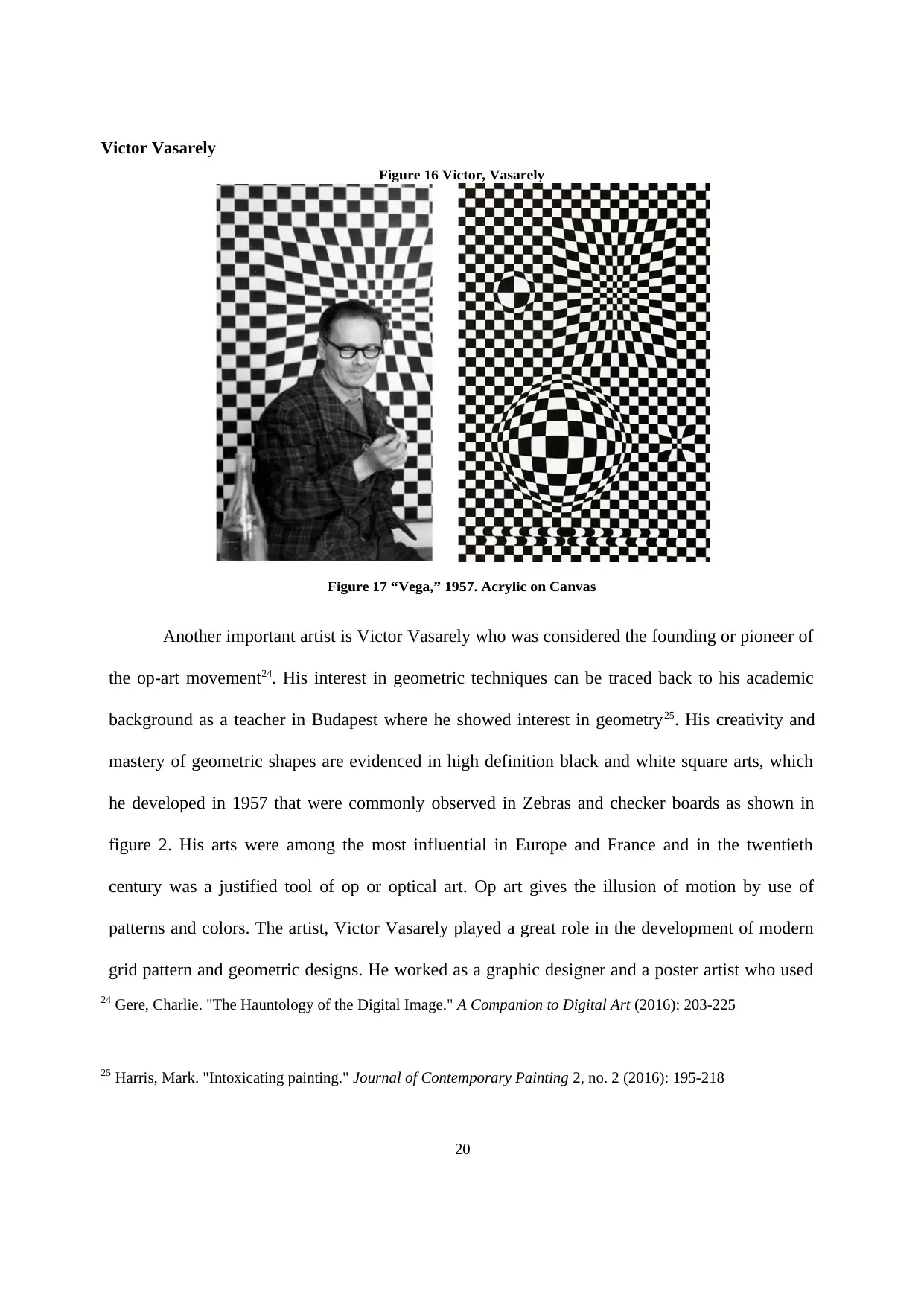
Victor Vasarely
Figure 16 Victor, Vasarely
Figure 17 “Vega,” 1957. Acrylic on Canvas
Another important artist is Victor Vasarely who was considered the founding or pioneer of
the op-art movement24. His interest in geometric techniques can be traced back to his academic
background as a teacher in Budapest where he showed interest in geometry25. His creativity and
mastery of geometric shapes are evidenced in high definition black and white square arts, which
he developed in 1957 that were commonly observed in Zebras and checker boards as shown in
figure 2. His arts were among the most influential in Europe and France and in the twentieth
century was a justified tool of op or optical art. Op art gives the illusion of motion by use of
patterns and colors. The artist, Victor Vasarely played a great role in the development of modern
grid pattern and geometric designs. He worked as a graphic designer and a poster artist who used
24 Gere, Charlie. "The Hauntology of the Digital Image." A Companion to Digital Art (2016): 203-225
25 Harris, Mark. "Intoxicating painting." Journal of Contemporary Painting 2, no. 2 (2016): 195-218
20
Figure 16 Victor, Vasarely
Figure 17 “Vega,” 1957. Acrylic on Canvas
Another important artist is Victor Vasarely who was considered the founding or pioneer of
the op-art movement24. His interest in geometric techniques can be traced back to his academic
background as a teacher in Budapest where he showed interest in geometry25. His creativity and
mastery of geometric shapes are evidenced in high definition black and white square arts, which
he developed in 1957 that were commonly observed in Zebras and checker boards as shown in
figure 2. His arts were among the most influential in Europe and France and in the twentieth
century was a justified tool of op or optical art. Op art gives the illusion of motion by use of
patterns and colors. The artist, Victor Vasarely played a great role in the development of modern
grid pattern and geometric designs. He worked as a graphic designer and a poster artist who used
24 Gere, Charlie. "The Hauntology of the Digital Image." A Companion to Digital Art (2016): 203-225
25 Harris, Mark. "Intoxicating painting." Journal of Contemporary Painting 2, no. 2 (2016): 195-218
20
Secure Best Marks with AI Grader
Need help grading? Try our AI Grader for instant feedback on your assignments.
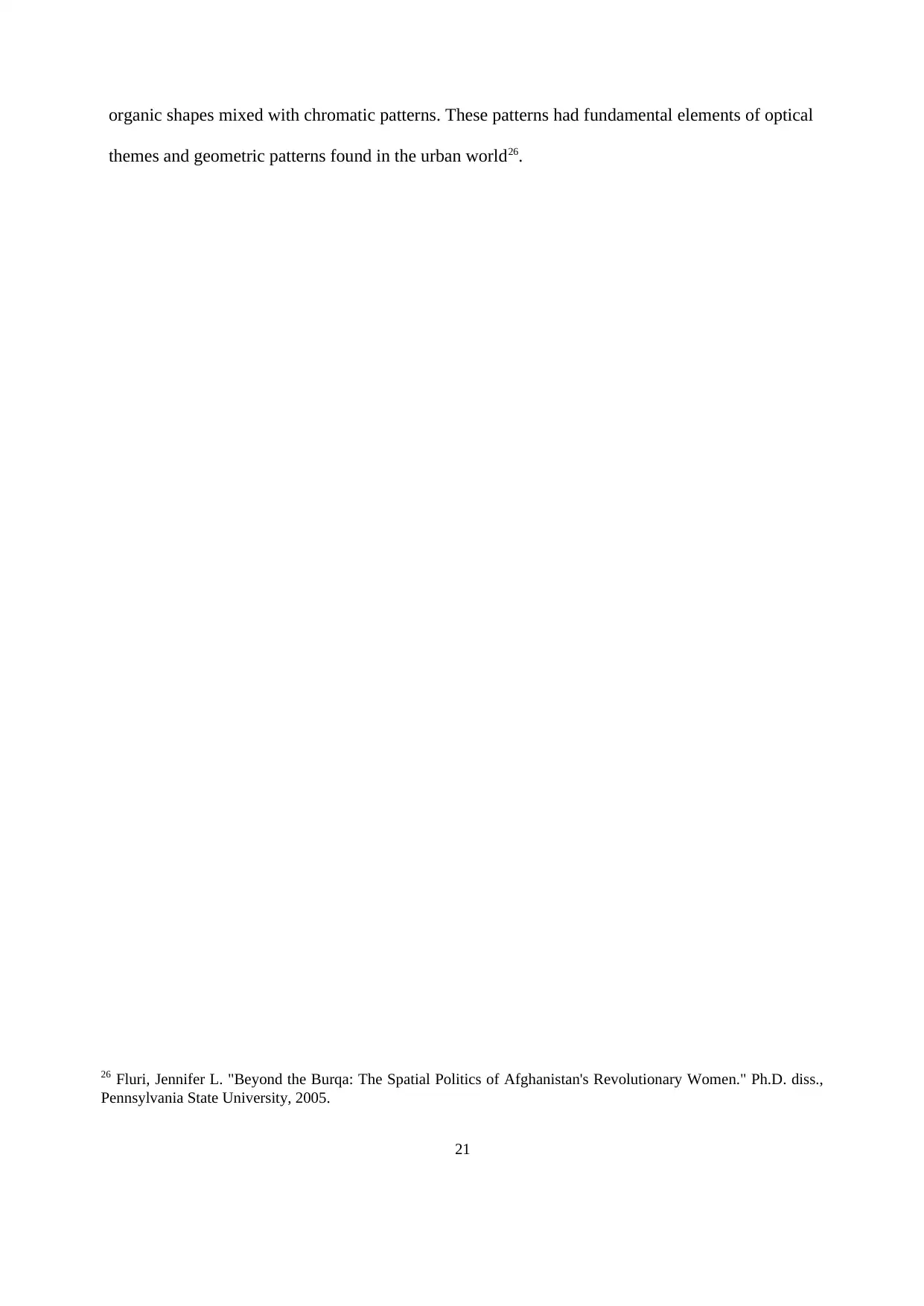
organic shapes mixed with chromatic patterns. These patterns had fundamental elements of optical
themes and geometric patterns found in the urban world26.
26 Fluri, Jennifer L. "Beyond the Burqa: The Spatial Politics of Afghanistan's Revolutionary Women." Ph.D. diss.,
Pennsylvania State University, 2005.
21
themes and geometric patterns found in the urban world26.
26 Fluri, Jennifer L. "Beyond the Burqa: The Spatial Politics of Afghanistan's Revolutionary Women." Ph.D. diss.,
Pennsylvania State University, 2005.
21

2. Contemporary artists and grid pattern
Peter Kogler
Figure 18 Peter Kogler.1959, Peter Kogler. Sigmund Freud Museum.2015
Peter Kogleris an Austrian artist who used the geometric grid in his work. Since the 1980s,
he has used optical illusions to challenge the viewer’s sense of depth with his psychedelic
installations. In Figure 15, Peter Kogler has brought out an idea about optical illusions through this
art. Peter deals with the geometric grid as an art philosophy. Through this technique, he exposes
his imagination and ideas about movements. Such a unique creativity of artists encouraged the
power of human imagination to attend to thoughts that are in both the conscious and the
subconscious minds. This in turn helps in establishing a new knowledge of life and making it
visible.
22
Peter Kogler
Figure 18 Peter Kogler.1959, Peter Kogler. Sigmund Freud Museum.2015
Peter Kogleris an Austrian artist who used the geometric grid in his work. Since the 1980s,
he has used optical illusions to challenge the viewer’s sense of depth with his psychedelic
installations. In Figure 15, Peter Kogler has brought out an idea about optical illusions through this
art. Peter deals with the geometric grid as an art philosophy. Through this technique, he exposes
his imagination and ideas about movements. Such a unique creativity of artists encouraged the
power of human imagination to attend to thoughts that are in both the conscious and the
subconscious minds. This in turn helps in establishing a new knowledge of life and making it
visible.
22

Figure 19 Peter, Kogler, “Photo/Foto Vincent Everarts,” 2016
23
23
Paraphrase This Document
Need a fresh take? Get an instant paraphrase of this document with our AI Paraphraser
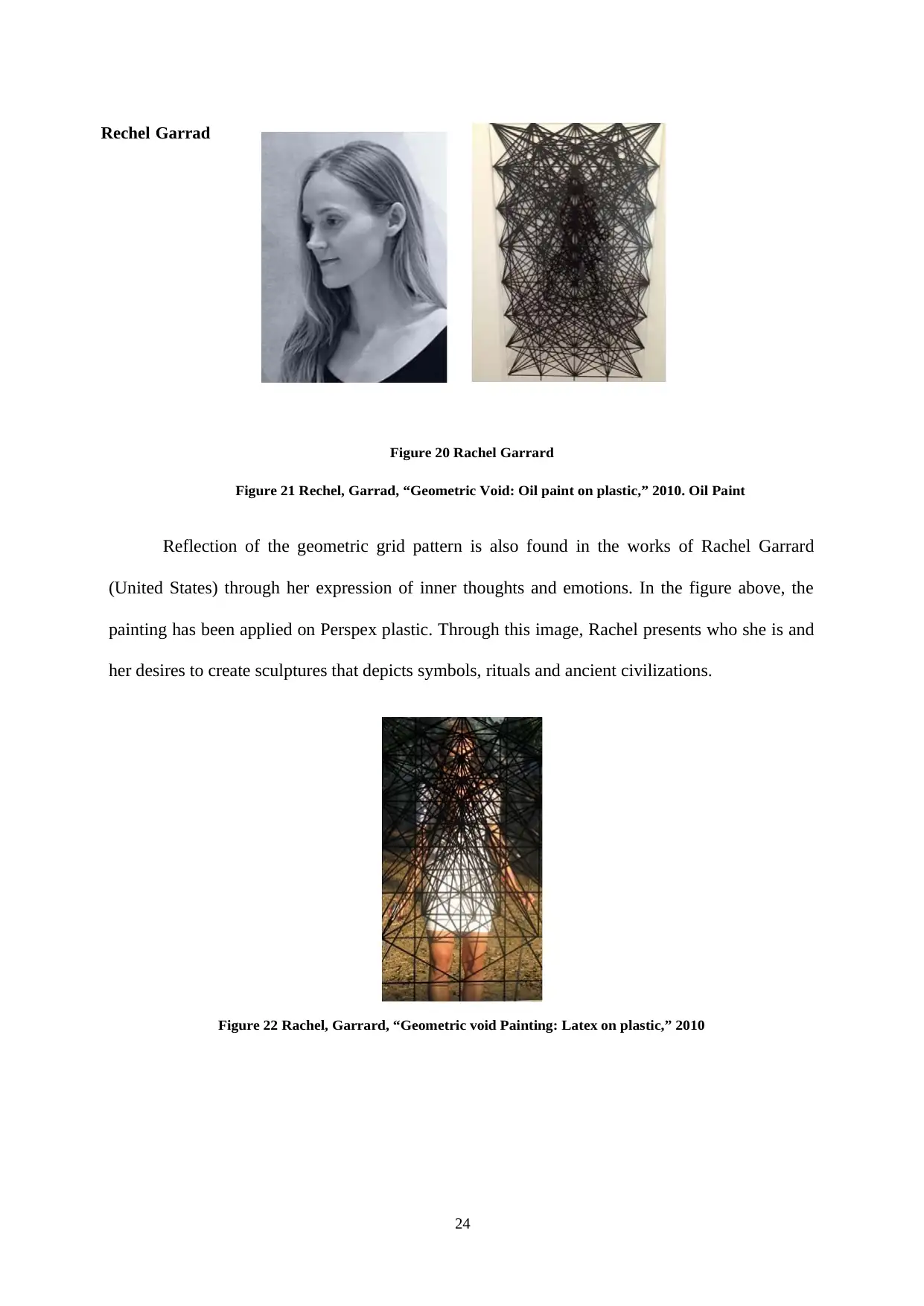
Rechel Garrad
Figure 20 Rachel Garrard
Figure 21 Rechel, Garrad, “Geometric Void: Oil paint on plastic,” 2010. Oil Paint
Reflection of the geometric grid pattern is also found in the works of Rachel Garrard
(United States) through her expression of inner thoughts and emotions. In the figure above, the
painting has been applied on Perspex plastic. Through this image, Rachel presents who she is and
her desires to create sculptures that depicts symbols, rituals and ancient civilizations.
Figure 22 Rachel, Garrard, “Geometric void Painting: Latex on plastic,” 2010
24
Figure 20 Rachel Garrard
Figure 21 Rechel, Garrad, “Geometric Void: Oil paint on plastic,” 2010. Oil Paint
Reflection of the geometric grid pattern is also found in the works of Rachel Garrard
(United States) through her expression of inner thoughts and emotions. In the figure above, the
painting has been applied on Perspex plastic. Through this image, Rachel presents who she is and
her desires to create sculptures that depicts symbols, rituals and ancient civilizations.
Figure 22 Rachel, Garrard, “Geometric void Painting: Latex on plastic,” 2010
24

3. Jewelry and grid patterns
Bin Dixon-WARD
Figure 23 Dixon‐Ward
Figure 24 Dixon‐Ward, Mix of traditional jewellery skills and digital technology
Bin Dixon Ward is an artist and a new graduate PhD candidate/College of Design and
Social Context/ School of Art/ RMIT University. Her interest is in the urban environment and in
transforming the abstract shapes of the city grid into wearable objects. Through expressing herself
using geometric grid forms, Bin has used the city landscape as a source of influence and
motivation. She then has woven the thoughts she gets from inspiration and brings out marvelous
work such as the one shown in the figure below27. Her major focus has been to bring out a better
urban living through art. It is clear from such images that she has succeeded in that. Some of the
examples of her jewellery artworks are as follows:
27 Mellor, Noha. "Empowering women through the arts." Viewpoints 6 (2010): 7-9.
25
Bin Dixon-WARD
Figure 23 Dixon‐Ward
Figure 24 Dixon‐Ward, Mix of traditional jewellery skills and digital technology
Bin Dixon Ward is an artist and a new graduate PhD candidate/College of Design and
Social Context/ School of Art/ RMIT University. Her interest is in the urban environment and in
transforming the abstract shapes of the city grid into wearable objects. Through expressing herself
using geometric grid forms, Bin has used the city landscape as a source of influence and
motivation. She then has woven the thoughts she gets from inspiration and brings out marvelous
work such as the one shown in the figure below27. Her major focus has been to bring out a better
urban living through art. It is clear from such images that she has succeeded in that. Some of the
examples of her jewellery artworks are as follows:
27 Mellor, Noha. "Empowering women through the arts." Viewpoints 6 (2010): 7-9.
25
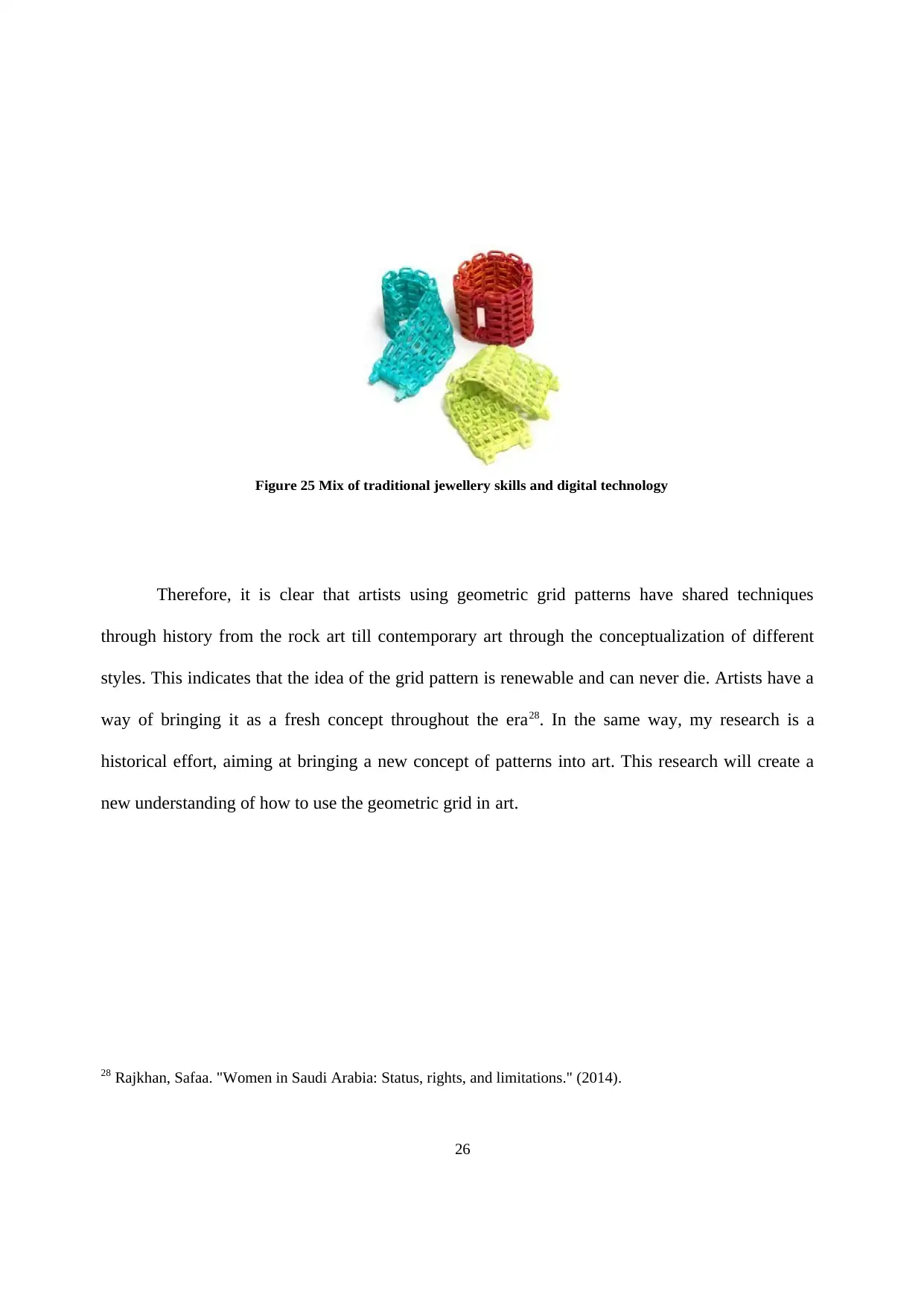
Figure 25 Mix of traditional jewellery skills and digital technology
Therefore, it is clear that artists using geometric grid patterns have shared techniques
through history from the rock art till contemporary art through the conceptualization of different
styles. This indicates that the idea of the grid pattern is renewable and can never die. Artists have a
way of bringing it as a fresh concept throughout the era28. In the same way, my research is a
historical effort, aiming at bringing a new concept of patterns into art. This research will create a
new understanding of how to use the geometric grid in art.
28 Rajkhan, Safaa. "Women in Saudi Arabia: Status, rights, and limitations." (2014).
26
Therefore, it is clear that artists using geometric grid patterns have shared techniques
through history from the rock art till contemporary art through the conceptualization of different
styles. This indicates that the idea of the grid pattern is renewable and can never die. Artists have a
way of bringing it as a fresh concept throughout the era28. In the same way, my research is a
historical effort, aiming at bringing a new concept of patterns into art. This research will create a
new understanding of how to use the geometric grid in art.
28 Rajkhan, Safaa. "Women in Saudi Arabia: Status, rights, and limitations." (2014).
26
Secure Best Marks with AI Grader
Need help grading? Try our AI Grader for instant feedback on your assignments.
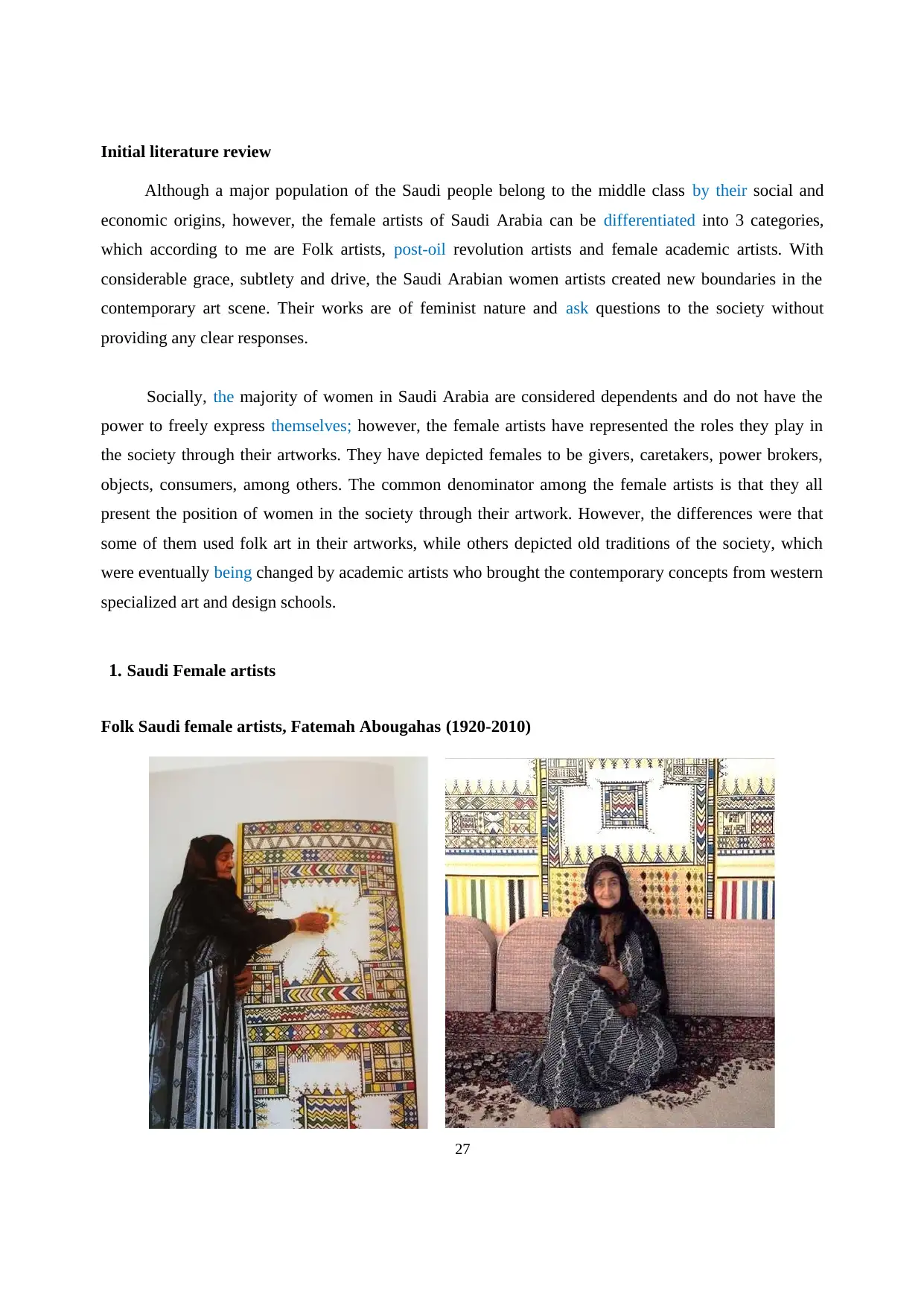
Initial literature review
Although a major population of the Saudi people belong to the middle class by their social and
economic origins, however, the female artists of Saudi Arabia can be differentiated into 3 categories,
which according to me are Folk artists, post-oil revolution artists and female academic artists. With
considerable grace, subtlety and drive, the Saudi Arabian women artists created new boundaries in the
contemporary art scene. Their works are of feminist nature and ask questions to the society without
providing any clear responses.
Socially, the majority of women in Saudi Arabia are considered dependents and do not have the
power to freely express themselves; however, the female artists have represented the roles they play in
the society through their artworks. They have depicted females to be givers, caretakers, power brokers,
objects, consumers, among others. The common denominator among the female artists is that they all
present the position of women in the society through their artwork. However, the differences were that
some of them used folk art in their artworks, while others depicted old traditions of the society, which
were eventually being changed by academic artists who brought the contemporary concepts from western
specialized art and design schools.
1. Saudi Female artists
Folk Saudi female artists, Fatemah Abougahas (1920-2010)
27
Although a major population of the Saudi people belong to the middle class by their social and
economic origins, however, the female artists of Saudi Arabia can be differentiated into 3 categories,
which according to me are Folk artists, post-oil revolution artists and female academic artists. With
considerable grace, subtlety and drive, the Saudi Arabian women artists created new boundaries in the
contemporary art scene. Their works are of feminist nature and ask questions to the society without
providing any clear responses.
Socially, the majority of women in Saudi Arabia are considered dependents and do not have the
power to freely express themselves; however, the female artists have represented the roles they play in
the society through their artworks. They have depicted females to be givers, caretakers, power brokers,
objects, consumers, among others. The common denominator among the female artists is that they all
present the position of women in the society through their artwork. However, the differences were that
some of them used folk art in their artworks, while others depicted old traditions of the society, which
were eventually being changed by academic artists who brought the contemporary concepts from western
specialized art and design schools.
1. Saudi Female artists
Folk Saudi female artists, Fatemah Abougahas (1920-2010)
27
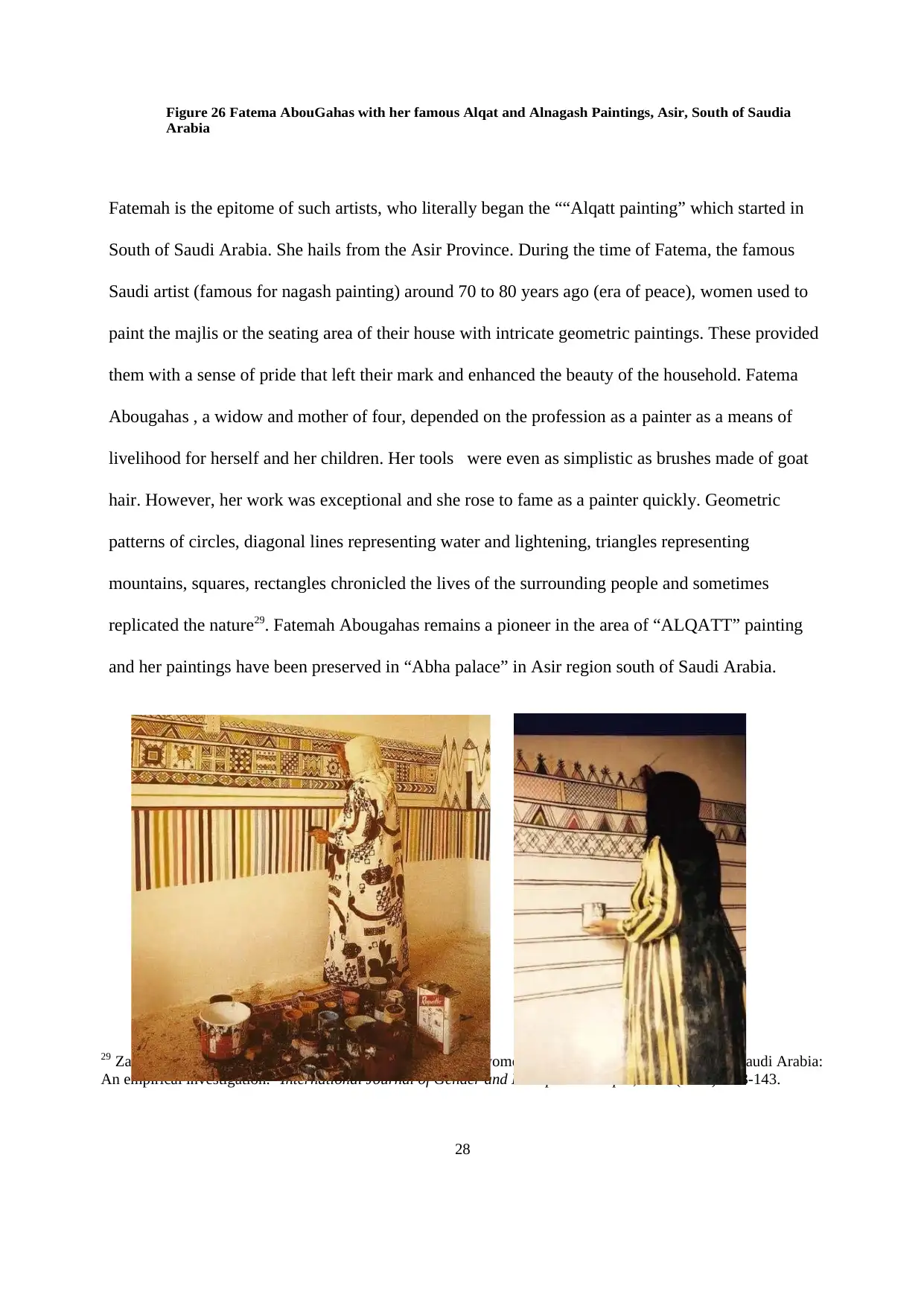
Figure 26 Fatema AbouGahas with her famous Alqat and Alnagash Paintings, Asir, South of Saudia
Arabia
Fatemah is the epitome of such artists, who literally began the ““Alqatt painting” which started in
South of Saudi Arabia. She hails from the Asir Province. During the time of Fatema, the famous
Saudi artist (famous for nagash painting) around 70 to 80 years ago (era of peace), women used to
paint the majlis or the seating area of their house with intricate geometric paintings. These provided
them with a sense of pride that left their mark and enhanced the beauty of the household. Fatema
Abougahas , a widow and mother of four, depended on the profession as a painter as a means of
livelihood for herself and her children. Her tools were even as simplistic as brushes made of goat
hair. However, her work was exceptional and she rose to fame as a painter quickly. Geometric
patterns of circles, diagonal lines representing water and lightening, triangles representing
mountains, squares, rectangles chronicled the lives of the surrounding people and sometimes
replicated the nature29. Fatemah Abougahas remains a pioneer in the area of “ALQATT” painting
and her paintings have been preserved in “Abha palace” in Asir region south of Saudi Arabia.
29 Zamberi Ahmad, Syed. "Evidence of the characteristics of women entrepreneurs in the Kingdom of Saudi Arabia:
An empirical investigation." International Journal of Gender and Entrepreneurship 3, no. 2 (2011): 123-143.
28
Arabia
Fatemah is the epitome of such artists, who literally began the ““Alqatt painting” which started in
South of Saudi Arabia. She hails from the Asir Province. During the time of Fatema, the famous
Saudi artist (famous for nagash painting) around 70 to 80 years ago (era of peace), women used to
paint the majlis or the seating area of their house with intricate geometric paintings. These provided
them with a sense of pride that left their mark and enhanced the beauty of the household. Fatema
Abougahas , a widow and mother of four, depended on the profession as a painter as a means of
livelihood for herself and her children. Her tools were even as simplistic as brushes made of goat
hair. However, her work was exceptional and she rose to fame as a painter quickly. Geometric
patterns of circles, diagonal lines representing water and lightening, triangles representing
mountains, squares, rectangles chronicled the lives of the surrounding people and sometimes
replicated the nature29. Fatemah Abougahas remains a pioneer in the area of “ALQATT” painting
and her paintings have been preserved in “Abha palace” in Asir region south of Saudi Arabia.
29 Zamberi Ahmad, Syed. "Evidence of the characteristics of women entrepreneurs in the Kingdom of Saudi Arabia:
An empirical investigation." International Journal of Gender and Entrepreneurship 3, no. 2 (2011): 123-143.
28

Figure 27 Saudi innate artists in front of their Alqat and Alnagash paintings, Asir,
29
29
Paraphrase This Document
Need a fresh take? Get an instant paraphrase of this document with our AI Paraphraser
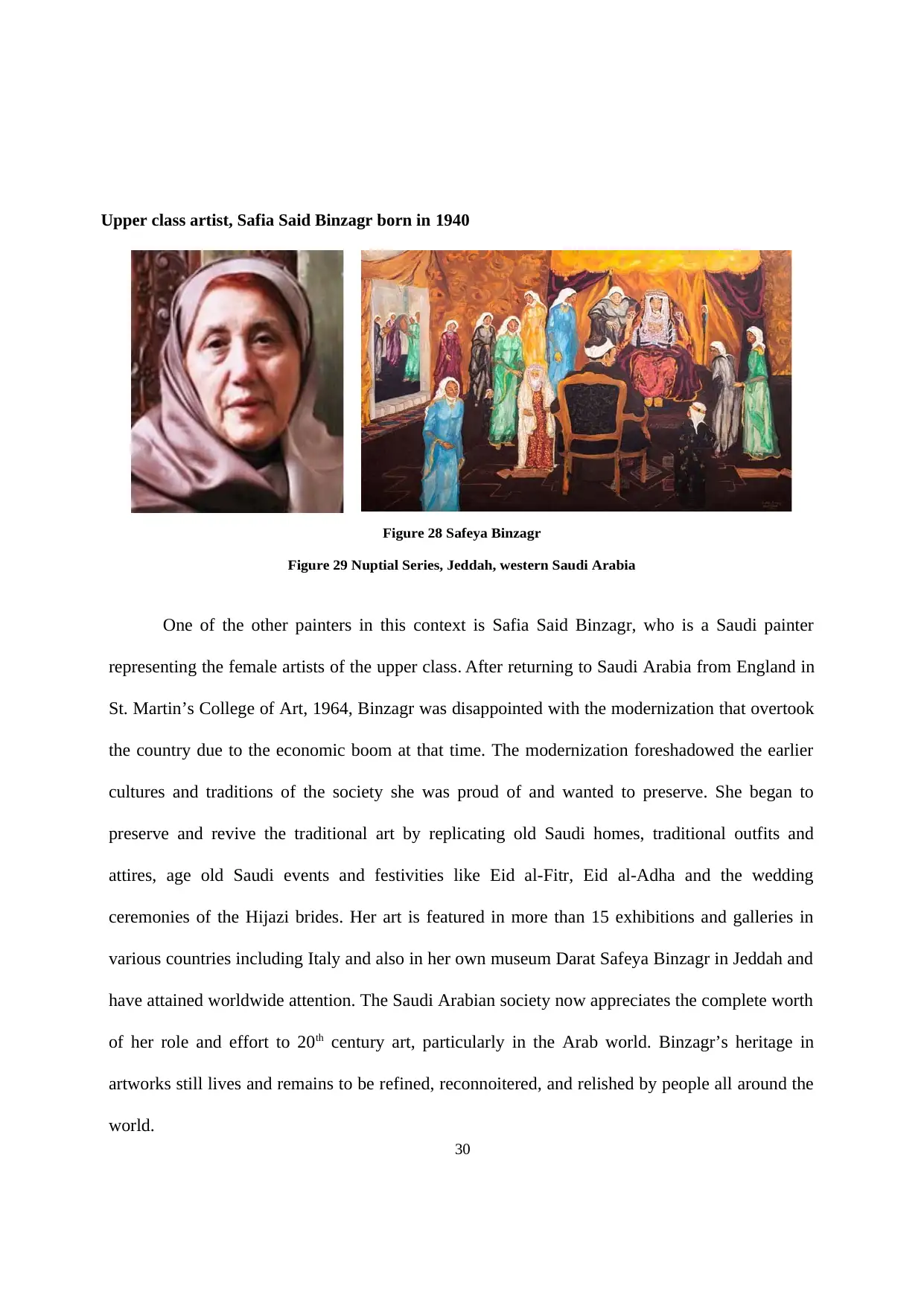
Upper class artist, Safia Said Binzagr born in 1940
Figure 28 Safeya Binzagr
Figure 29 Nuptial Series, Jeddah, western Saudi Arabia
One of the other painters in this context is Safia Said Binzagr, who is a Saudi painter
representing the female artists of the upper class. After returning to Saudi Arabia from England in
St. Martin’s College of Art, 1964, Binzagr was disappointed with the modernization that overtook
the country due to the economic boom at that time. The modernization foreshadowed the earlier
cultures and traditions of the society she was proud of and wanted to preserve. She began to
preserve and revive the traditional art by replicating old Saudi homes, traditional outfits and
attires, age old Saudi events and festivities like Eid al-Fitr, Eid al-Adha and the wedding
ceremonies of the Hijazi brides. Her art is featured in more than 15 exhibitions and galleries in
various countries including Italy and also in her own museum Darat Safeya Binzagr in Jeddah and
have attained worldwide attention. The Saudi Arabian society now appreciates the complete worth
of her role and effort to 20th century art, particularly in the Arab world. Binzagr’s heritage in
artworks still lives and remains to be refined, reconnoitered, and relished by people all around the
world.
30
Figure 28 Safeya Binzagr
Figure 29 Nuptial Series, Jeddah, western Saudi Arabia
One of the other painters in this context is Safia Said Binzagr, who is a Saudi painter
representing the female artists of the upper class. After returning to Saudi Arabia from England in
St. Martin’s College of Art, 1964, Binzagr was disappointed with the modernization that overtook
the country due to the economic boom at that time. The modernization foreshadowed the earlier
cultures and traditions of the society she was proud of and wanted to preserve. She began to
preserve and revive the traditional art by replicating old Saudi homes, traditional outfits and
attires, age old Saudi events and festivities like Eid al-Fitr, Eid al-Adha and the wedding
ceremonies of the Hijazi brides. Her art is featured in more than 15 exhibitions and galleries in
various countries including Italy and also in her own museum Darat Safeya Binzagr in Jeddah and
have attained worldwide attention. The Saudi Arabian society now appreciates the complete worth
of her role and effort to 20th century art, particularly in the Arab world. Binzagr’s heritage in
artworks still lives and remains to be refined, reconnoitered, and relished by people all around the
world.
30
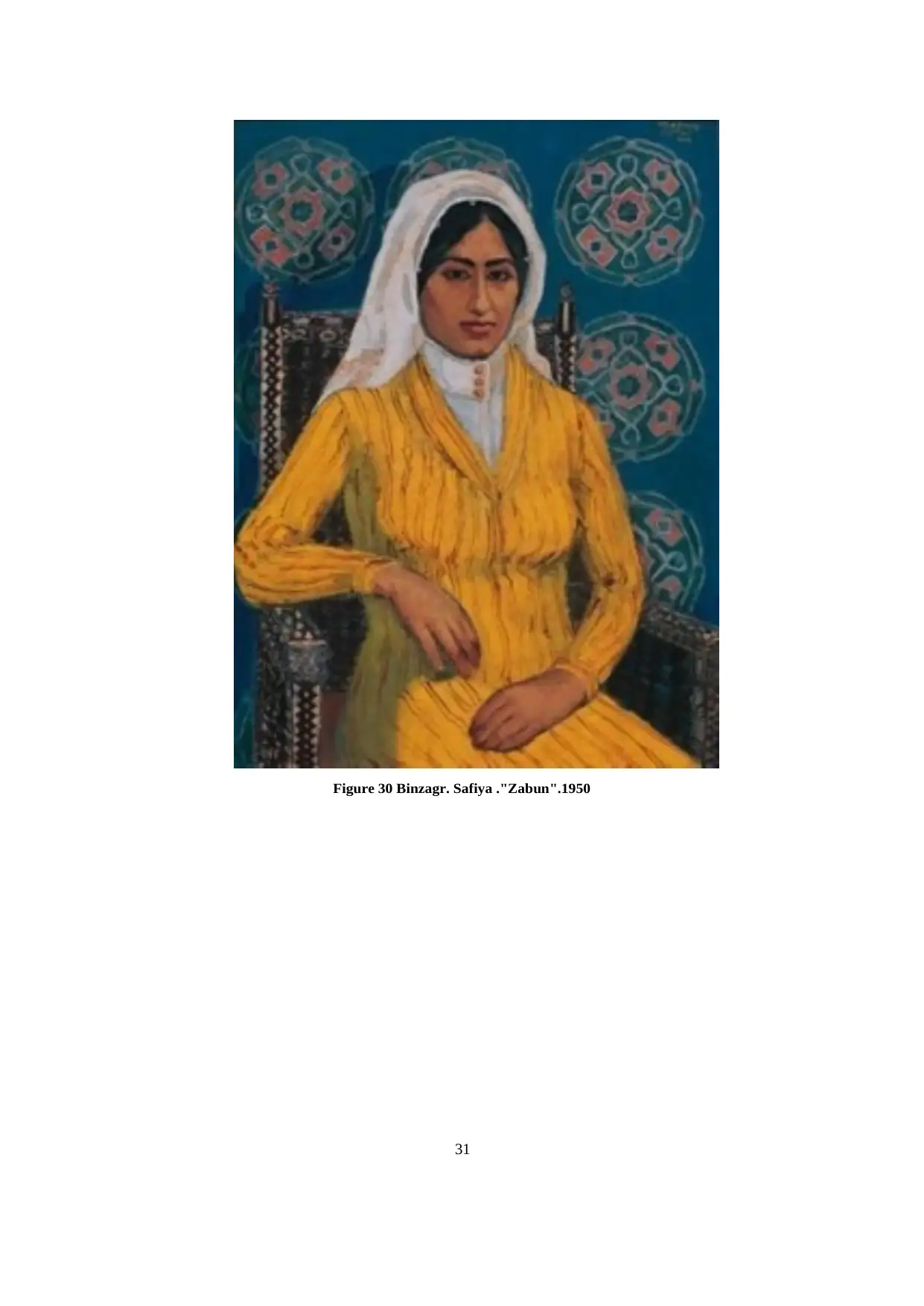
Figure 30 Binzagr. Safiya ."Zabun".1950
31
31

Female academic artist, Eiman Elgibreen (B. 1981)
Figure 31 Eiman Elgibreen
Figure 32 Does A Face Make a Difference? Mixed media on limestone bricks.Overall size: 60x200x100 cm. Private
collection / Courtesy of the Artist
21st century representation of women in Saudi Arabian art has been associated with
another woman artist Eiman Elgibreen. She represents the new generation of female artists who
have been taught and educated about art forms, and holds a profound consideration of the purpose
of art as an instrument of awareness about the changing society. Elgibreen’s art and academic
research challenges and debunks the numerous stereotypes the world maintains on Saudi women,
culture, tradition etc. She eloquently does this by partaking some of the hidden aspects of her
country thereby making her art unique. She serves as an inspiration to all Saudi artists who not
only want to pursue art but also shine in the field of international boundaries. Her works
challenges many stereotypes associated with Saudi women and Saudi culture in general. She does
this by sharing some of the unrevealed aspects of the society. She instigates an ideological
dialogue and promotes some form of tolerance towards cultural differences.
32
Figure 31 Eiman Elgibreen
Figure 32 Does A Face Make a Difference? Mixed media on limestone bricks.Overall size: 60x200x100 cm. Private
collection / Courtesy of the Artist
21st century representation of women in Saudi Arabian art has been associated with
another woman artist Eiman Elgibreen. She represents the new generation of female artists who
have been taught and educated about art forms, and holds a profound consideration of the purpose
of art as an instrument of awareness about the changing society. Elgibreen’s art and academic
research challenges and debunks the numerous stereotypes the world maintains on Saudi women,
culture, tradition etc. She eloquently does this by partaking some of the hidden aspects of her
country thereby making her art unique. She serves as an inspiration to all Saudi artists who not
only want to pursue art but also shine in the field of international boundaries. Her works
challenges many stereotypes associated with Saudi women and Saudi culture in general. She does
this by sharing some of the unrevealed aspects of the society. She instigates an ideological
dialogue and promotes some form of tolerance towards cultural differences.
32
Secure Best Marks with AI Grader
Need help grading? Try our AI Grader for instant feedback on your assignments.

Figure 33 Eiman Elgibreen, What Are You Looking at? Mixed media on wood. 32x36.cm. Private collection
2. Female artist from the middle East
The book, Women in the Middle East: Past and present, written by Nikki Keddie, states
that in the process of categorizing outstanding individuals in the society, women definitely fall in
this category30. In her book, Keddie focuses on the history of women from the Middle East. She
asserts that most of the women (who are artists in different fields like education, art, photography,
filming) particularly the likes of Shirin Neshat (Iran), Boushra Almutawakel (Yemen) are key to
social development. Their area of specialization, when it comes to women empowerment and
inspiration, falls largely on femininity. They tackle the issue of femininity from different angles
like sexuality and identity of Muslim women and the thing that is common in all of their efforts is
to advocate for motivation. Besides, in her book, Keddie presents a summary of the past history of
Saudi women, as well as the present developments that have occurred in their lives. Keddie
discusses the role of changing Islam with cultural, socioeconomic and political developments, and
also shows the idea of male superiority in Islam. She challenges such superiority and breaks the
notion that Islamic women are victims and assesses their role in the development of socialist,
nationalist and Islamist movements.
30 Press.princeton.edu. 2017. "Women In The Middle East". Princeton University Press.
https://press.princeton.edu/titles/8281.html.
33
2. Female artist from the middle East
The book, Women in the Middle East: Past and present, written by Nikki Keddie, states
that in the process of categorizing outstanding individuals in the society, women definitely fall in
this category30. In her book, Keddie focuses on the history of women from the Middle East. She
asserts that most of the women (who are artists in different fields like education, art, photography,
filming) particularly the likes of Shirin Neshat (Iran), Boushra Almutawakel (Yemen) are key to
social development. Their area of specialization, when it comes to women empowerment and
inspiration, falls largely on femininity. They tackle the issue of femininity from different angles
like sexuality and identity of Muslim women and the thing that is common in all of their efforts is
to advocate for motivation. Besides, in her book, Keddie presents a summary of the past history of
Saudi women, as well as the present developments that have occurred in their lives. Keddie
discusses the role of changing Islam with cultural, socioeconomic and political developments, and
also shows the idea of male superiority in Islam. She challenges such superiority and breaks the
notion that Islamic women are victims and assesses their role in the development of socialist,
nationalist and Islamist movements.
30 Press.princeton.edu. 2017. "Women In The Middle East". Princeton University Press.
https://press.princeton.edu/titles/8281.html.
33
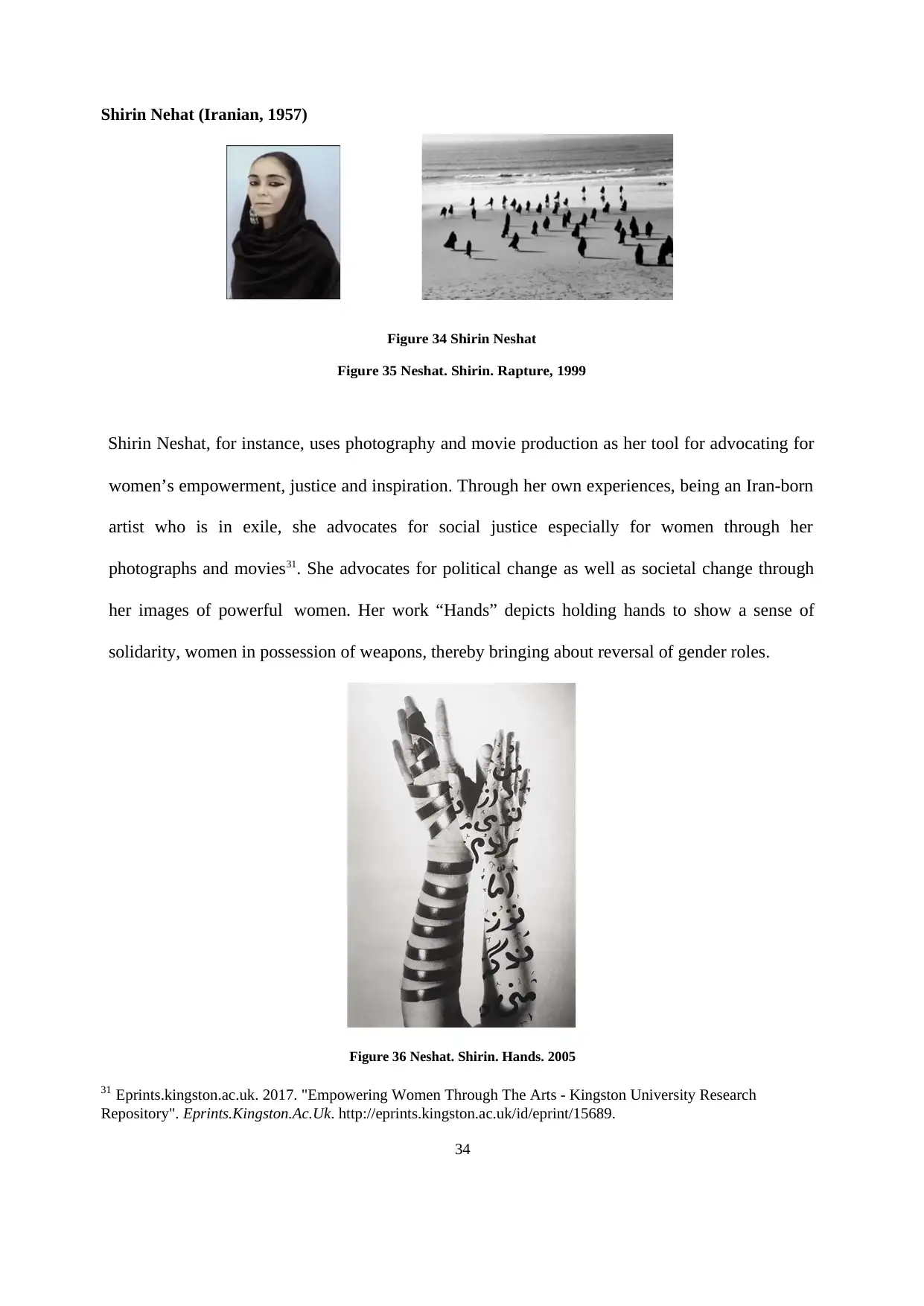
Shirin Nehat (Iranian, 1957)
Figure 34 Shirin Neshat
Figure 35 Neshat. Shirin. Rapture, 1999
Shirin Neshat, for instance, uses photography and movie production as her tool for advocating for
women’s empowerment, justice and inspiration. Through her own experiences, being an Iran-born
artist who is in exile, she advocates for social justice especially for women through her
photographs and movies31. She advocates for political change as well as societal change through
her images of powerful women. Her work “Hands” depicts holding hands to show a sense of
solidarity, women in possession of weapons, thereby bringing about reversal of gender roles.
Figure 36 Neshat. Shirin. Hands. 2005
31 Eprints.kingston.ac.uk. 2017. "Empowering Women Through The Arts - Kingston University Research
Repository". Eprints.Kingston.Ac.Uk. http://eprints.kingston.ac.uk/id/eprint/15689.
34
Figure 34 Shirin Neshat
Figure 35 Neshat. Shirin. Rapture, 1999
Shirin Neshat, for instance, uses photography and movie production as her tool for advocating for
women’s empowerment, justice and inspiration. Through her own experiences, being an Iran-born
artist who is in exile, she advocates for social justice especially for women through her
photographs and movies31. She advocates for political change as well as societal change through
her images of powerful women. Her work “Hands” depicts holding hands to show a sense of
solidarity, women in possession of weapons, thereby bringing about reversal of gender roles.
Figure 36 Neshat. Shirin. Hands. 2005
31 Eprints.kingston.ac.uk. 2017. "Empowering Women Through The Arts - Kingston University Research
Repository". Eprints.Kingston.Ac.Uk. http://eprints.kingston.ac.uk/id/eprint/15689.
34
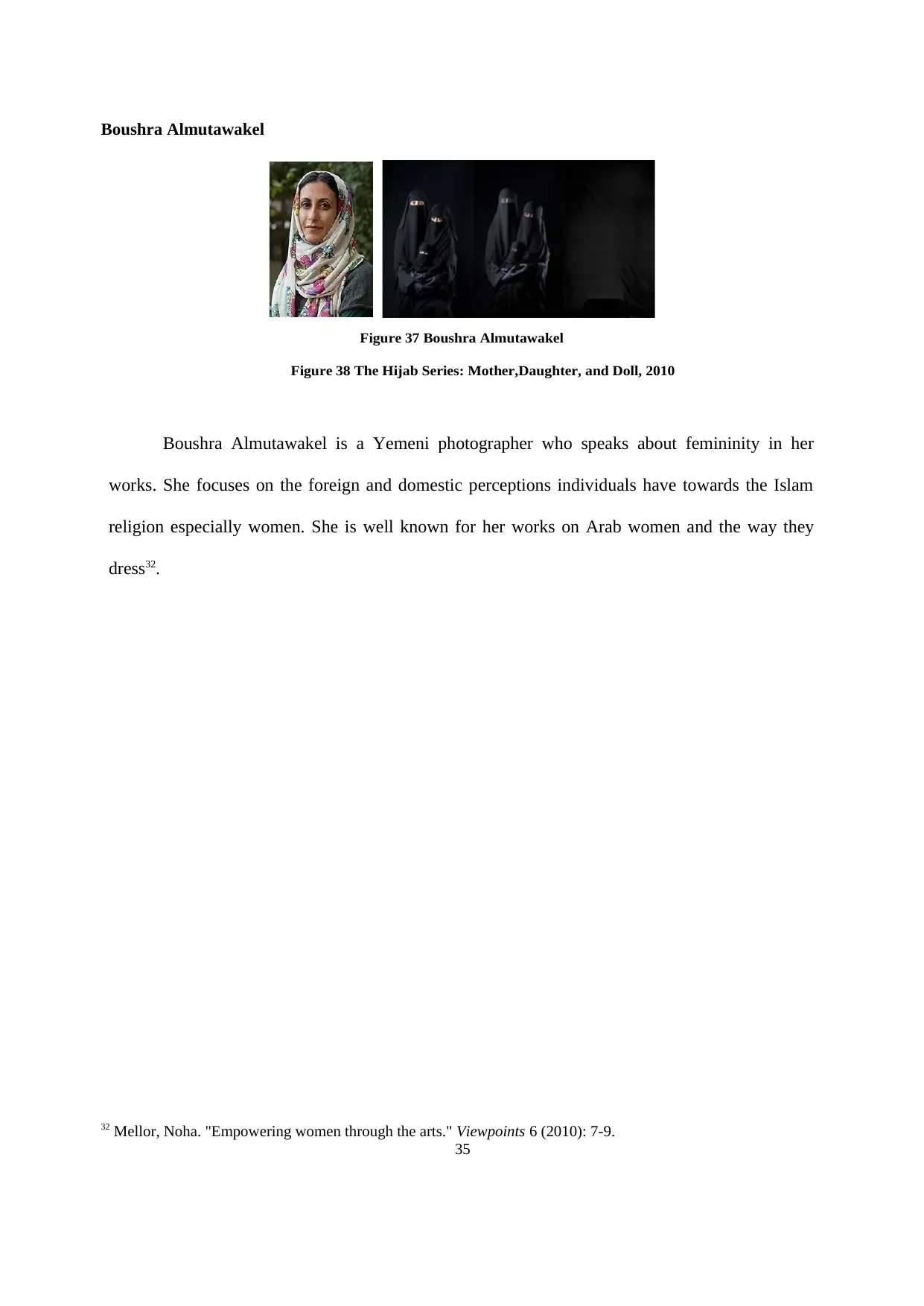
Boushra Almutawakel
Figure 37 Boushra Almutawakel
Figure 38 The Hijab Series: Mother,Daughter, and Doll, 2010
Boushra Almutawakel is a Yemeni photographer who speaks about femininity in her
works. She focuses on the foreign and domestic perceptions individuals have towards the Islam
religion especially women. She is well known for her works on Arab women and the way they
dress32.
32 Mellor, Noha. "Empowering women through the arts." Viewpoints 6 (2010): 7-9.
35
Figure 37 Boushra Almutawakel
Figure 38 The Hijab Series: Mother,Daughter, and Doll, 2010
Boushra Almutawakel is a Yemeni photographer who speaks about femininity in her
works. She focuses on the foreign and domestic perceptions individuals have towards the Islam
religion especially women. She is well known for her works on Arab women and the way they
dress32.
32 Mellor, Noha. "Empowering women through the arts." Viewpoints 6 (2010): 7-9.
35
Paraphrase This Document
Need a fresh take? Get an instant paraphrase of this document with our AI Paraphraser
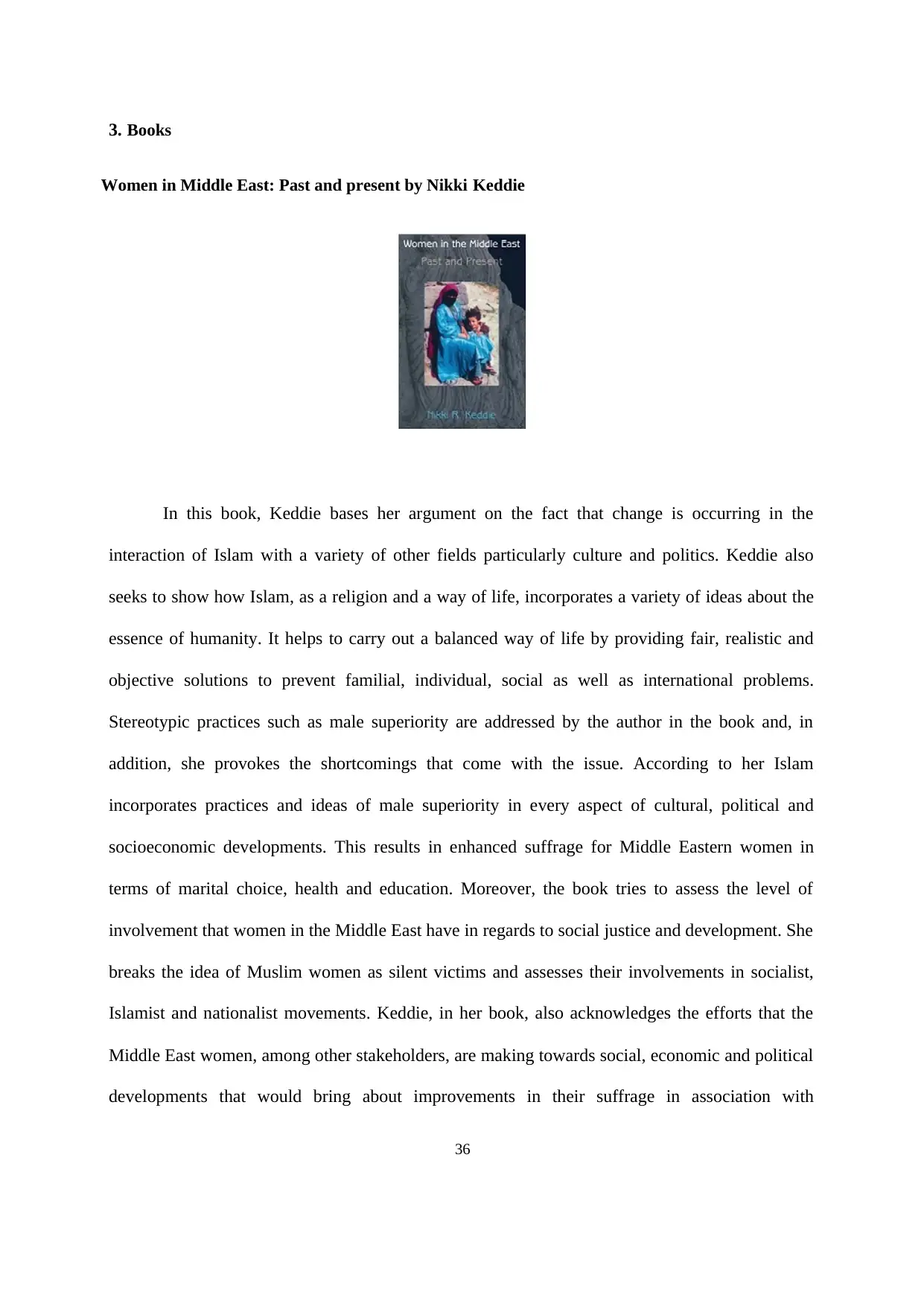
3. Books
Women in Middle East: Past and present by Nikki Keddie
In this book, Keddie bases her argument on the fact that change is occurring in the
interaction of Islam with a variety of other fields particularly culture and politics. Keddie also
seeks to show how Islam, as a religion and a way of life, incorporates a variety of ideas about the
essence of humanity. It helps to carry out a balanced way of life by providing fair, realistic and
objective solutions to prevent familial, individual, social as well as international problems.
Stereotypic practices such as male superiority are addressed by the author in the book and, in
addition, she provokes the shortcomings that come with the issue. According to her Islam
incorporates practices and ideas of male superiority in every aspect of cultural, political and
socioeconomic developments. This results in enhanced suffrage for Middle Eastern women in
terms of marital choice, health and education. Moreover, the book tries to assess the level of
involvement that women in the Middle East have in regards to social justice and development. She
breaks the idea of Muslim women as silent victims and assesses their involvements in socialist,
Islamist and nationalist movements. Keddie, in her book, also acknowledges the efforts that the
Middle East women, among other stakeholders, are making towards social, economic and political
developments that would bring about improvements in their suffrage in association with
36
Women in Middle East: Past and present by Nikki Keddie
In this book, Keddie bases her argument on the fact that change is occurring in the
interaction of Islam with a variety of other fields particularly culture and politics. Keddie also
seeks to show how Islam, as a religion and a way of life, incorporates a variety of ideas about the
essence of humanity. It helps to carry out a balanced way of life by providing fair, realistic and
objective solutions to prevent familial, individual, social as well as international problems.
Stereotypic practices such as male superiority are addressed by the author in the book and, in
addition, she provokes the shortcomings that come with the issue. According to her Islam
incorporates practices and ideas of male superiority in every aspect of cultural, political and
socioeconomic developments. This results in enhanced suffrage for Middle Eastern women in
terms of marital choice, health and education. Moreover, the book tries to assess the level of
involvement that women in the Middle East have in regards to social justice and development. She
breaks the idea of Muslim women as silent victims and assesses their involvements in socialist,
Islamist and nationalist movements. Keddie, in her book, also acknowledges the efforts that the
Middle East women, among other stakeholders, are making towards social, economic and political
developments that would bring about improvements in their suffrage in association with
36

knowledge, marriage decisions and health outcomes33.
Arab Women: Between defiance and Restraint by Suhasabbagh
The author of this book, Suba Sabbagh, addresses the challenges that women, particularly
in Arab nations, are facing. According to the book, although a lot needs to be done, Sabbagh
acknowledges the fact that there has been significant improvement in some of the issues such as
healthcare status, and political rights for women34. The book seeks to give a critical analysis of the
four issues (poverty, illiteracy, political repression and patriarchy) that Islamic women face and
the challenges (poor education, gender and sexual oppression, gender inequality) that the issues
bring about. One of the other issues, which the book addresses are employment and legal status,
which affect women socially and financially in the Middle East. However, according to Sabbagh,
the intensity of these issues varies from nation to nation like in United States, Egypt, among
others.
33 Sharkey, Heather, ed. Cultural Conversions: Unexpected Consequences of Christian Missionary Encounters in
the Middle East, Africa, and South Asia. Syracuse University Press, 2013.
34 Sabbagh, Suha. "Arab women between defiance and restraint." (1996).
37
Arab Women: Between defiance and Restraint by Suhasabbagh
The author of this book, Suba Sabbagh, addresses the challenges that women, particularly
in Arab nations, are facing. According to the book, although a lot needs to be done, Sabbagh
acknowledges the fact that there has been significant improvement in some of the issues such as
healthcare status, and political rights for women34. The book seeks to give a critical analysis of the
four issues (poverty, illiteracy, political repression and patriarchy) that Islamic women face and
the challenges (poor education, gender and sexual oppression, gender inequality) that the issues
bring about. One of the other issues, which the book addresses are employment and legal status,
which affect women socially and financially in the Middle East. However, according to Sabbagh,
the intensity of these issues varies from nation to nation like in United States, Egypt, among
others.
33 Sharkey, Heather, ed. Cultural Conversions: Unexpected Consequences of Christian Missionary Encounters in
the Middle East, Africa, and South Asia. Syracuse University Press, 2013.
34 Sabbagh, Suha. "Arab women between defiance and restraint." (1996).
37
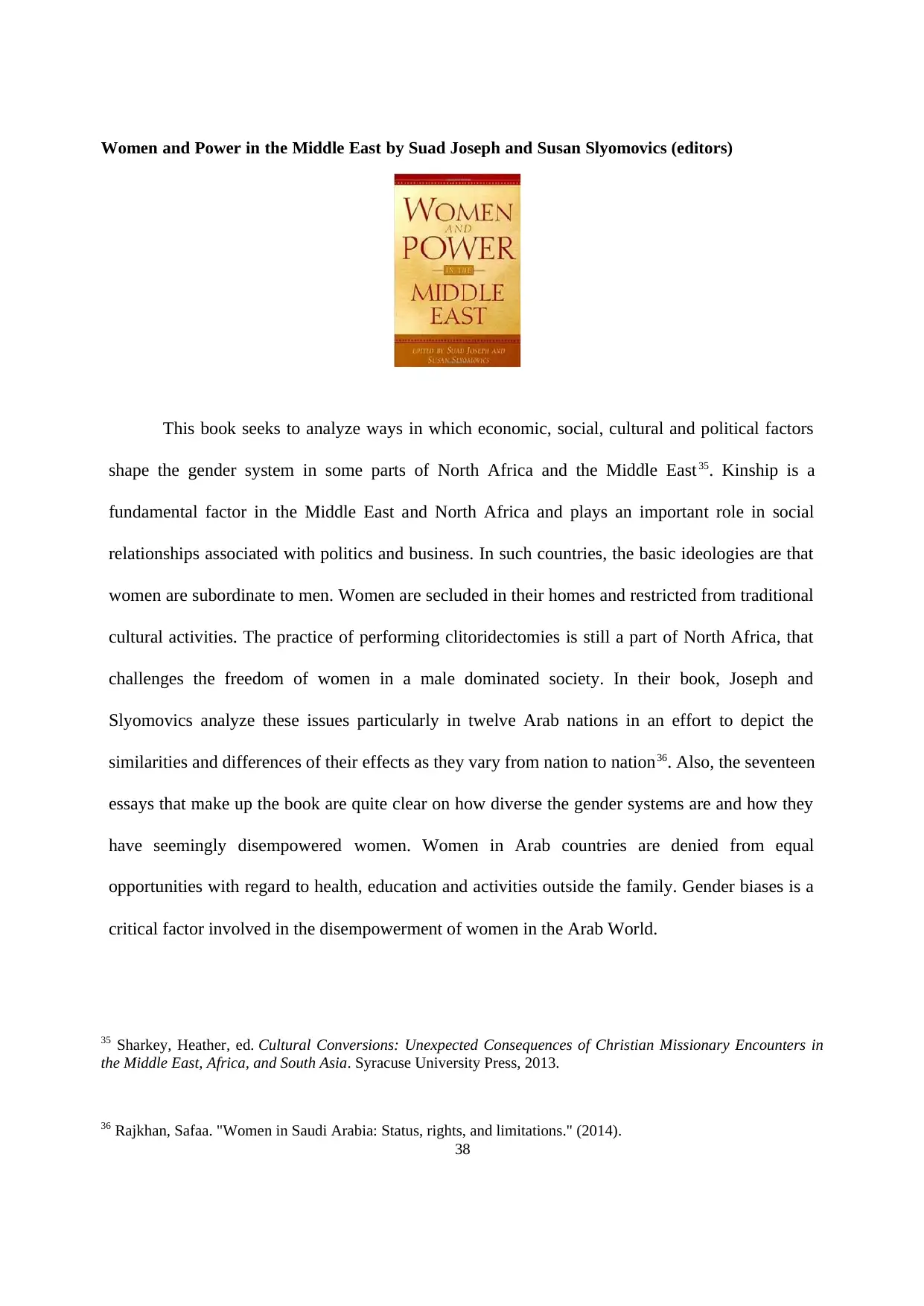
Women and Power in the Middle East by Suad Joseph and Susan Slyomovics (editors)
This book seeks to analyze ways in which economic, social, cultural and political factors
shape the gender system in some parts of North Africa and the Middle East 35. Kinship is a
fundamental factor in the Middle East and North Africa and plays an important role in social
relationships associated with politics and business. In such countries, the basic ideologies are that
women are subordinate to men. Women are secluded in their homes and restricted from traditional
cultural activities. The practice of performing clitoridectomies is still a part of North Africa, that
challenges the freedom of women in a male dominated society. In their book, Joseph and
Slyomovics analyze these issues particularly in twelve Arab nations in an effort to depict the
similarities and differences of their effects as they vary from nation to nation36. Also, the seventeen
essays that make up the book are quite clear on how diverse the gender systems are and how they
have seemingly disempowered women. Women in Arab countries are denied from equal
opportunities with regard to health, education and activities outside the family. Gender biases is a
critical factor involved in the disempowerment of women in the Arab World.
35 Sharkey, Heather, ed. Cultural Conversions: Unexpected Consequences of Christian Missionary Encounters in
the Middle East, Africa, and South Asia. Syracuse University Press, 2013.
36 Rajkhan, Safaa. "Women in Saudi Arabia: Status, rights, and limitations." (2014).
38
This book seeks to analyze ways in which economic, social, cultural and political factors
shape the gender system in some parts of North Africa and the Middle East 35. Kinship is a
fundamental factor in the Middle East and North Africa and plays an important role in social
relationships associated with politics and business. In such countries, the basic ideologies are that
women are subordinate to men. Women are secluded in their homes and restricted from traditional
cultural activities. The practice of performing clitoridectomies is still a part of North Africa, that
challenges the freedom of women in a male dominated society. In their book, Joseph and
Slyomovics analyze these issues particularly in twelve Arab nations in an effort to depict the
similarities and differences of their effects as they vary from nation to nation36. Also, the seventeen
essays that make up the book are quite clear on how diverse the gender systems are and how they
have seemingly disempowered women. Women in Arab countries are denied from equal
opportunities with regard to health, education and activities outside the family. Gender biases is a
critical factor involved in the disempowerment of women in the Arab World.
35 Sharkey, Heather, ed. Cultural Conversions: Unexpected Consequences of Christian Missionary Encounters in
the Middle East, Africa, and South Asia. Syracuse University Press, 2013.
36 Rajkhan, Safaa. "Women in Saudi Arabia: Status, rights, and limitations." (2014).
38
Secure Best Marks with AI Grader
Need help grading? Try our AI Grader for instant feedback on your assignments.
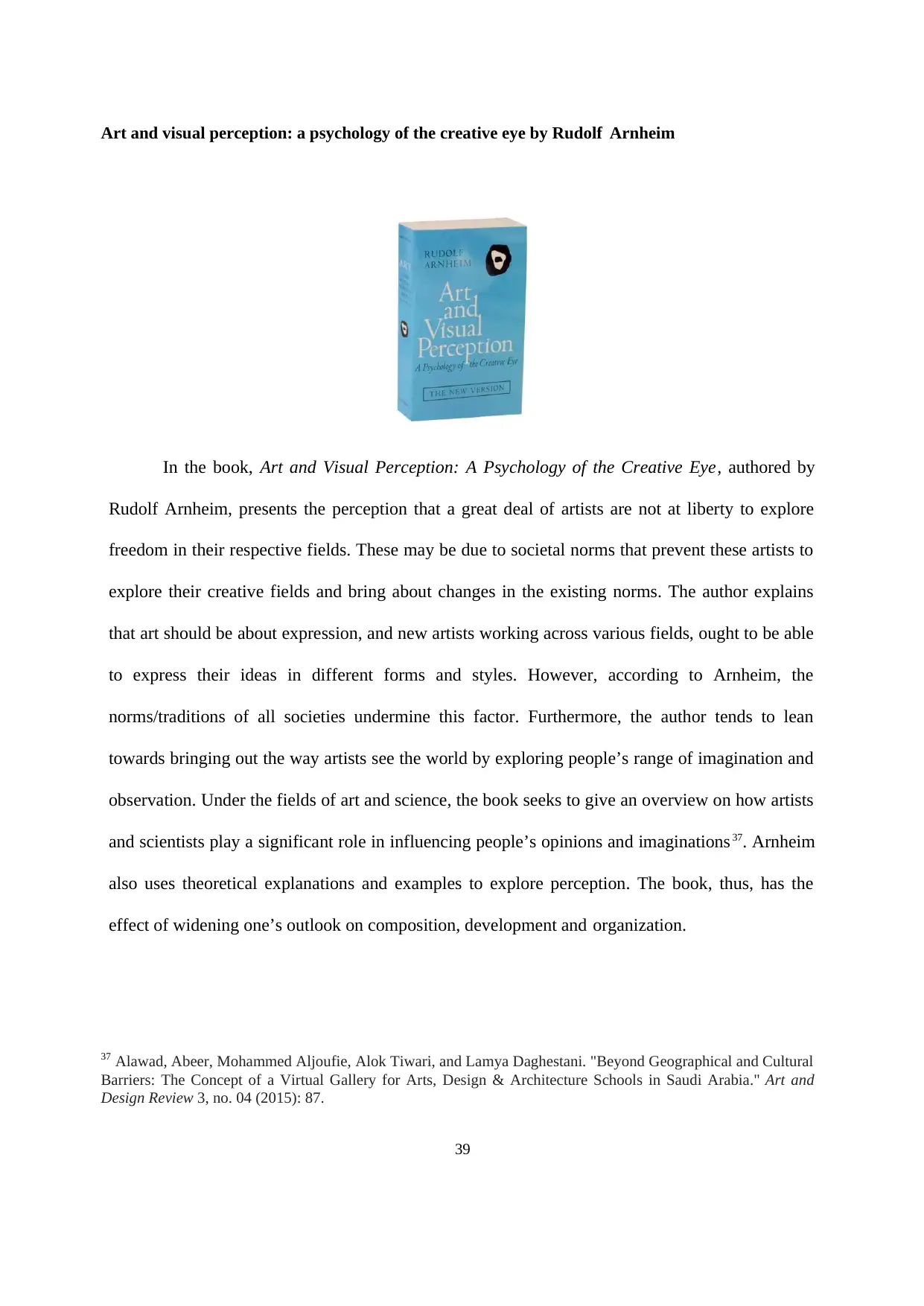
Art and visual perception: a psychology of the creative eye by Rudolf Arnheim
In the book, Art and Visual Perception: A Psychology of the Creative Eye, authored by
Rudolf Arnheim, presents the perception that a great deal of artists are not at liberty to explore
freedom in their respective fields. These may be due to societal norms that prevent these artists to
explore their creative fields and bring about changes in the existing norms. The author explains
that art should be about expression, and new artists working across various fields, ought to be able
to express their ideas in different forms and styles. However, according to Arnheim, the
norms/traditions of all societies undermine this factor. Furthermore, the author tends to lean
towards bringing out the way artists see the world by exploring people’s range of imagination and
observation. Under the fields of art and science, the book seeks to give an overview on how artists
and scientists play a significant role in influencing people’s opinions and imaginations 37. Arnheim
also uses theoretical explanations and examples to explore perception. The book, thus, has the
effect of widening one’s outlook on composition, development and organization.
37 Alawad, Abeer, Mohammed Aljoufie, Alok Tiwari, and Lamya Daghestani. "Beyond Geographical and Cultural
Barriers: The Concept of a Virtual Gallery for Arts, Design & Architecture Schools in Saudi Arabia." Art and
Design Review 3, no. 04 (2015): 87.
39
In the book, Art and Visual Perception: A Psychology of the Creative Eye, authored by
Rudolf Arnheim, presents the perception that a great deal of artists are not at liberty to explore
freedom in their respective fields. These may be due to societal norms that prevent these artists to
explore their creative fields and bring about changes in the existing norms. The author explains
that art should be about expression, and new artists working across various fields, ought to be able
to express their ideas in different forms and styles. However, according to Arnheim, the
norms/traditions of all societies undermine this factor. Furthermore, the author tends to lean
towards bringing out the way artists see the world by exploring people’s range of imagination and
observation. Under the fields of art and science, the book seeks to give an overview on how artists
and scientists play a significant role in influencing people’s opinions and imaginations 37. Arnheim
also uses theoretical explanations and examples to explore perception. The book, thus, has the
effect of widening one’s outlook on composition, development and organization.
37 Alawad, Abeer, Mohammed Aljoufie, Alok Tiwari, and Lamya Daghestani. "Beyond Geographical and Cultural
Barriers: The Concept of a Virtual Gallery for Arts, Design & Architecture Schools in Saudi Arabia." Art and
Design Review 3, no. 04 (2015): 87.
39
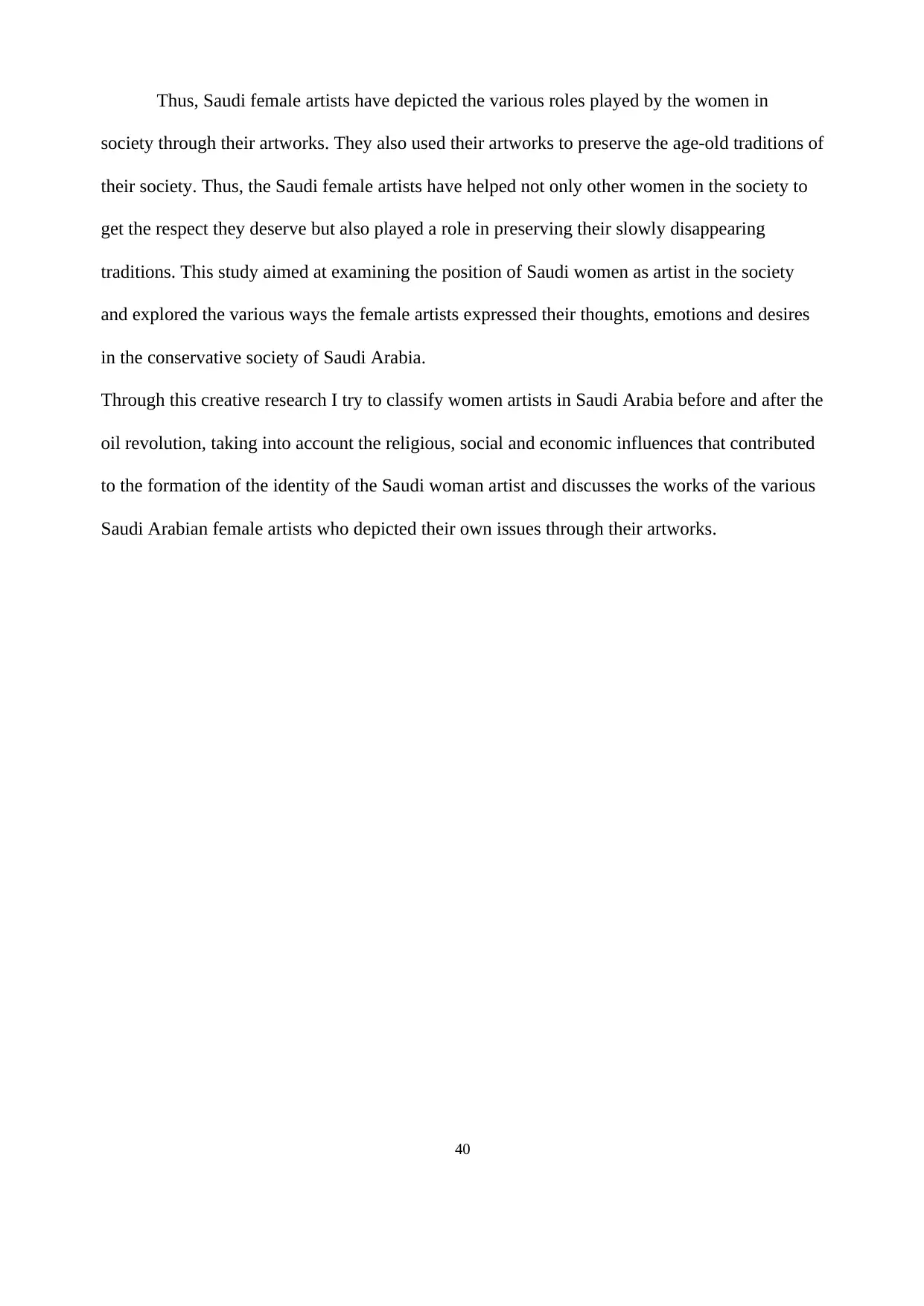
Thus, Saudi female artists have depicted the various roles played by the women in
society through their artworks. They also used their artworks to preserve the age-old traditions of
their society. Thus, the Saudi female artists have helped not only other women in the society to
get the respect they deserve but also played a role in preserving their slowly disappearing
traditions. This study aimed at examining the position of Saudi women as artist in the society
and explored the various ways the female artists expressed their thoughts, emotions and desires
in the conservative society of Saudi Arabia.
Through this creative research I try to classify women artists in Saudi Arabia before and after the
oil revolution, taking into account the religious, social and economic influences that contributed
to the formation of the identity of the Saudi woman artist and discusses the works of the various
Saudi Arabian female artists who depicted their own issues through their artworks.
40
society through their artworks. They also used their artworks to preserve the age-old traditions of
their society. Thus, the Saudi female artists have helped not only other women in the society to
get the respect they deserve but also played a role in preserving their slowly disappearing
traditions. This study aimed at examining the position of Saudi women as artist in the society
and explored the various ways the female artists expressed their thoughts, emotions and desires
in the conservative society of Saudi Arabia.
Through this creative research I try to classify women artists in Saudi Arabia before and after the
oil revolution, taking into account the religious, social and economic influences that contributed
to the formation of the identity of the Saudi woman artist and discusses the works of the various
Saudi Arabian female artists who depicted their own issues through their artworks.
40
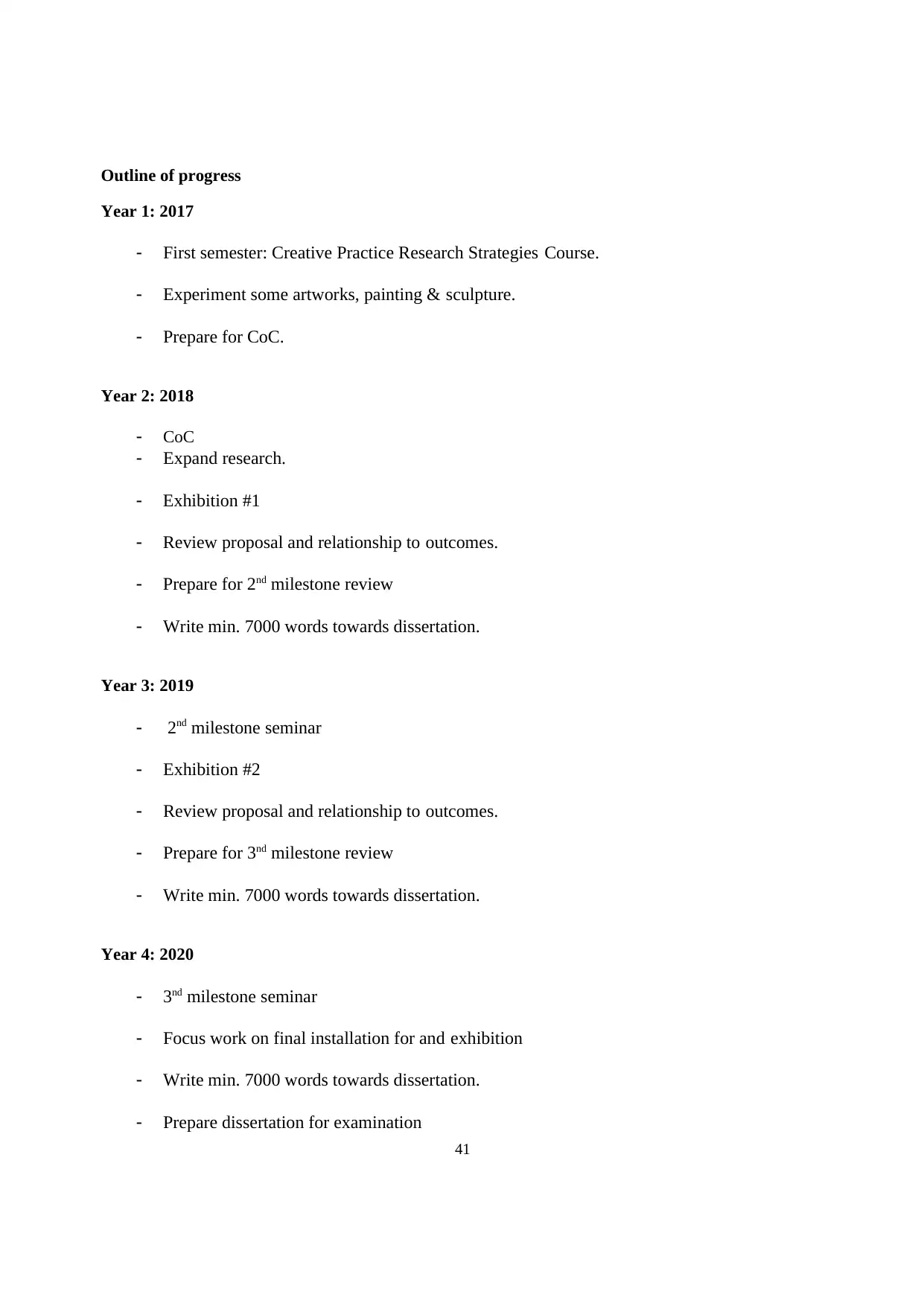
Outline of progress
Year 1: 2017
‐ First semester: Creative Practice Research Strategies Course.
‐ Experiment some artworks, painting & sculpture.
‐ Prepare for CoC.
Year 2: 2018
‐ CoC
‐ Expand research.
‐ Exhibition #1
‐ Review proposal and relationship to outcomes.
‐ Prepare for 2nd milestone review
‐ Write min. 7000 words towards dissertation.
Year 3: 2019
‐ 2nd milestone seminar
‐ Exhibition #2
‐ Review proposal and relationship to outcomes.
‐ Prepare for 3nd milestone review
‐ Write min. 7000 words towards dissertation.
Year 4: 2020
‐ 3nd milestone seminar
‐ Focus work on final installation for and exhibition
‐ Write min. 7000 words towards dissertation.
‐ Prepare dissertation for examination
41
Year 1: 2017
‐ First semester: Creative Practice Research Strategies Course.
‐ Experiment some artworks, painting & sculpture.
‐ Prepare for CoC.
Year 2: 2018
‐ CoC
‐ Expand research.
‐ Exhibition #1
‐ Review proposal and relationship to outcomes.
‐ Prepare for 2nd milestone review
‐ Write min. 7000 words towards dissertation.
Year 3: 2019
‐ 2nd milestone seminar
‐ Exhibition #2
‐ Review proposal and relationship to outcomes.
‐ Prepare for 3nd milestone review
‐ Write min. 7000 words towards dissertation.
Year 4: 2020
‐ 3nd milestone seminar
‐ Focus work on final installation for and exhibition
‐ Write min. 7000 words towards dissertation.
‐ Prepare dissertation for examination
41
Paraphrase This Document
Need a fresh take? Get an instant paraphrase of this document with our AI Paraphraser
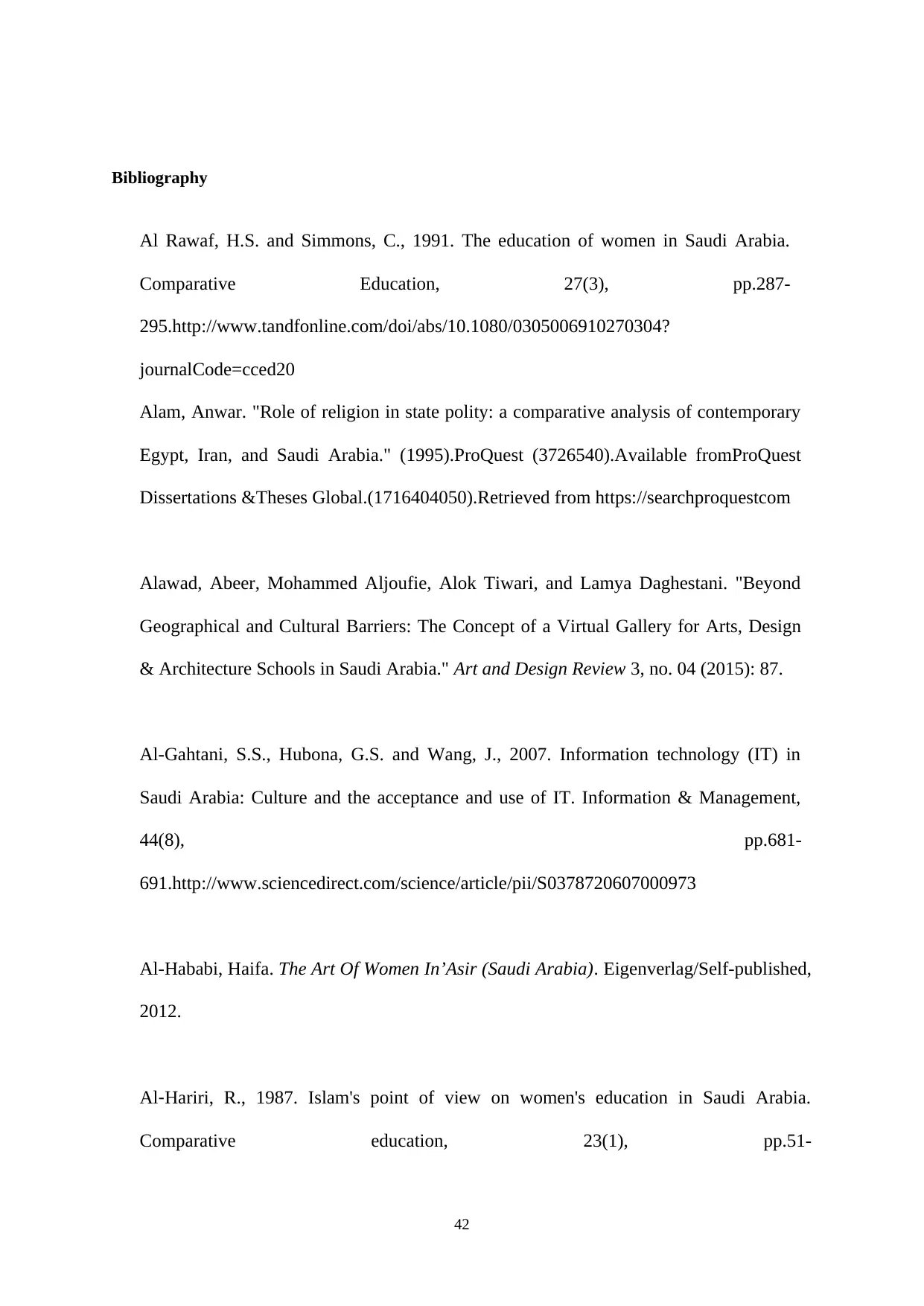
Bibliography
Al Rawaf, H.S. and Simmons, C., 1991. The education of women in Saudi Arabia.
Comparative Education, 27(3), pp.287-
295.http://www.tandfonline.com/doi/abs/10.1080/0305006910270304?
journalCode=cced20
Alam, Anwar. "Role of religion in state polity: a comparative analysis of contemporary
Egypt, Iran, and Saudi Arabia." (1995).ProQuest (3726540).Available fromProQuest
Dissertations &Theses Global.(1716404050).Retrieved from https://searchproquestcom
Alawad, Abeer, Mohammed Aljoufie, Alok Tiwari, and Lamya Daghestani. "Beyond
Geographical and Cultural Barriers: The Concept of a Virtual Gallery for Arts, Design
& Architecture Schools in Saudi Arabia." Art and Design Review 3, no. 04 (2015): 87.
Al-Gahtani, S.S., Hubona, G.S. and Wang, J., 2007. Information technology (IT) in
Saudi Arabia: Culture and the acceptance and use of IT. Information & Management,
44(8), pp.681-
691.http://www.sciencedirect.com/science/article/pii/S0378720607000973
Al-Hababi, Haifa. The Art Of Women In’Asir (Saudi Arabia). Eigenverlag/Self-published,
2012.
Al‐Hariri, R., 1987. Islam's point of view on women's education in Saudi Arabia.
Comparative education, 23(1), pp.51-
42
Al Rawaf, H.S. and Simmons, C., 1991. The education of women in Saudi Arabia.
Comparative Education, 27(3), pp.287-
295.http://www.tandfonline.com/doi/abs/10.1080/0305006910270304?
journalCode=cced20
Alam, Anwar. "Role of religion in state polity: a comparative analysis of contemporary
Egypt, Iran, and Saudi Arabia." (1995).ProQuest (3726540).Available fromProQuest
Dissertations &Theses Global.(1716404050).Retrieved from https://searchproquestcom
Alawad, Abeer, Mohammed Aljoufie, Alok Tiwari, and Lamya Daghestani. "Beyond
Geographical and Cultural Barriers: The Concept of a Virtual Gallery for Arts, Design
& Architecture Schools in Saudi Arabia." Art and Design Review 3, no. 04 (2015): 87.
Al-Gahtani, S.S., Hubona, G.S. and Wang, J., 2007. Information technology (IT) in
Saudi Arabia: Culture and the acceptance and use of IT. Information & Management,
44(8), pp.681-
691.http://www.sciencedirect.com/science/article/pii/S0378720607000973
Al-Hababi, Haifa. The Art Of Women In’Asir (Saudi Arabia). Eigenverlag/Self-published,
2012.
Al‐Hariri, R., 1987. Islam's point of view on women's education in Saudi Arabia.
Comparative education, 23(1), pp.51-
42
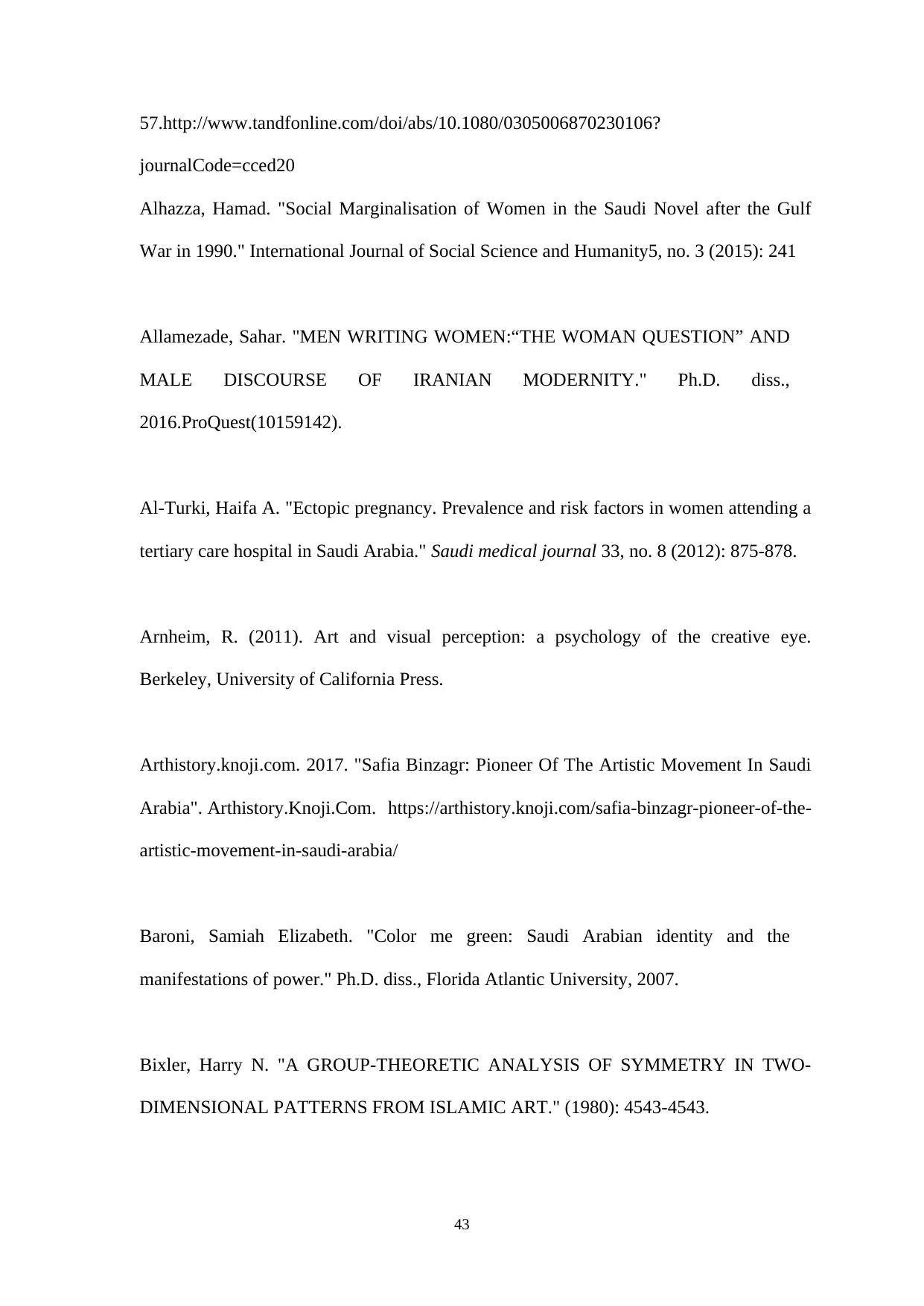
57.http://www.tandfonline.com/doi/abs/10.1080/0305006870230106?
journalCode=cced20
Alhazza, Hamad. "Social Marginalisation of Women in the Saudi Novel after the Gulf
War in 1990." International Journal of Social Science and Humanity5, no. 3 (2015): 241
Allamezade, Sahar. "MEN WRITING WOMEN:“THE WOMAN QUESTION” AND
MALE DISCOURSE OF IRANIAN MODERNITY." Ph.D. diss.,
2016.ProQuest(10159142).
Al-Turki, Haifa A. "Ectopic pregnancy. Prevalence and risk factors in women attending a
tertiary care hospital in Saudi Arabia." Saudi medical journal 33, no. 8 (2012): 875-878.
Arnheim, R. (2011). Art and visual perception: a psychology of the creative eye.
Berkeley, University of California Press.
Arthistory.knoji.com. 2017. "Safia Binzagr: Pioneer Of The Artistic Movement In Saudi
Arabia". Arthistory.Knoji.Com. https://arthistory.knoji.com/safia-binzagr-pioneer-of-the-
artistic-movement-in-saudi-arabia/
Baroni, Samiah Elizabeth. "Color me green: Saudi Arabian identity and the
manifestations of power." Ph.D. diss., Florida Atlantic University, 2007.
Bixler, Harry N. "A GROUP-THEORETIC ANALYSIS OF SYMMETRY IN TWO-
DIMENSIONAL PATTERNS FROM ISLAMIC ART." (1980): 4543-4543.
43
journalCode=cced20
Alhazza, Hamad. "Social Marginalisation of Women in the Saudi Novel after the Gulf
War in 1990." International Journal of Social Science and Humanity5, no. 3 (2015): 241
Allamezade, Sahar. "MEN WRITING WOMEN:“THE WOMAN QUESTION” AND
MALE DISCOURSE OF IRANIAN MODERNITY." Ph.D. diss.,
2016.ProQuest(10159142).
Al-Turki, Haifa A. "Ectopic pregnancy. Prevalence and risk factors in women attending a
tertiary care hospital in Saudi Arabia." Saudi medical journal 33, no. 8 (2012): 875-878.
Arnheim, R. (2011). Art and visual perception: a psychology of the creative eye.
Berkeley, University of California Press.
Arthistory.knoji.com. 2017. "Safia Binzagr: Pioneer Of The Artistic Movement In Saudi
Arabia". Arthistory.Knoji.Com. https://arthistory.knoji.com/safia-binzagr-pioneer-of-the-
artistic-movement-in-saudi-arabia/
Baroni, Samiah Elizabeth. "Color me green: Saudi Arabian identity and the
manifestations of power." Ph.D. diss., Florida Atlantic University, 2007.
Bixler, Harry N. "A GROUP-THEORETIC ANALYSIS OF SYMMETRY IN TWO-
DIMENSIONAL PATTERNS FROM ISLAMIC ART." (1980): 4543-4543.
43
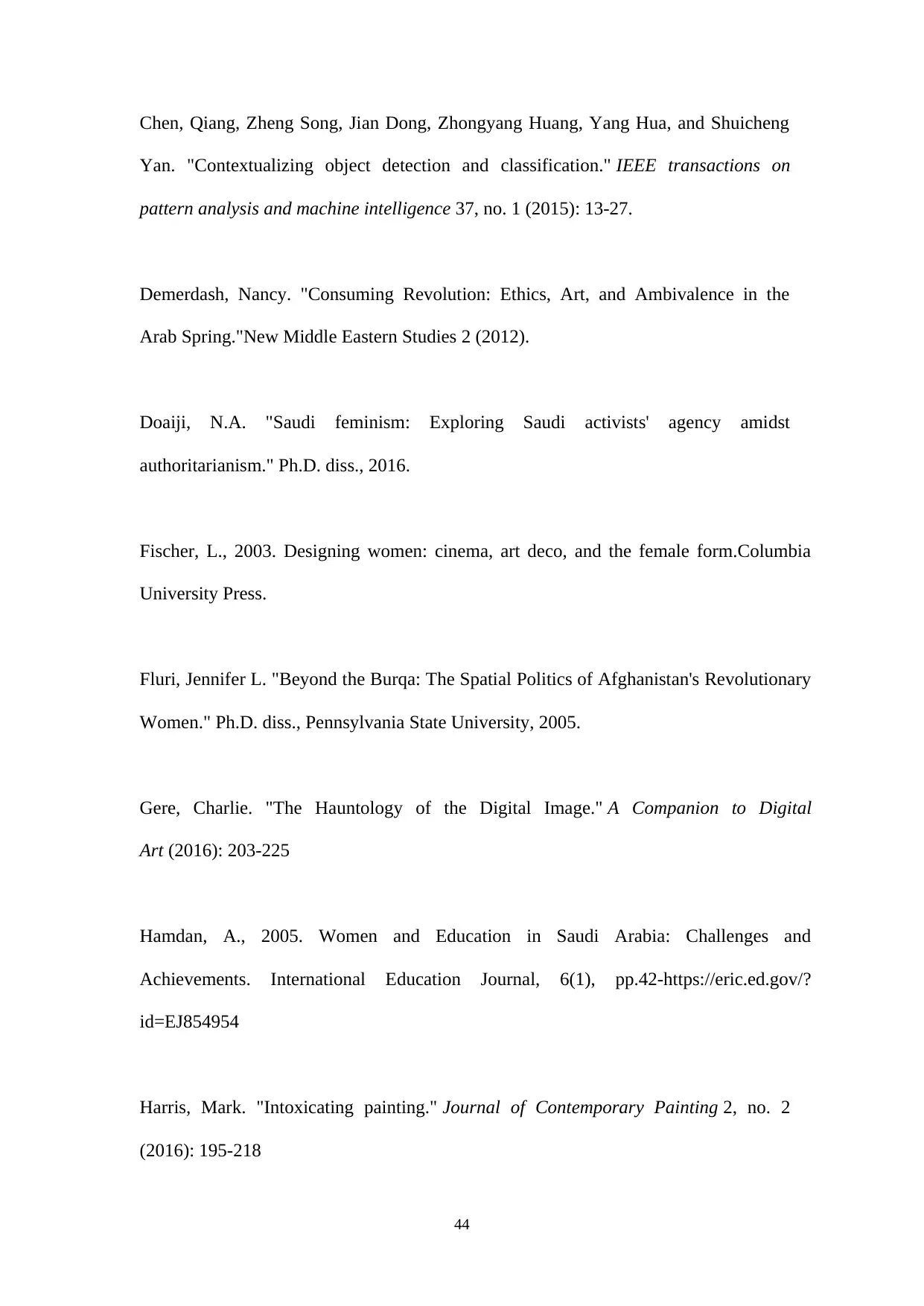
Chen, Qiang, Zheng Song, Jian Dong, Zhongyang Huang, Yang Hua, and Shuicheng
Yan. "Contextualizing object detection and classification." IEEE transactions on
pattern analysis and machine intelligence 37, no. 1 (2015): 13-27.
Demerdash, Nancy. "Consuming Revolution: Ethics, Art, and Ambivalence in the
Arab Spring."New Middle Eastern Studies 2 (2012).
Doaiji, N.A. "Saudi feminism: Exploring Saudi activists' agency amidst
authoritarianism." Ph.D. diss., 2016.
Fischer, L., 2003. Designing women: cinema, art deco, and the female form.Columbia
University Press.
Fluri, Jennifer L. "Beyond the Burqa: The Spatial Politics of Afghanistan's Revolutionary
Women." Ph.D. diss., Pennsylvania State University, 2005.
Gere, Charlie. "The Hauntology of the Digital Image." A Companion to Digital
Art (2016): 203-225
Hamdan, A., 2005. Women and Education in Saudi Arabia: Challenges and
Achievements. International Education Journal, 6(1), pp.42-https://eric.ed.gov/?
id=EJ854954
Harris, Mark. "Intoxicating painting." Journal of Contemporary Painting 2, no. 2
(2016): 195-218
44
Yan. "Contextualizing object detection and classification." IEEE transactions on
pattern analysis and machine intelligence 37, no. 1 (2015): 13-27.
Demerdash, Nancy. "Consuming Revolution: Ethics, Art, and Ambivalence in the
Arab Spring."New Middle Eastern Studies 2 (2012).
Doaiji, N.A. "Saudi feminism: Exploring Saudi activists' agency amidst
authoritarianism." Ph.D. diss., 2016.
Fischer, L., 2003. Designing women: cinema, art deco, and the female form.Columbia
University Press.
Fluri, Jennifer L. "Beyond the Burqa: The Spatial Politics of Afghanistan's Revolutionary
Women." Ph.D. diss., Pennsylvania State University, 2005.
Gere, Charlie. "The Hauntology of the Digital Image." A Companion to Digital
Art (2016): 203-225
Hamdan, A., 2005. Women and Education in Saudi Arabia: Challenges and
Achievements. International Education Journal, 6(1), pp.42-https://eric.ed.gov/?
id=EJ854954
Harris, Mark. "Intoxicating painting." Journal of Contemporary Painting 2, no. 2
(2016): 195-218
44
Secure Best Marks with AI Grader
Need help grading? Try our AI Grader for instant feedback on your assignments.
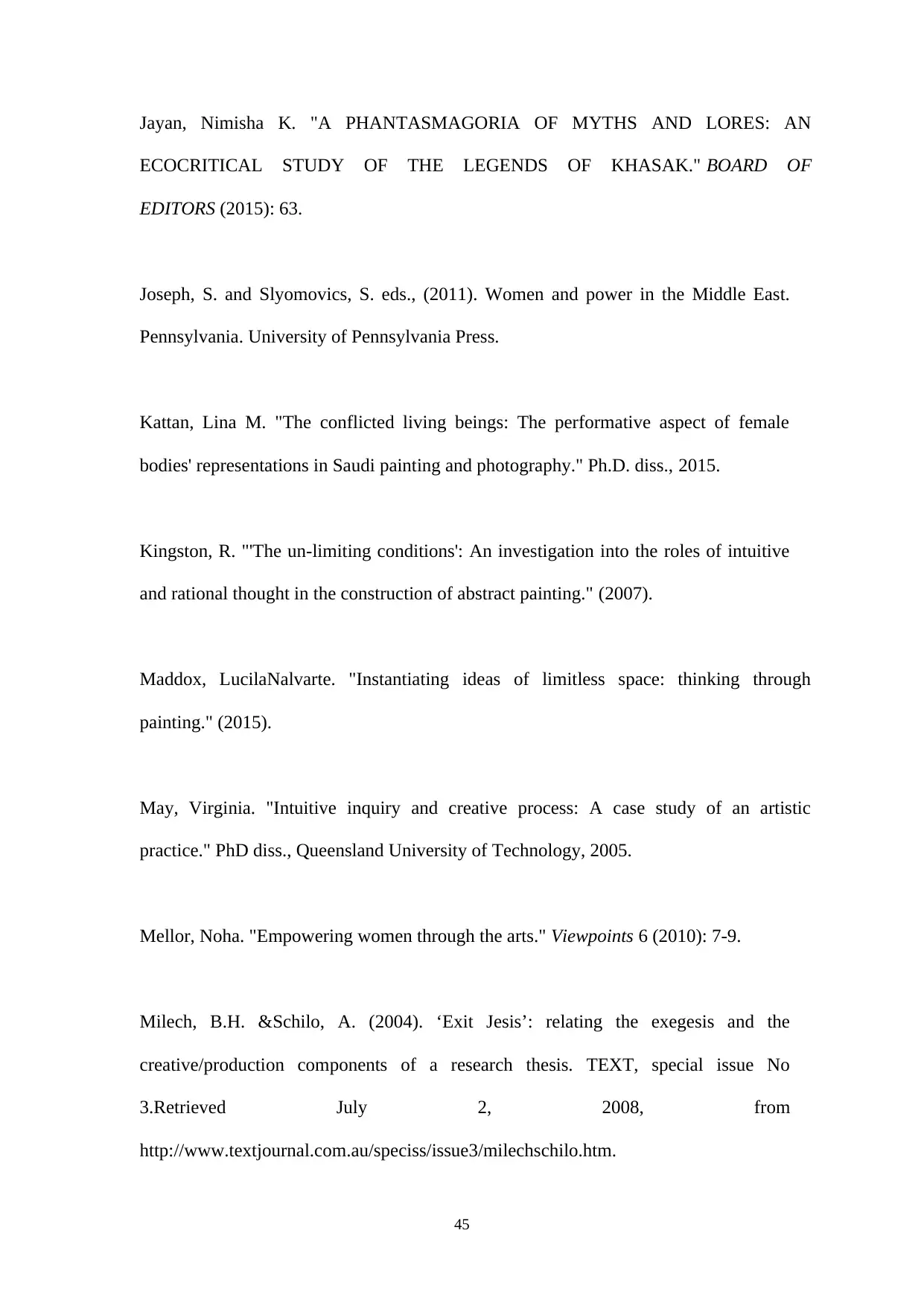
Jayan, Nimisha K. "A PHANTASMAGORIA OF MYTHS AND LORES: AN
ECOCRITICAL STUDY OF THE LEGENDS OF KHASAK." BOARD OF
EDITORS (2015): 63.
Joseph, S. and Slyomovics, S. eds., (2011). Women and power in the Middle East.
Pennsylvania. University of Pennsylvania Press.
Kattan, Lina M. "The conflicted living beings: The performative aspect of female
bodies' representations in Saudi painting and photography." Ph.D. diss., 2015.
Kingston, R. "'The un-limiting conditions': An investigation into the roles of intuitive
and rational thought in the construction of abstract painting." (2007).
Maddox, LucilaNalvarte. "Instantiating ideas of limitless space: thinking through
painting." (2015).
May, Virginia. "Intuitive inquiry and creative process: A case study of an artistic
practice." PhD diss., Queensland University of Technology, 2005.
Mellor, Noha. "Empowering women through the arts." Viewpoints 6 (2010): 7-9.
Milech, B.H. &Schilo, A. (2004). ‘Exit Jesis’: relating the exegesis and the
creative/production components of a research thesis. TEXT, special issue No
3.Retrieved July 2, 2008, from
http://www.textjournal.com.au/speciss/issue3/milechschilo.htm.
45
ECOCRITICAL STUDY OF THE LEGENDS OF KHASAK." BOARD OF
EDITORS (2015): 63.
Joseph, S. and Slyomovics, S. eds., (2011). Women and power in the Middle East.
Pennsylvania. University of Pennsylvania Press.
Kattan, Lina M. "The conflicted living beings: The performative aspect of female
bodies' representations in Saudi painting and photography." Ph.D. diss., 2015.
Kingston, R. "'The un-limiting conditions': An investigation into the roles of intuitive
and rational thought in the construction of abstract painting." (2007).
Maddox, LucilaNalvarte. "Instantiating ideas of limitless space: thinking through
painting." (2015).
May, Virginia. "Intuitive inquiry and creative process: A case study of an artistic
practice." PhD diss., Queensland University of Technology, 2005.
Mellor, Noha. "Empowering women through the arts." Viewpoints 6 (2010): 7-9.
Milech, B.H. &Schilo, A. (2004). ‘Exit Jesis’: relating the exegesis and the
creative/production components of a research thesis. TEXT, special issue No
3.Retrieved July 2, 2008, from
http://www.textjournal.com.au/speciss/issue3/milechschilo.htm.
45

Press.princeton.edu. 2017. "Women In The Middle East". Princeton University Press.
https://press.princeton.edu/titles/8281.html
ProQuest Dissertations &Theses Global.(1840197562).Retrieved from
https://searchproquestcom.ezproxy.lib.rmit.edu.au/docview/1840197562?accountid=
13552
Rajkhan, Safaa. "Women in Saudi Arabia: Status, rights, and limitations." (2014).
Sabbagh, Suha. "Arab women between defiance and restraint." (1996).
Sharkey, Heather, ed. Cultural Conversions: Unexpected Consequences of Christian
Missionary Encounters in the Middle East, Africa, and South Asia. Syracuse University
Press, 2013.
Taylor, Judith. "Enduring friendship: women's intimacies and the erotics of
survival." Frontiers: A Journal of Women Studies34, no. 1 (2013): 93-113.
Ttu-ir.tdl.org. 2017. "Cite A Website - Cite This For Me". Ttu-Ir.Tdl.Org. https://ttu-
ir.tdl.org/ttu-ir/bitstream/handle/2346/63583/KATTAN-DISSERTATION-2015.pdf?
sequence=1
Ulrichsen, Kristian Coates. "The Gulf and the Global Economy." In The Gulf States in
International Political Economy, pp. 15-35. Palgrave Macmillan UK, 2016.
46
https://press.princeton.edu/titles/8281.html
ProQuest Dissertations &Theses Global.(1840197562).Retrieved from
https://searchproquestcom.ezproxy.lib.rmit.edu.au/docview/1840197562?accountid=
13552
Rajkhan, Safaa. "Women in Saudi Arabia: Status, rights, and limitations." (2014).
Sabbagh, Suha. "Arab women between defiance and restraint." (1996).
Sharkey, Heather, ed. Cultural Conversions: Unexpected Consequences of Christian
Missionary Encounters in the Middle East, Africa, and South Asia. Syracuse University
Press, 2013.
Taylor, Judith. "Enduring friendship: women's intimacies and the erotics of
survival." Frontiers: A Journal of Women Studies34, no. 1 (2013): 93-113.
Ttu-ir.tdl.org. 2017. "Cite A Website - Cite This For Me". Ttu-Ir.Tdl.Org. https://ttu-
ir.tdl.org/ttu-ir/bitstream/handle/2346/63583/KATTAN-DISSERTATION-2015.pdf?
sequence=1
Ulrichsen, Kristian Coates. "The Gulf and the Global Economy." In The Gulf States in
International Political Economy, pp. 15-35. Palgrave Macmillan UK, 2016.
46
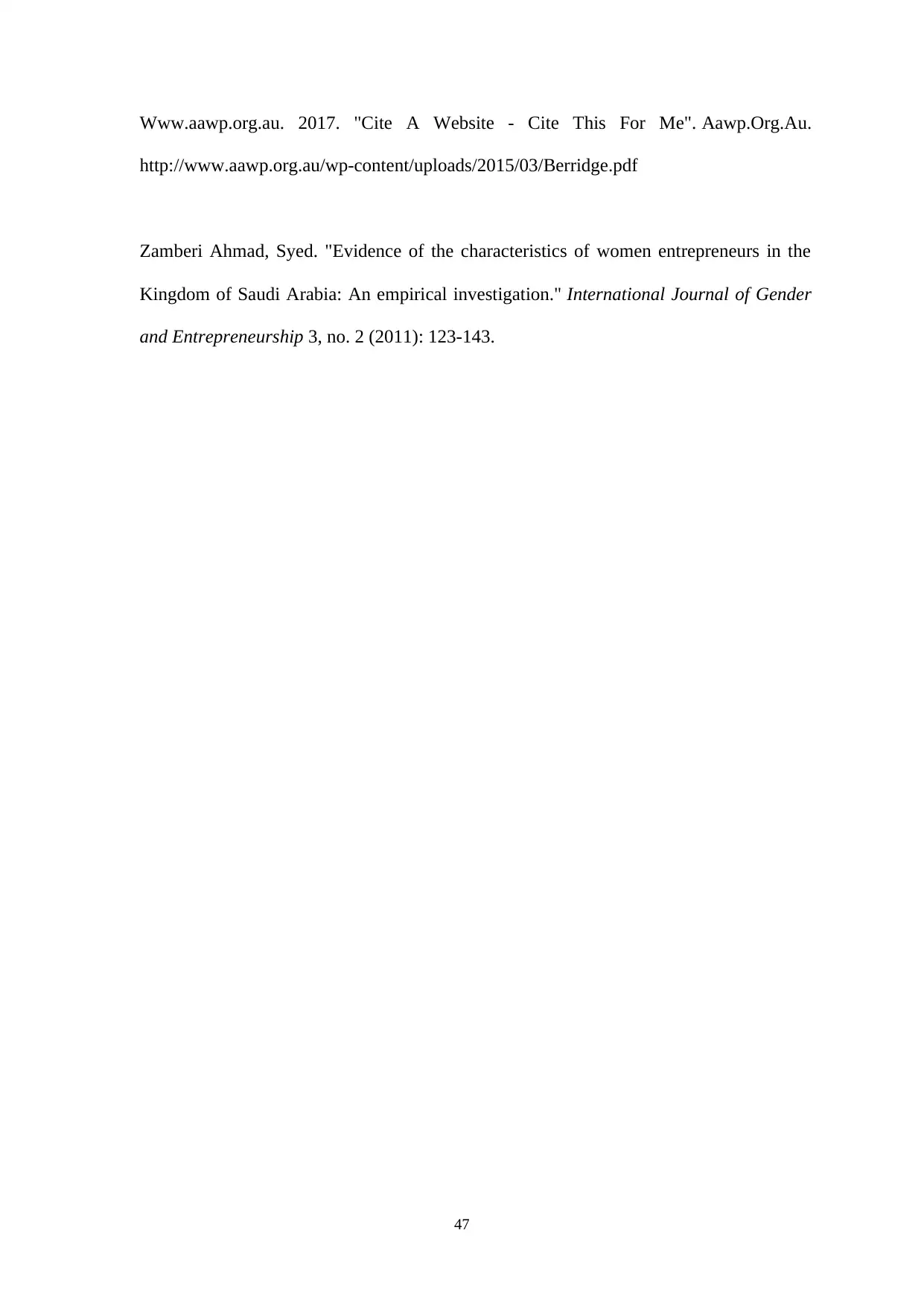
Www.aawp.org.au. 2017. "Cite A Website - Cite This For Me". Aawp.Org.Au.
http://www.aawp.org.au/wp-content/uploads/2015/03/Berridge.pdf
Zamberi Ahmad, Syed. "Evidence of the characteristics of women entrepreneurs in the
Kingdom of Saudi Arabia: An empirical investigation." International Journal of Gender
and Entrepreneurship 3, no. 2 (2011): 123-143.
47
http://www.aawp.org.au/wp-content/uploads/2015/03/Berridge.pdf
Zamberi Ahmad, Syed. "Evidence of the characteristics of women entrepreneurs in the
Kingdom of Saudi Arabia: An empirical investigation." International Journal of Gender
and Entrepreneurship 3, no. 2 (2011): 123-143.
47
1 out of 49
Your All-in-One AI-Powered Toolkit for Academic Success.
+13062052269
info@desklib.com
Available 24*7 on WhatsApp / Email
![[object Object]](/_next/static/media/star-bottom.7253800d.svg)
Unlock your academic potential
© 2024 | Zucol Services PVT LTD | All rights reserved.

